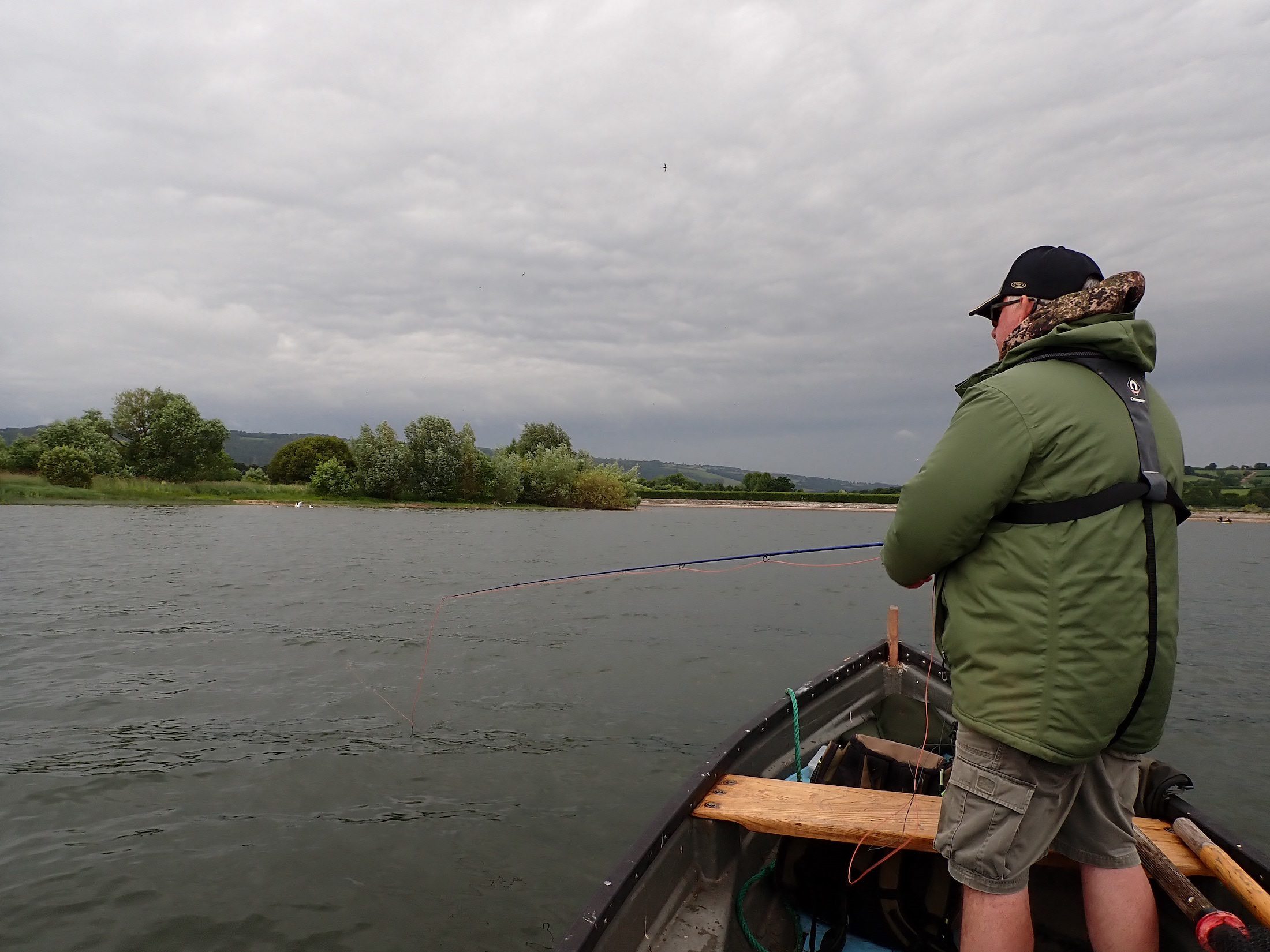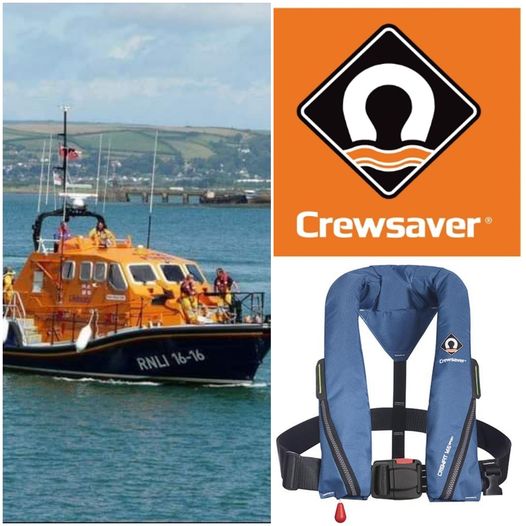
Summerlands – Promote Life Saving Jackets


 Mid October is a great time to venture out of Minehead with a wide range of opportunities on offer. I had booked onto Teddie Boy Charters with my son James Thomas, Rob Scoines and a friend from my working life Derek Walters. There were three other anglers already booked onto the boat two of whom turned out to be ex Combe Martin SAC members who I had last met up with twenty years or so ago.
Mid October is a great time to venture out of Minehead with a wide range of opportunities on offer. I had booked onto Teddie Boy Charters with my son James Thomas, Rob Scoines and a friend from my working life Derek Walters. There were three other anglers already booked onto the boat two of whom turned out to be ex Combe Martin SAC members who I had last met up with twenty years or so ago.
Mike Webber is one of the UK’s youngest charter skippers but has accumulated a mass of knowledge beyond his years after crewing with his father Steve of Osprey Charters for many seasons.
The plan was to enjoy some of the mixed general fishing on offer close to Minehead. Ray, huss, conger, smoothound and bass were all on the agenda.
Sailing from Minehead is always very tide dependant and today’s departure was at 11:00am allowing us time to grab a Full English at the local spoons before grabbing bait from Mike’s Speedbait outlet.
We gathered on the Quay just before 11:00am and chatted about the day ahead noting the autumn shades of the trees on the hillside overlooking the harbour. It was good to exchange a few words with Mike’s father Steve who has taken myself and other CMSAC members out to sea on many occasions.
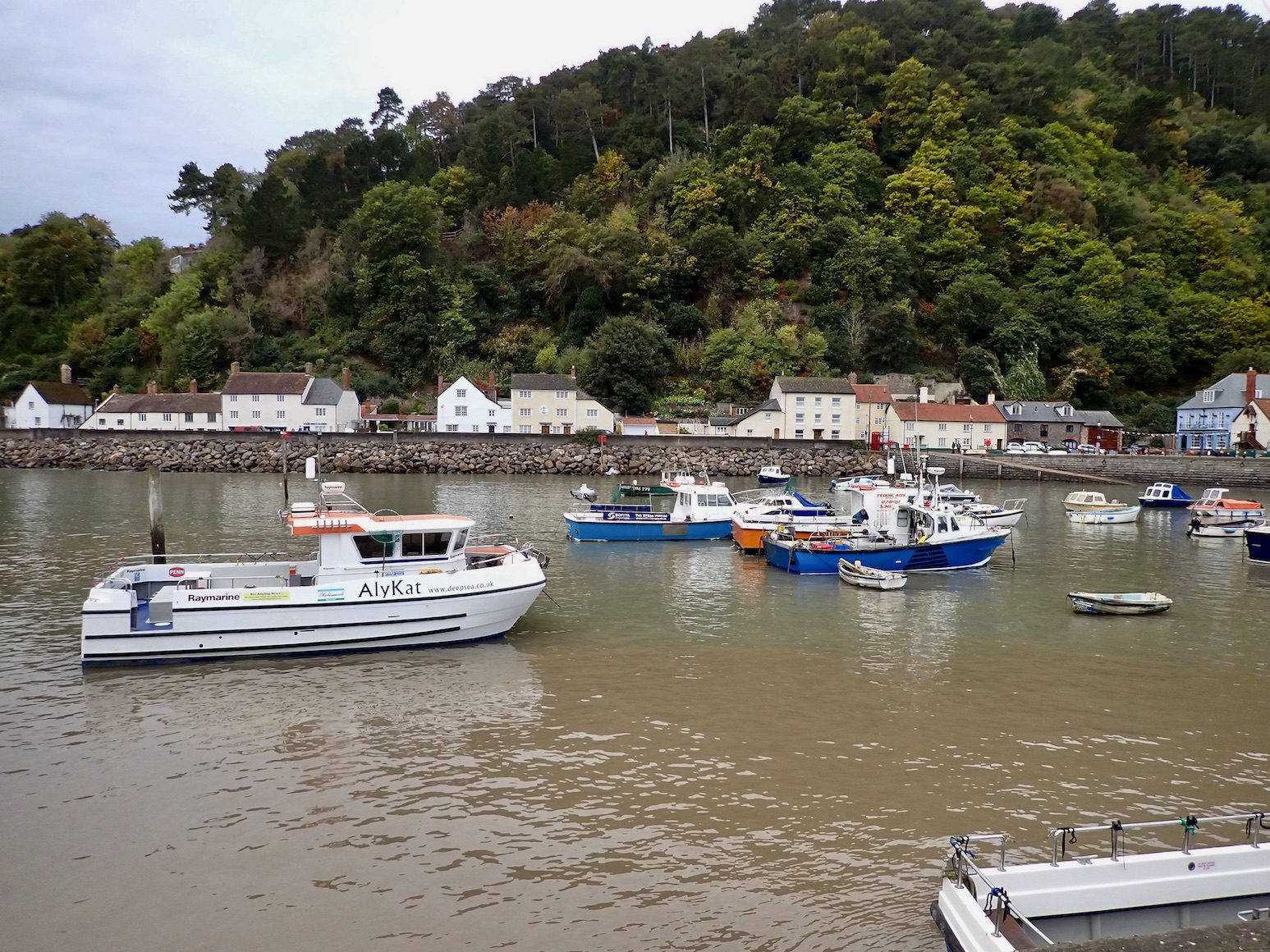
The boat turned West out of the harbour and steamed down channel to a mark off Porlock Weir where Mike predicted huss, conger and the chance of a ray. The first mark proved a little snaggy and we lost a couple of rigs and hauled up numerous small conger.
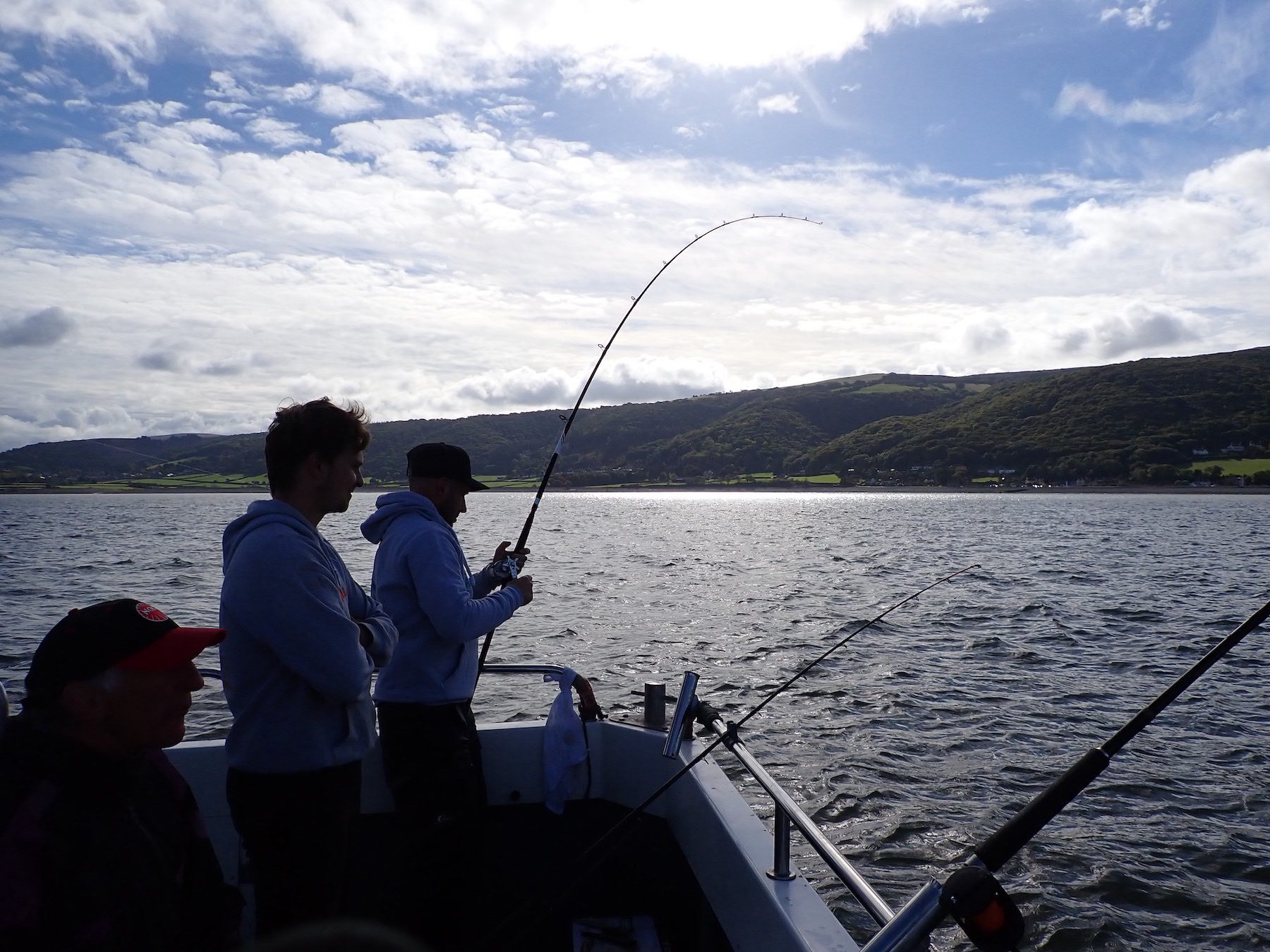
Mike up anchored and moved the boat a few hundred yards before resetting the anchor. This proved to be cleared ground and we lost no more rigs. The conger were undoubtedly present in good numbers and a succession of hard fighting eels were brought to the boat. Derek hooked into an eel that put a substantial bend into his rod before eventually being brought to the boat. The eel estimated at around 15lb was hauled in for a quick photo. Next drop down Derek was into an even bigger eel that was released boat side.
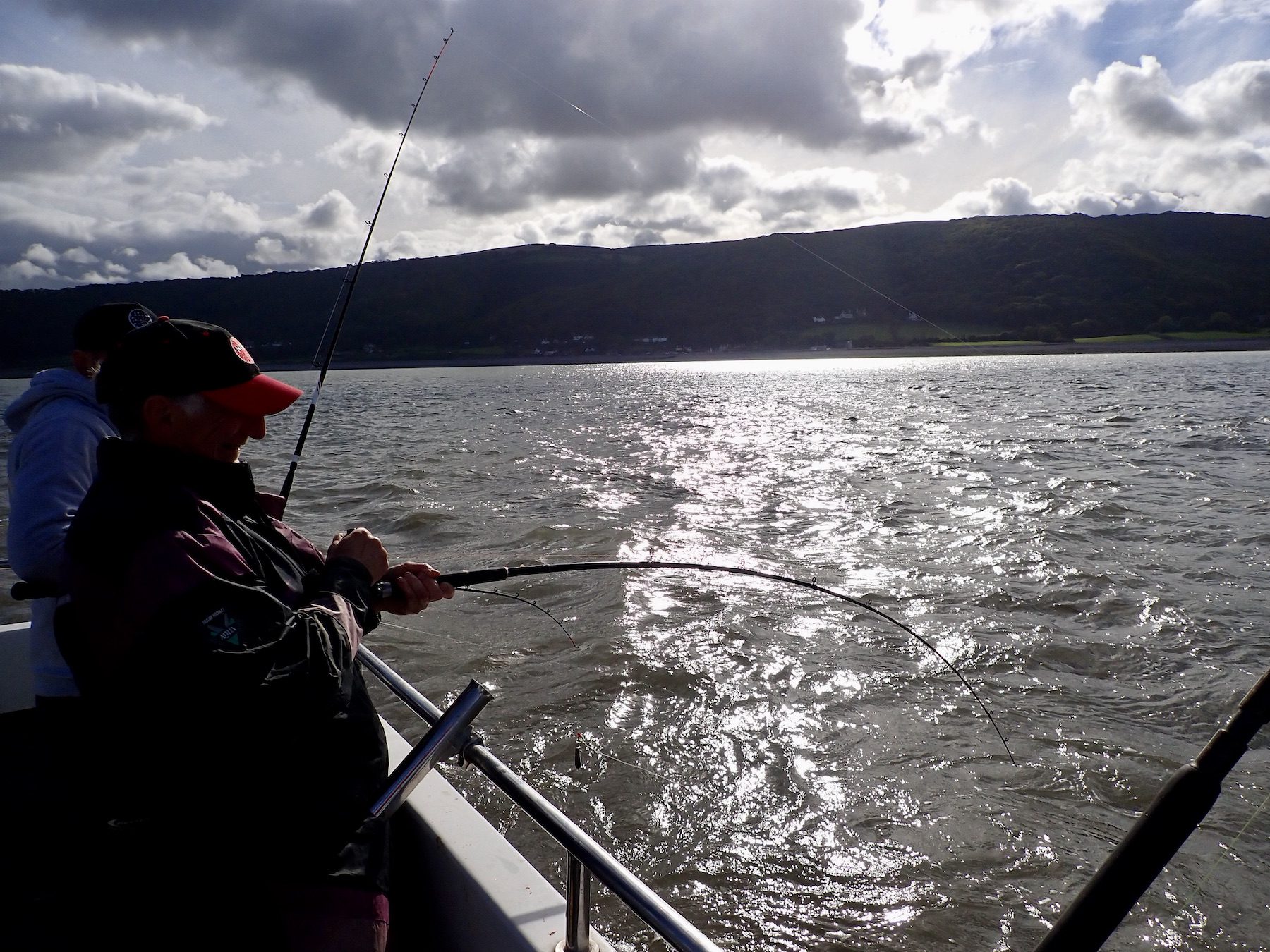
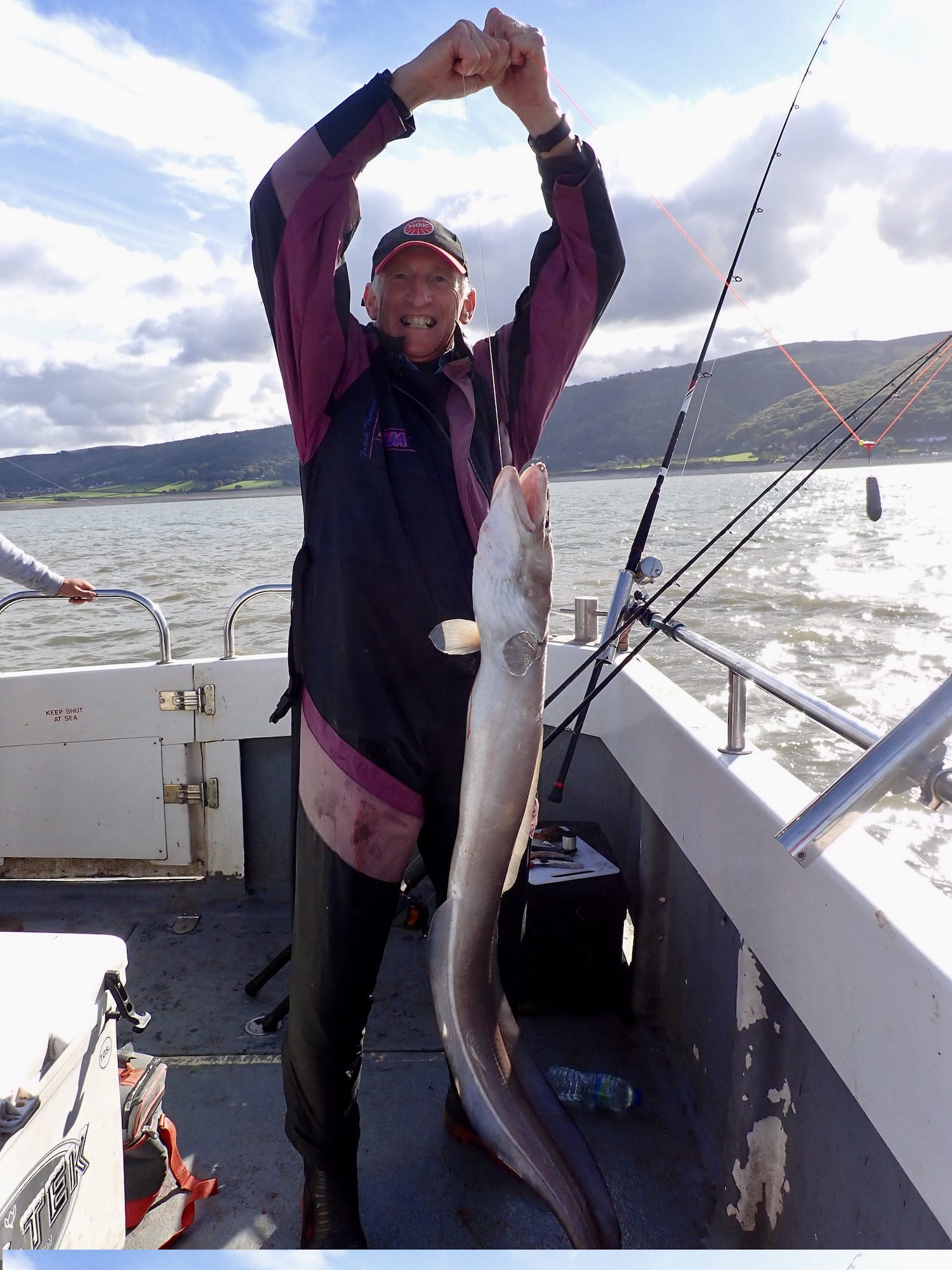
A couple of decent huss were brought into the boat along with a thornback and a blonde ray. As the tide eased the action slowed and Mike said it was time to head up channel for a blonde ray.
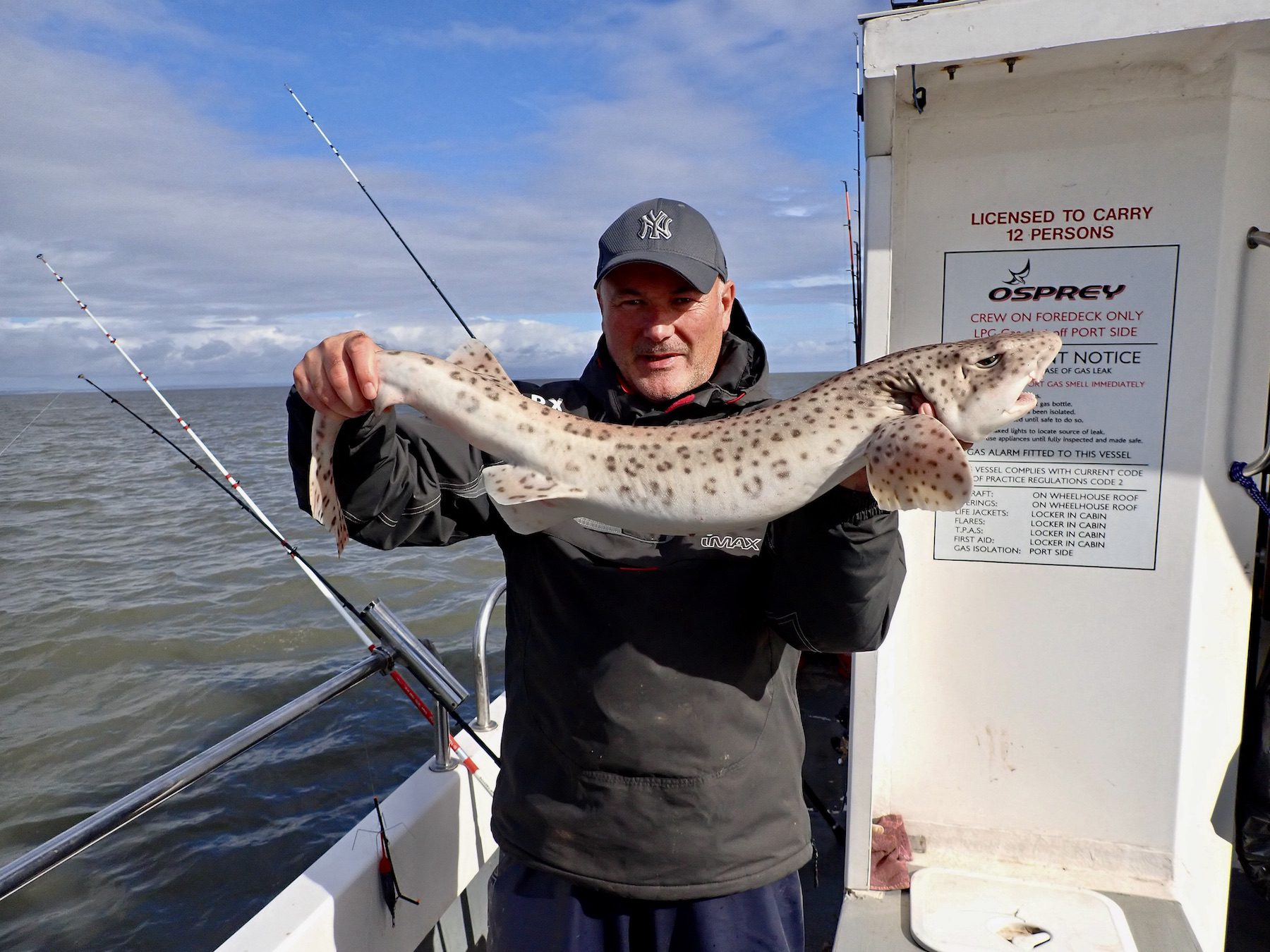
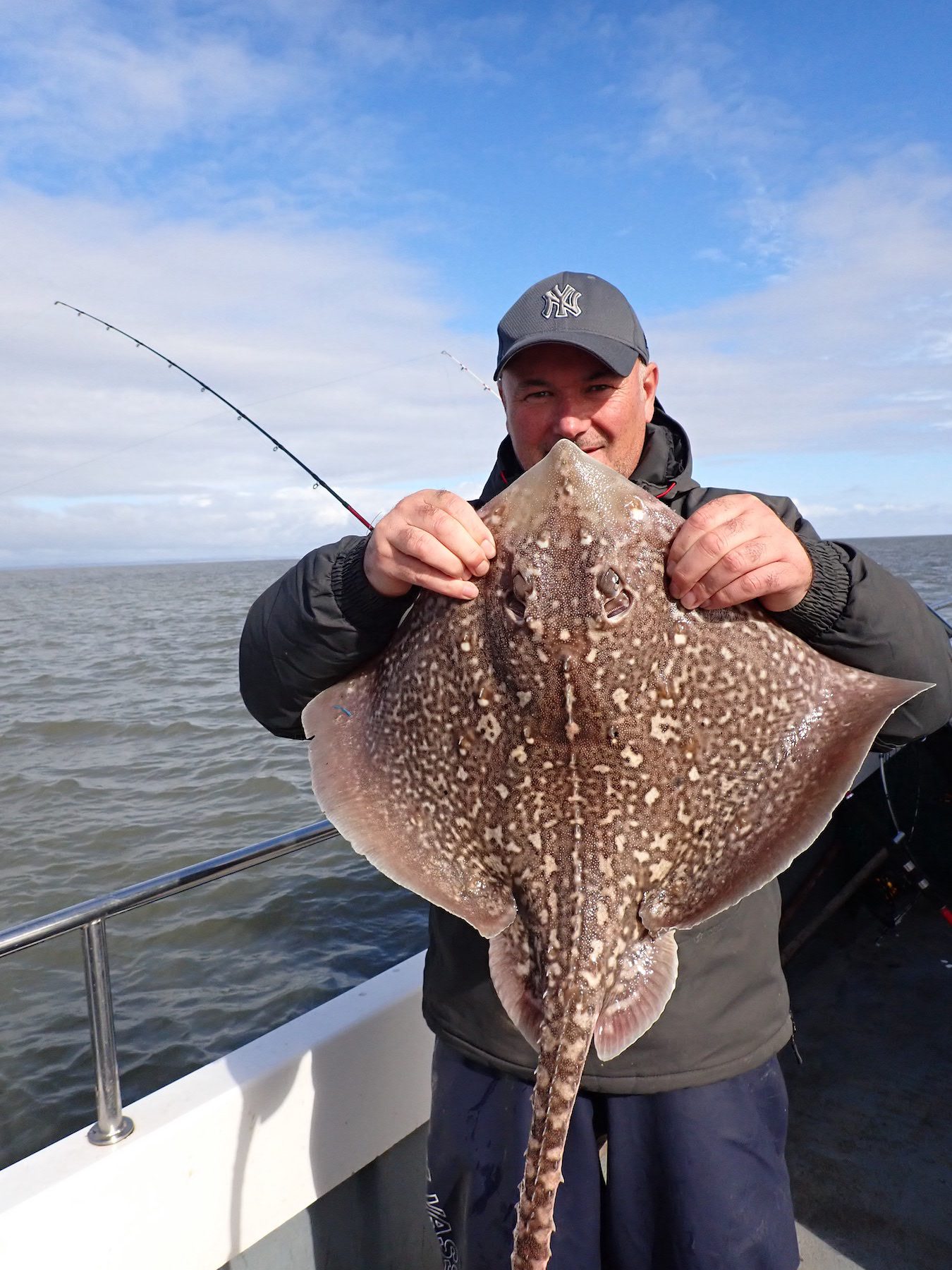
This new mark was clean ground so Mike stated that conger should be less plentiful. Wrong! A succession of small eels seized our baits intended for blonde ray. Mike was however proved correct as the tide eased to low water. Rob Scoines hooked a decent fish that proved to be a lovely looking blonde of around 8lb.
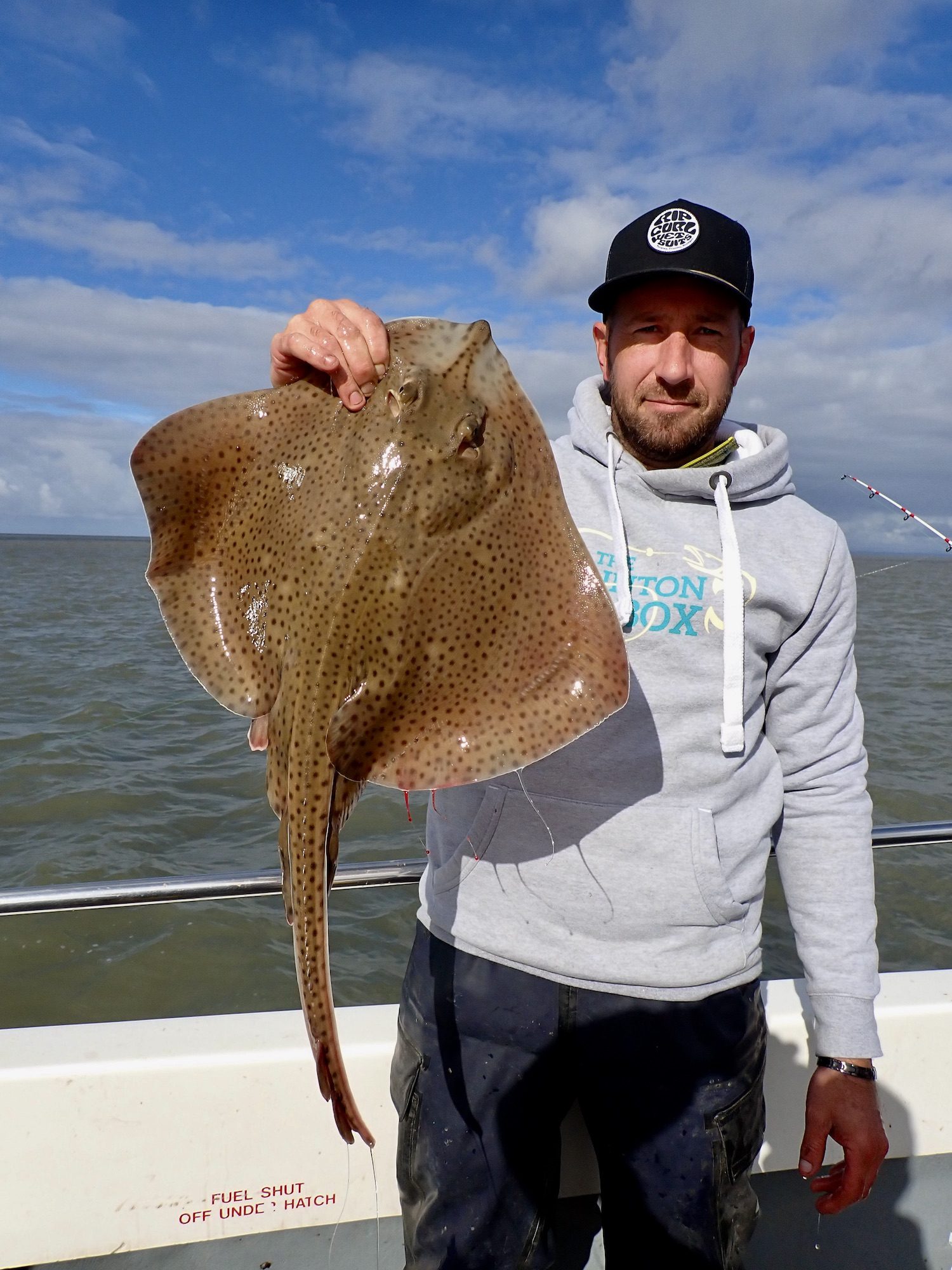
This was followed a few minutes later when I hooked a good fish that put a healthy bend in my rod before eventually being pulled over the rim of the net. I estimated the ray at around 12lb and slipped it quickly back after a photo. A few years ago, I would have been keen to put a number to the fish but these days I seem to have lost that urgent need for gathering statistics.
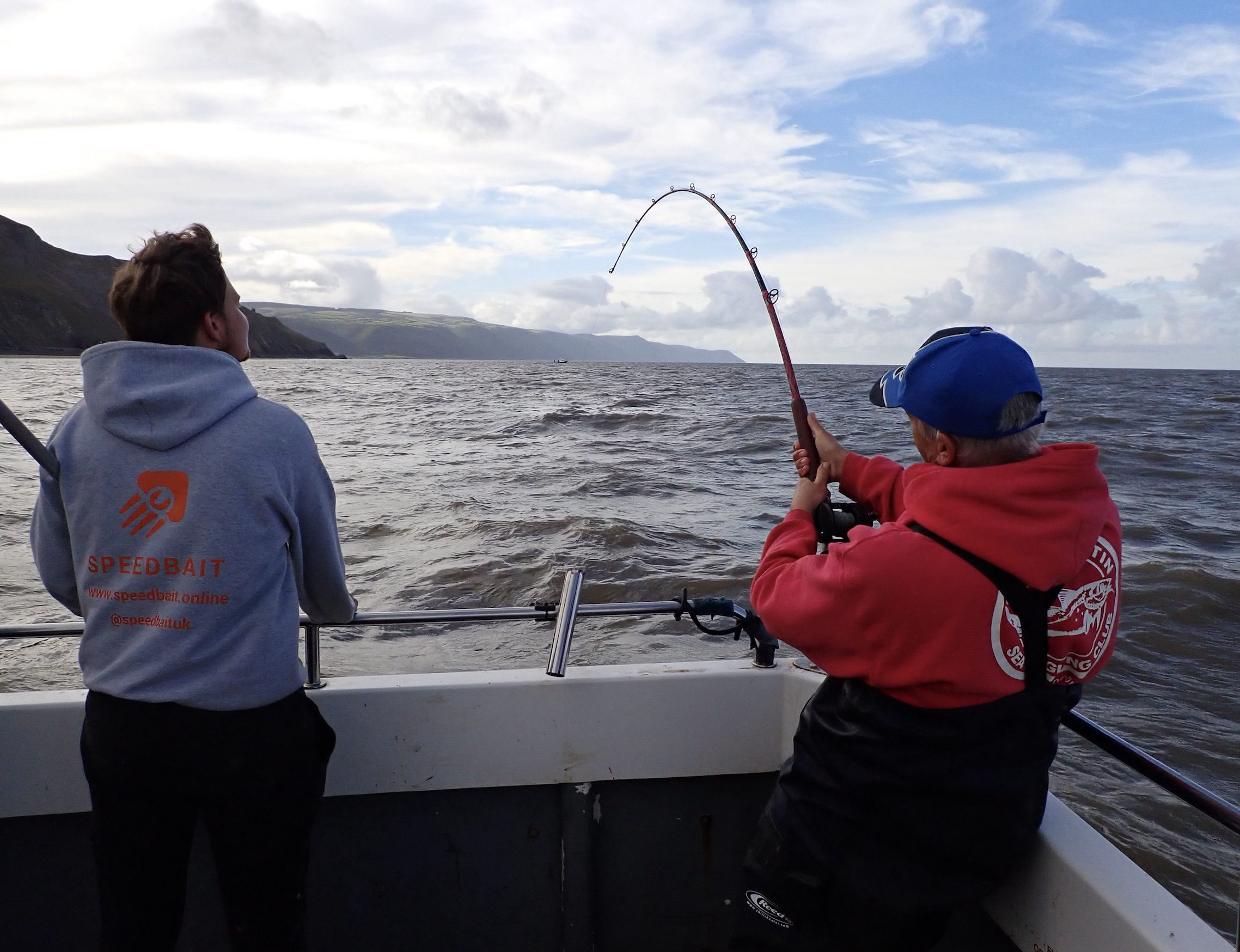
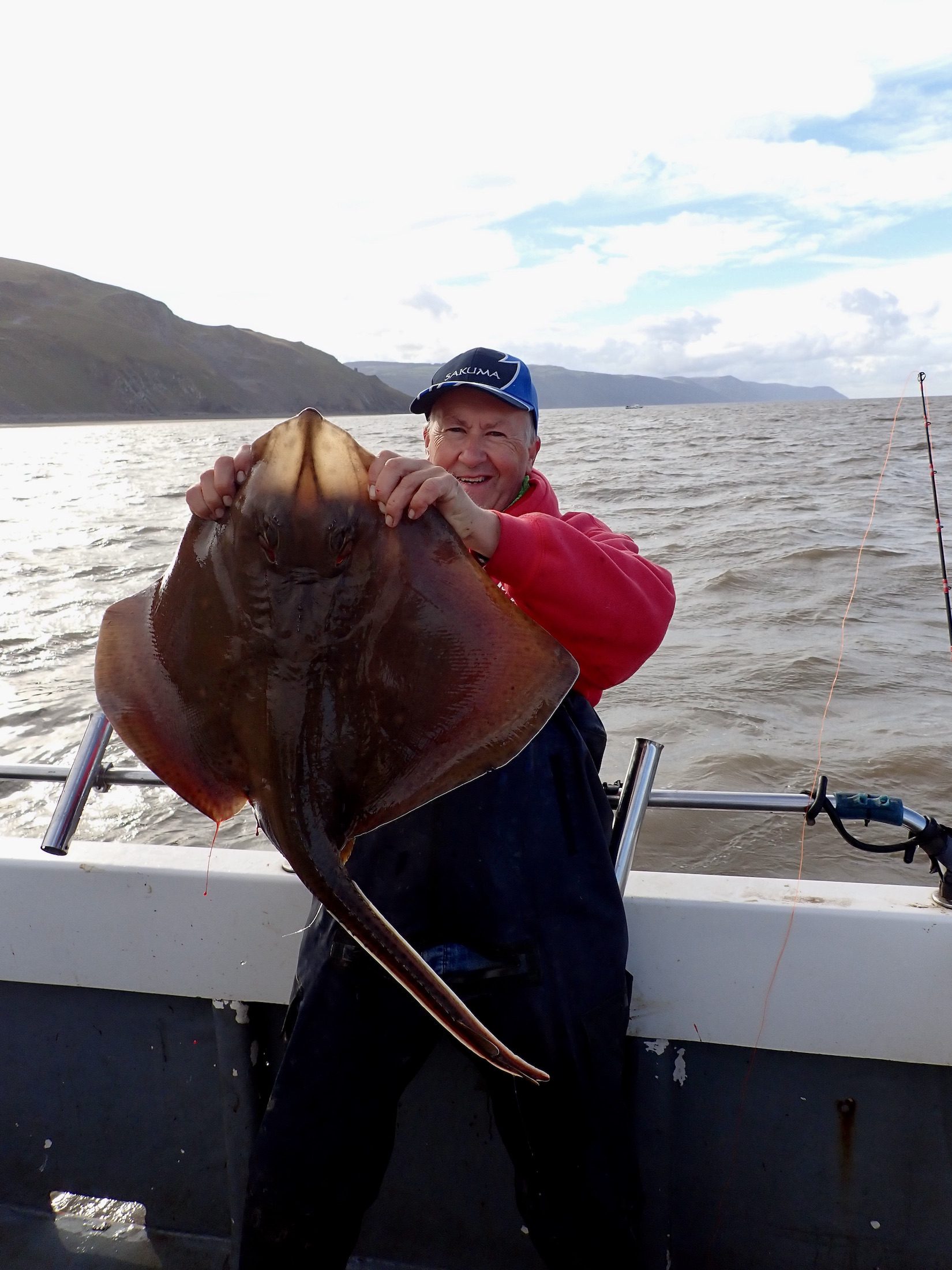
A few moments later it was Robs turn to do battle and this fish definitely deserved a number and was recorded at 16lb 3oz a specimen rating of 107%. Another blonde of close to double figure was also boated by our fellow boat fishers from Bristol.
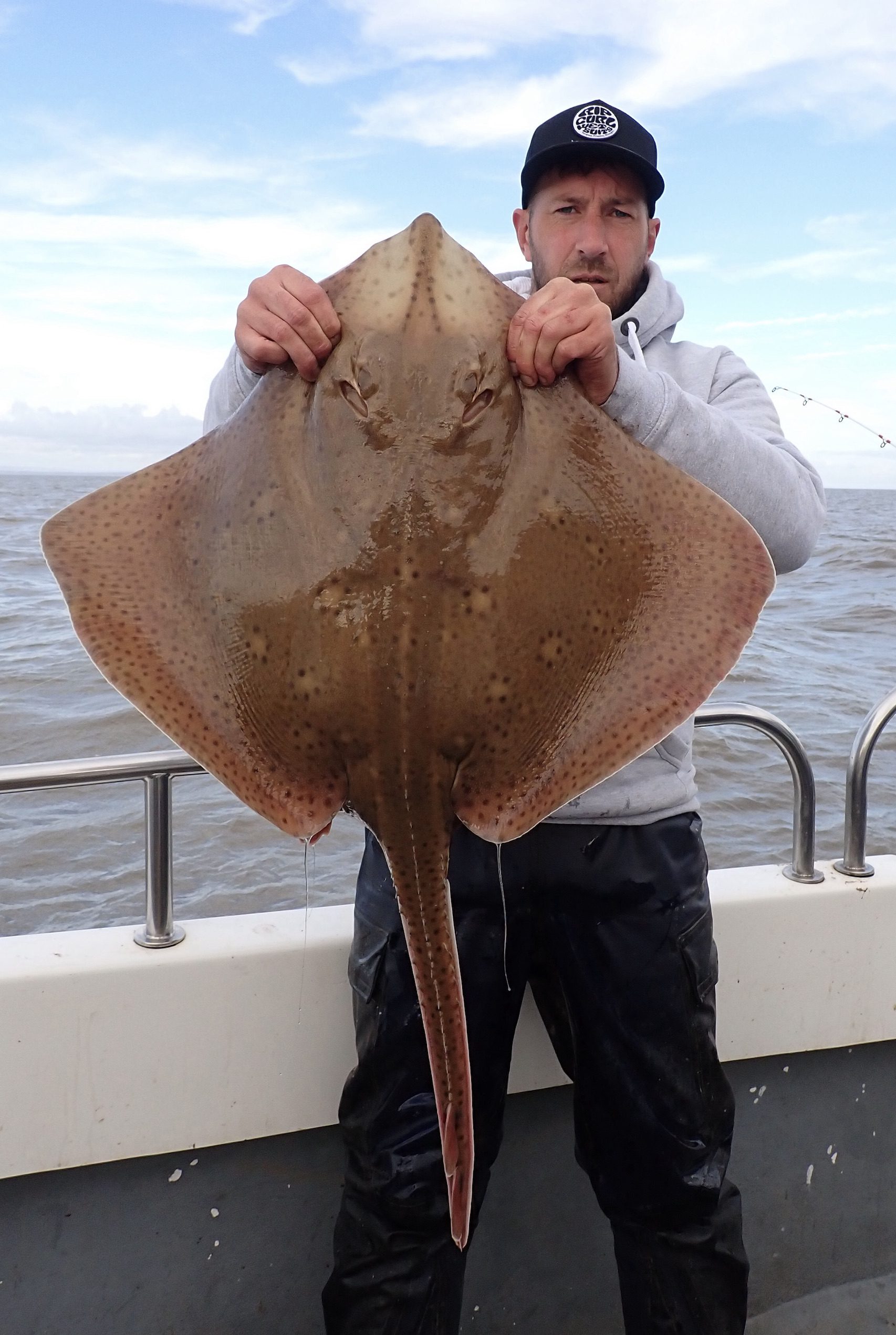
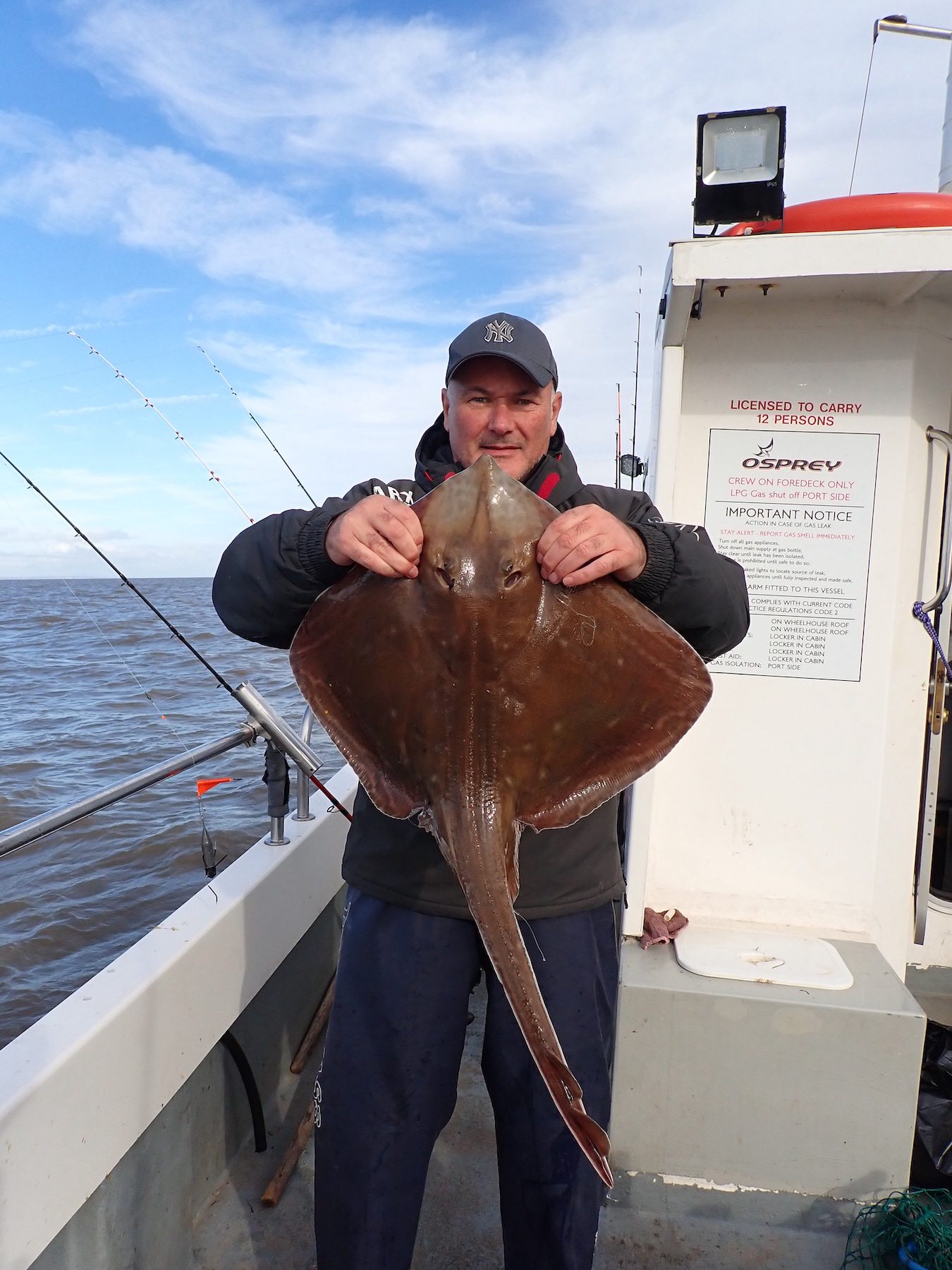
As the tide began to flood the bites again eased as the blonde ray appeared to switch off. It was now time to move once again to our final mark of the day half a mile or so off Dunster.
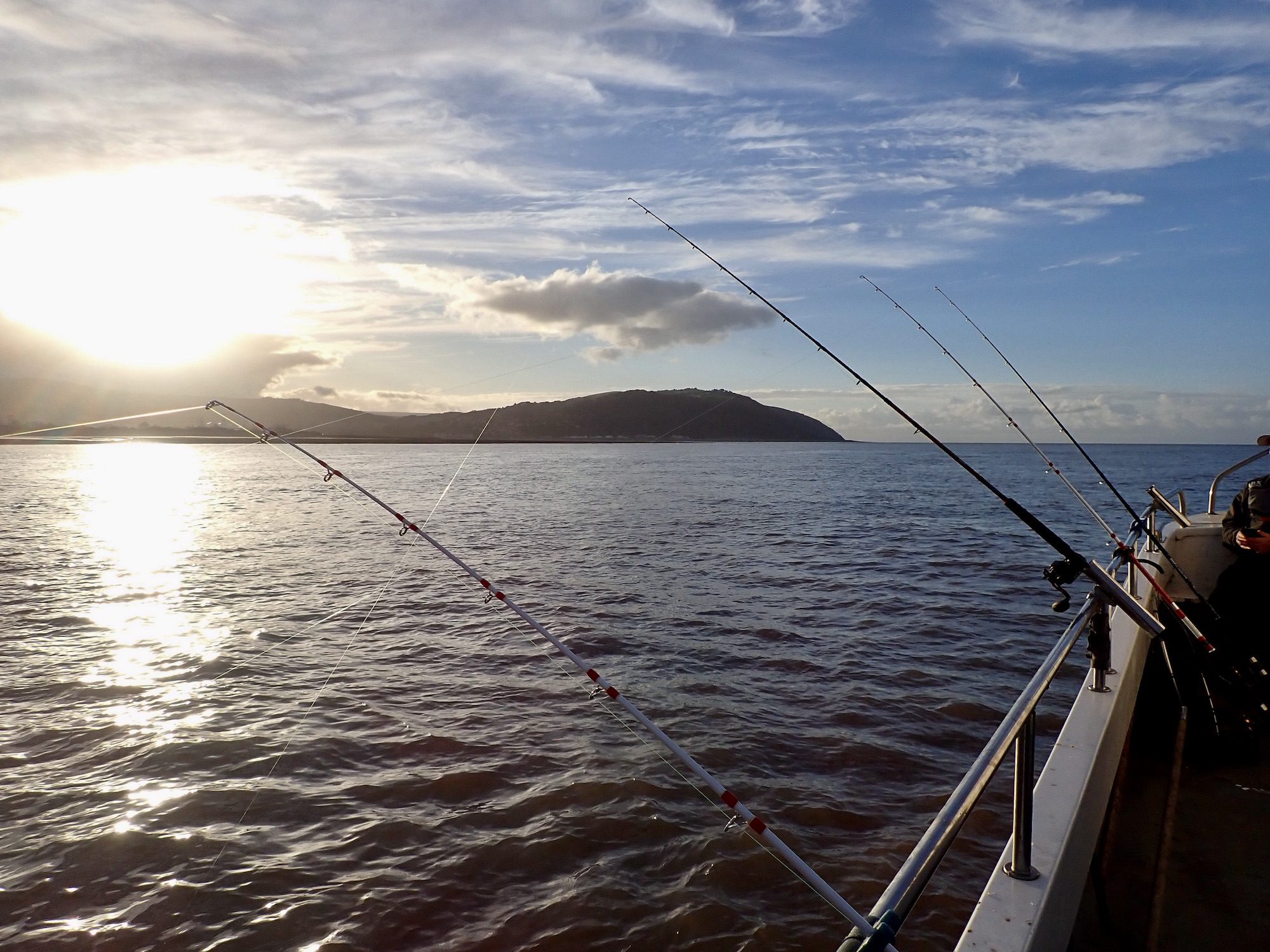
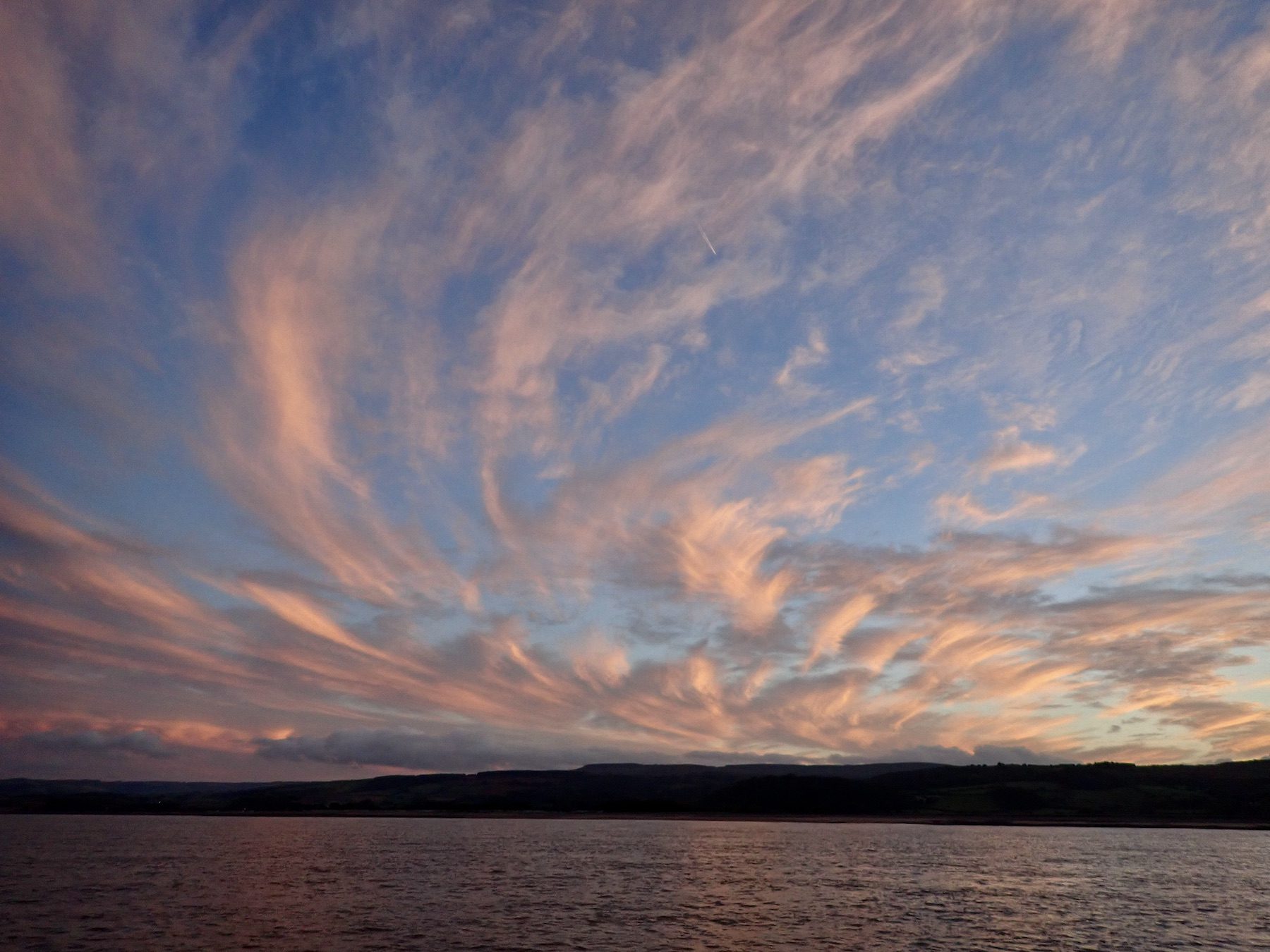
It was now early evening and the sky was painted in wispy pink clouds. We all savoured the magical fading light over fresh brews of tea and coffee. These moments of quiet contemplation and expectation are to some extent what fishing is all about.
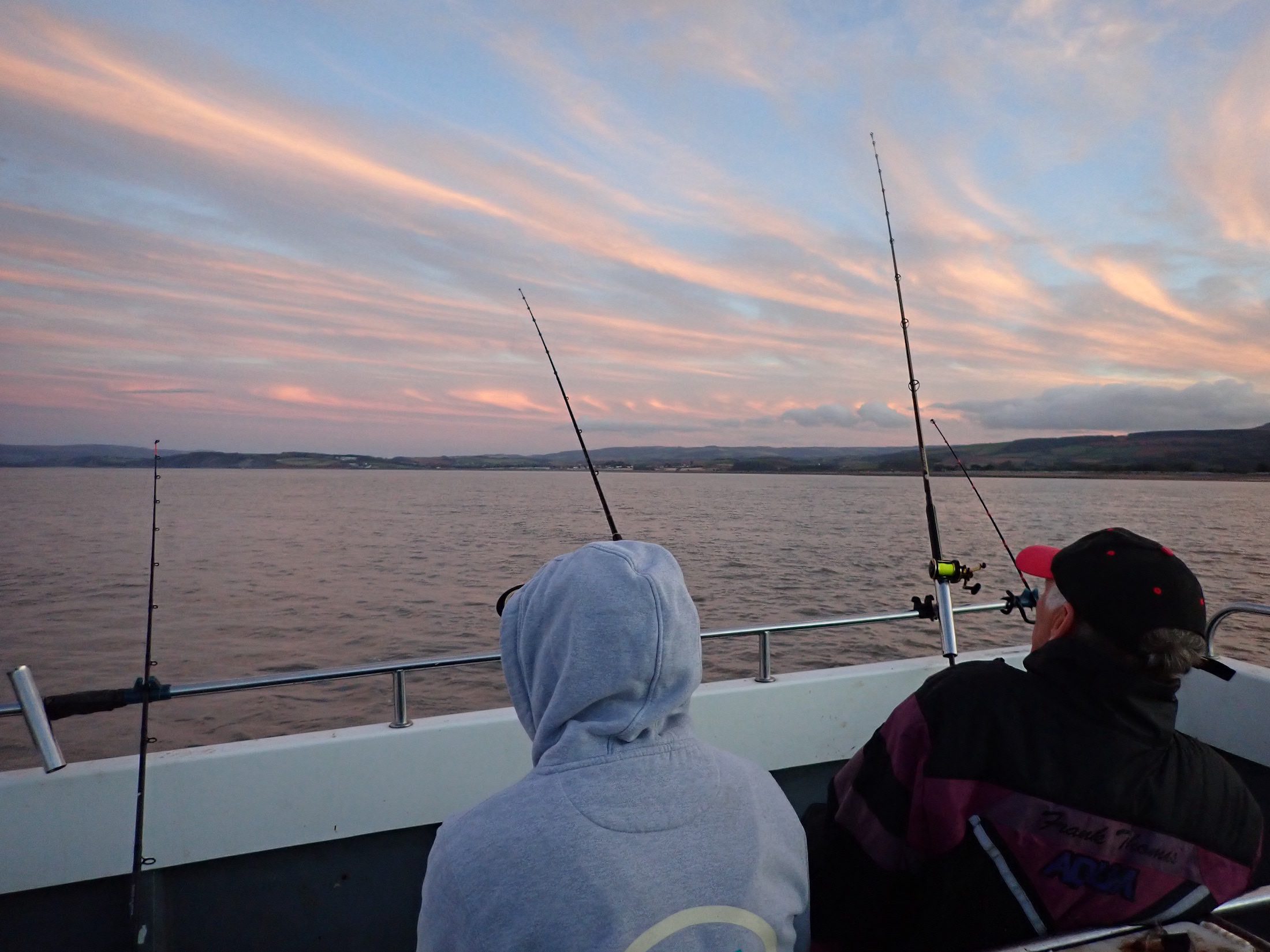
A few eels gave strong bites and tussles in the strong tide. A couple of thornback were also added to the days tally along with a hard fighting smoothound for Rob.
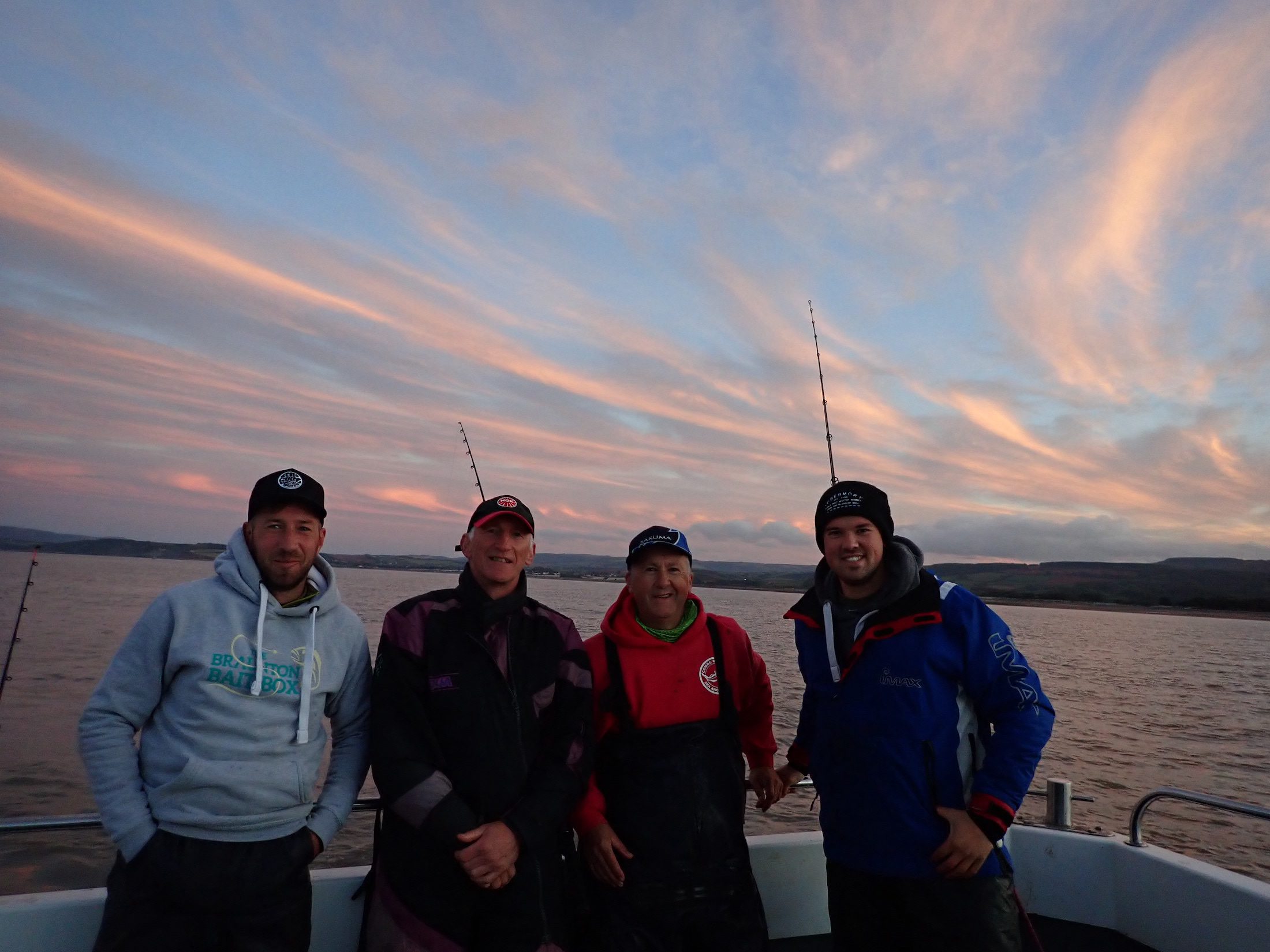
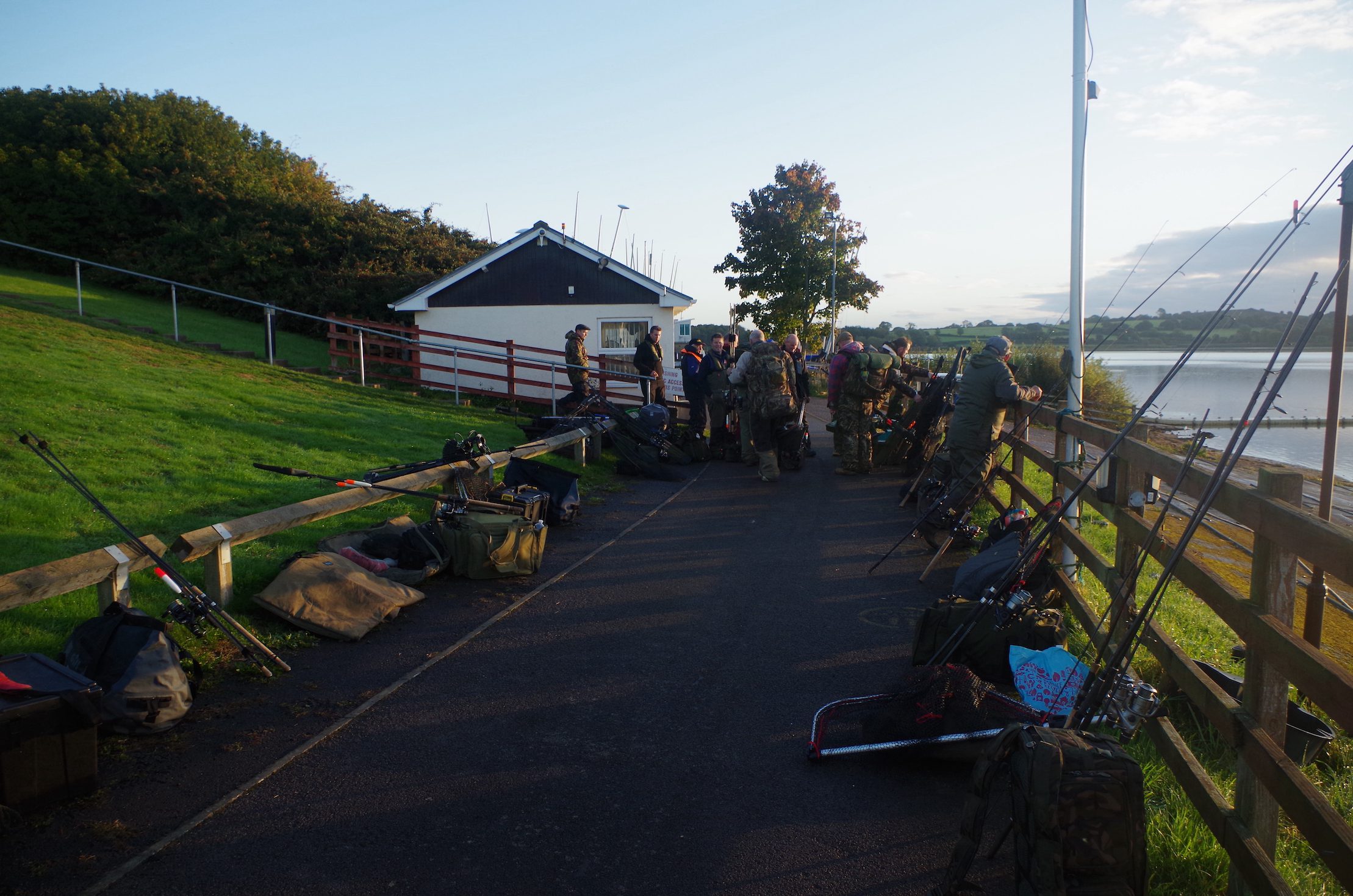
Chew Valley Lake 8:00am, it’s an excited gathering of anglers as always struggling to the boats with masses of piking tackle. There were the normal sprinkling of BIG NAMES in pike fishing amongst the eager group. I Have fished Chew on numerous occasions since it opened to pike fishing in October 2001 and always relish the challenge.
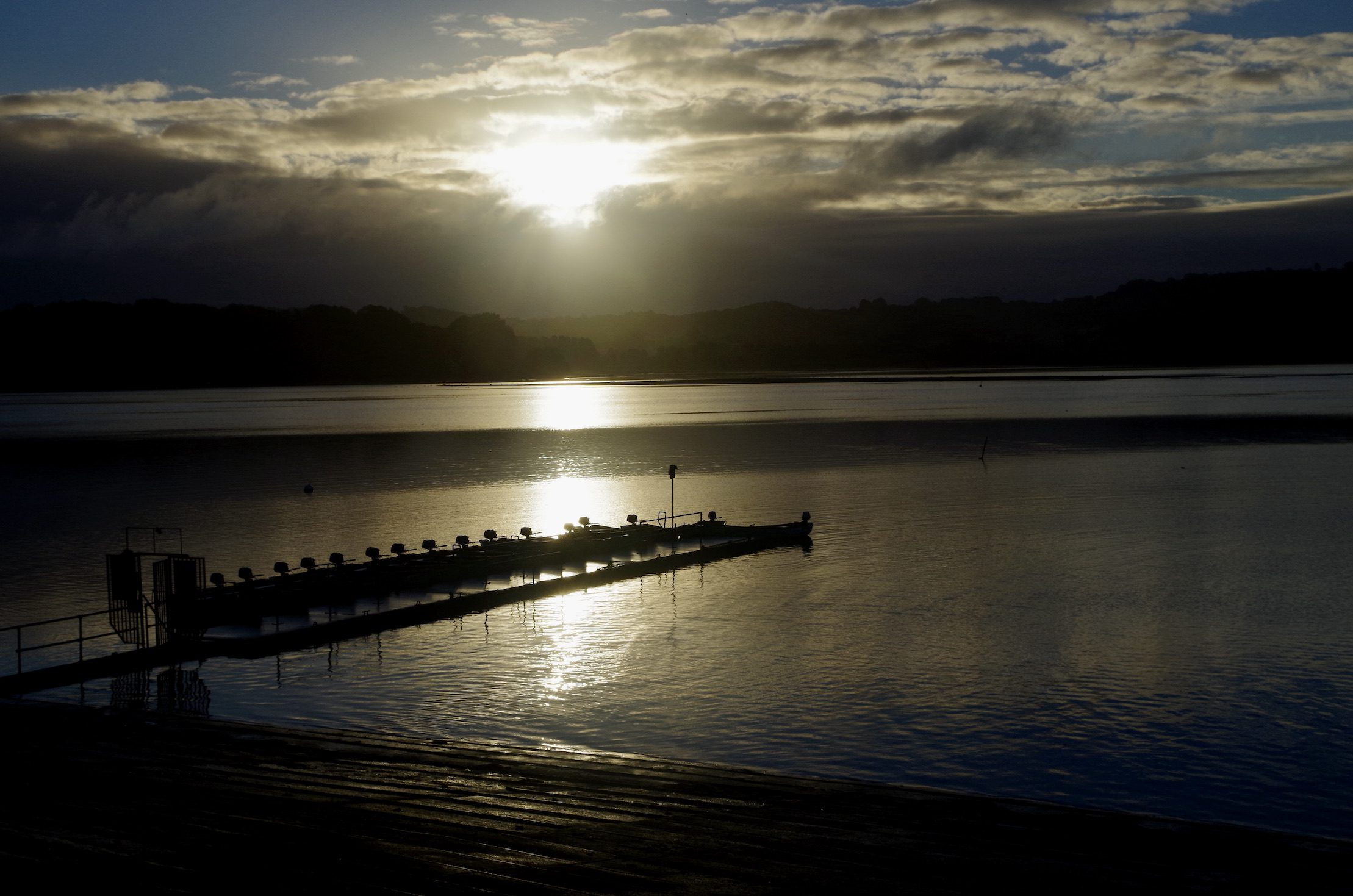
The early morning sun illuminated the vast lake as Bruce Elston and I loaded our gear into the boat. We discussed where we would fish and decided to go against the general wisdom and head for deep water close to the dam. The well known Stratford area would undoubtedly be packed with boats and we just didn’t want to be amongst the crowds. Big pike have been caught from all around Chew Valley Lake so whilst location is the key it is a big lake and it might not always pay to follow the crowds.
To some extent my approach to fishing has changed over the years and enjoyment of the day is undoubtedly my number one aim. This may to some extent have been influenced by catching a 38lb pike earlier in the year a fish of a lifetime that I may never surpass. That fish was caught on a fly and both Bruce and I now question the benefits of targeting the pike during the trials at a higher cost when the fish can be caught on fly tackle.
That said there is something special about watching floats bobbing upon a lake and the expectation of their disappearance at any moment. I cannot say for certain which approach I prefer or which is the. most effective.
We agreed to troll lures on the way to our first location and were rewarded with a jack each. Using an echo sounder we located the boat close to where the bottom contours indicated a significant drop off. We then dropped anchors to ensure the boat remained stable and cast out dead-baits spread around the boat. It was now time to pour a fresh coffee and gather our thoughts.
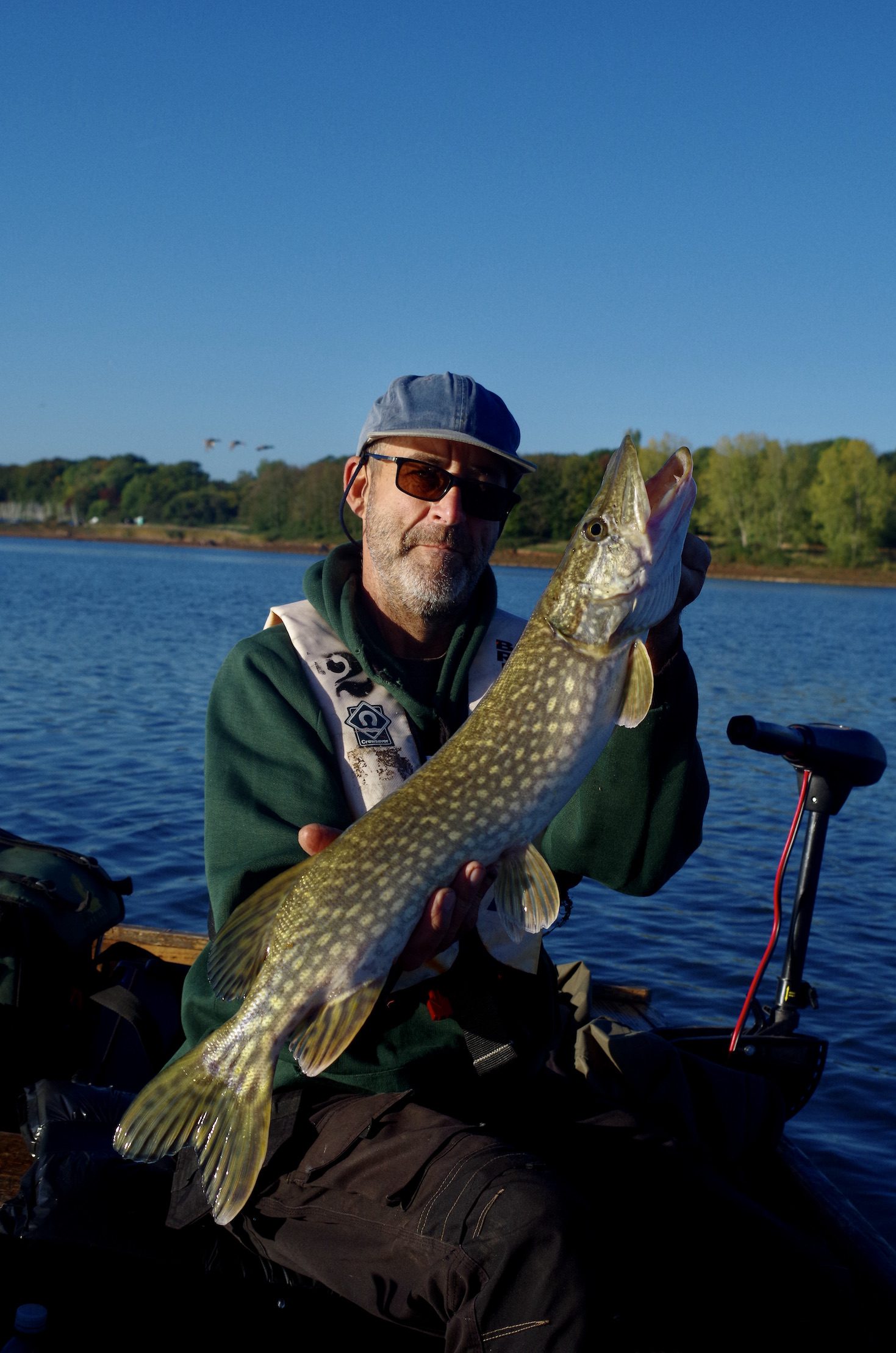
Bruce was first into a fish on a horse mackerel dead bait a small jack of perhaps 4lb.
The conditions were certainly very pleasant for early autumn with a gentle breeze and brilliant blue sky.
After an hour anchored up with dead baits and the occasional search around with various spinners we decided upon a move to a bay further along the West bank.
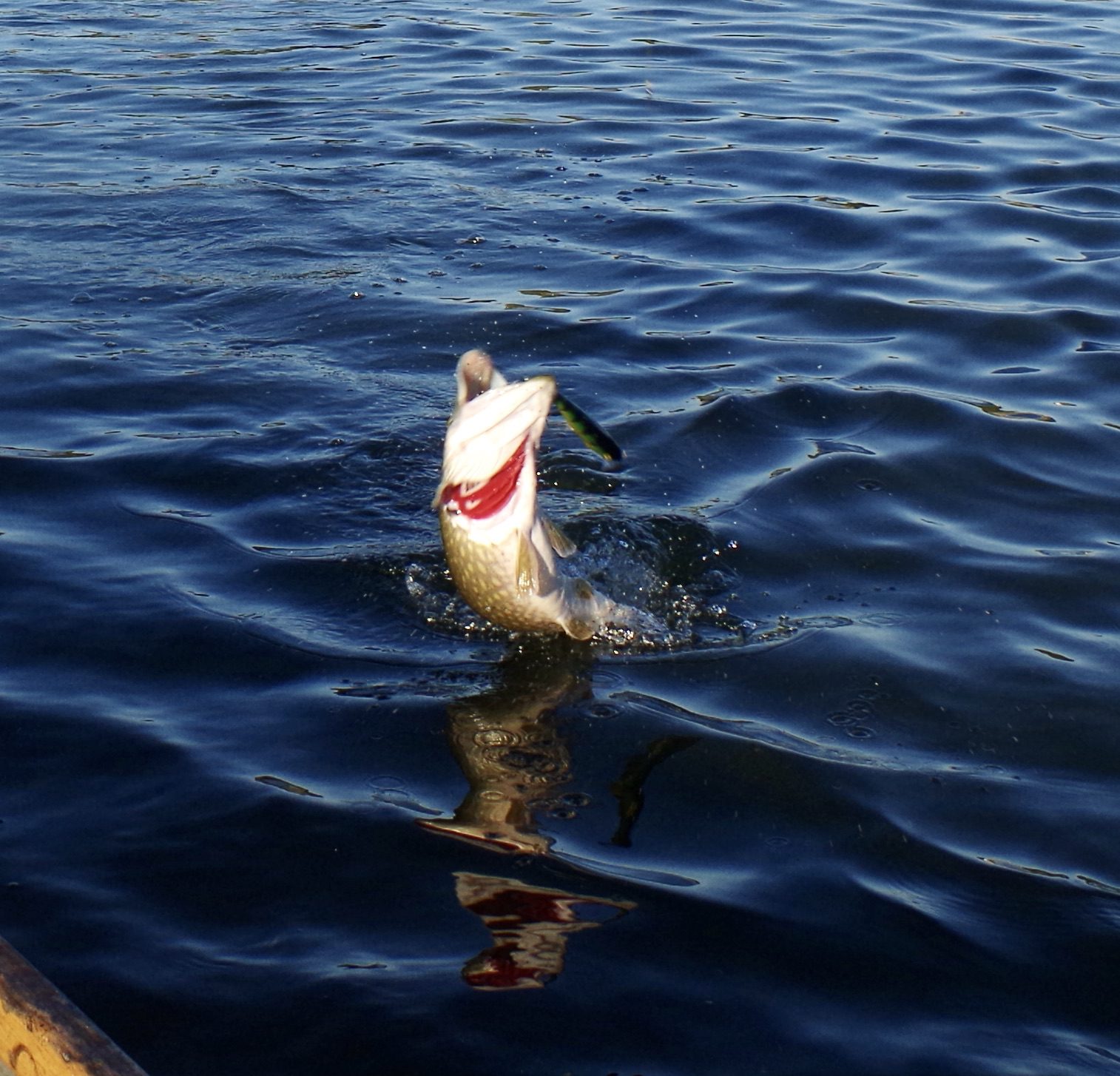
After dropping anchor, I had a cast with the lure and immediately connected with a pike of around 8lb. We enjoyed further success from this location with Bruce adding another couple of jacks to dead-baits.
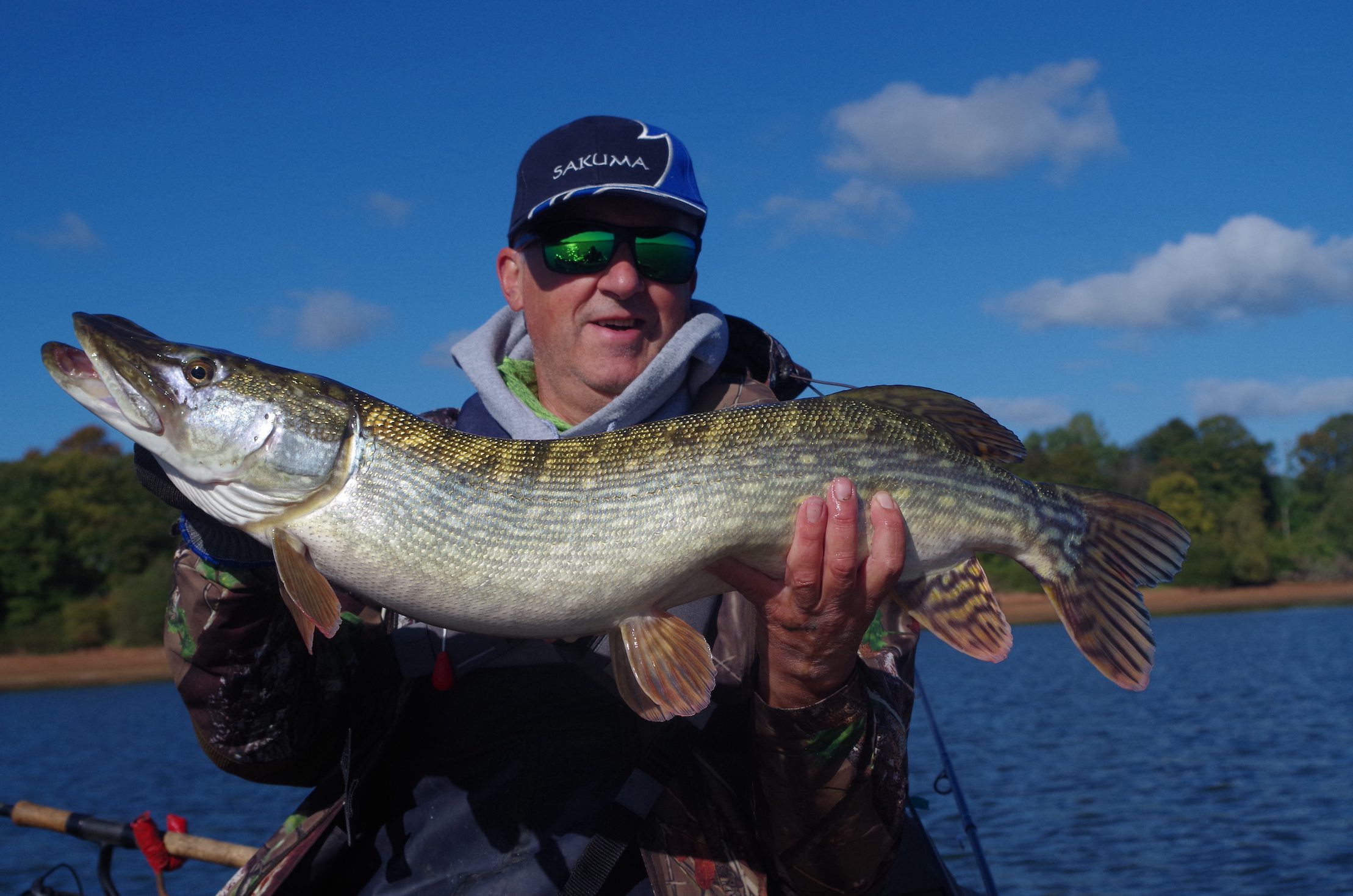
Throughout the day we tried a few different spots, trolled a bit and varied our lures searching each area carefully. The autumn colours were showing on bankside trees. Swans and geese occasionally flew over and grebes glided on the water hunting for fish. High in the sky large planes flew to a fro from nearby Bristol Airport and wondered where they were headed?
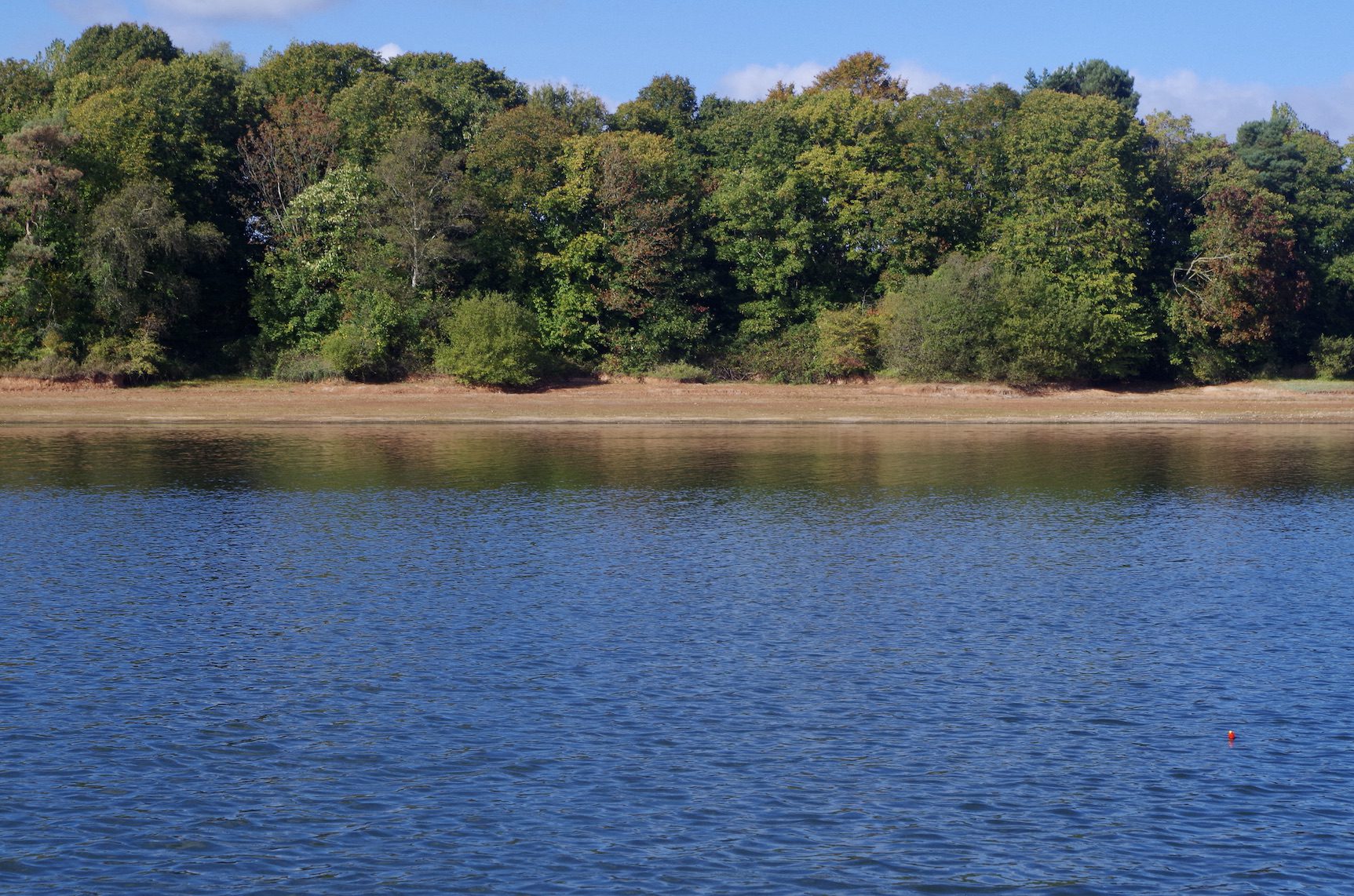
Bruce and I both watched our pike floats intently willing them to disappear. Time as always ebbed away and our dreams of monster pike slowly evaporated as the sun sank in the Western sky.
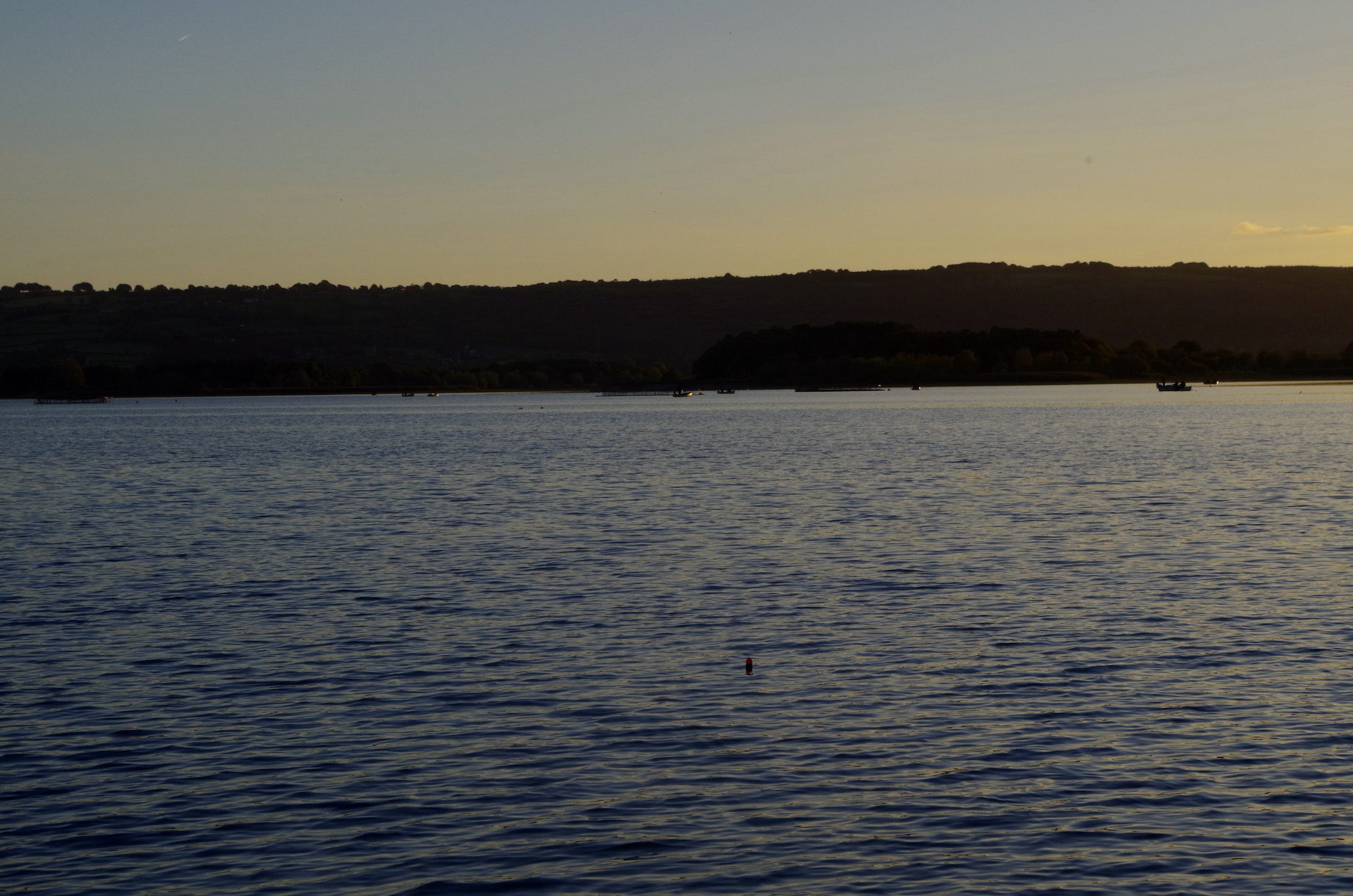
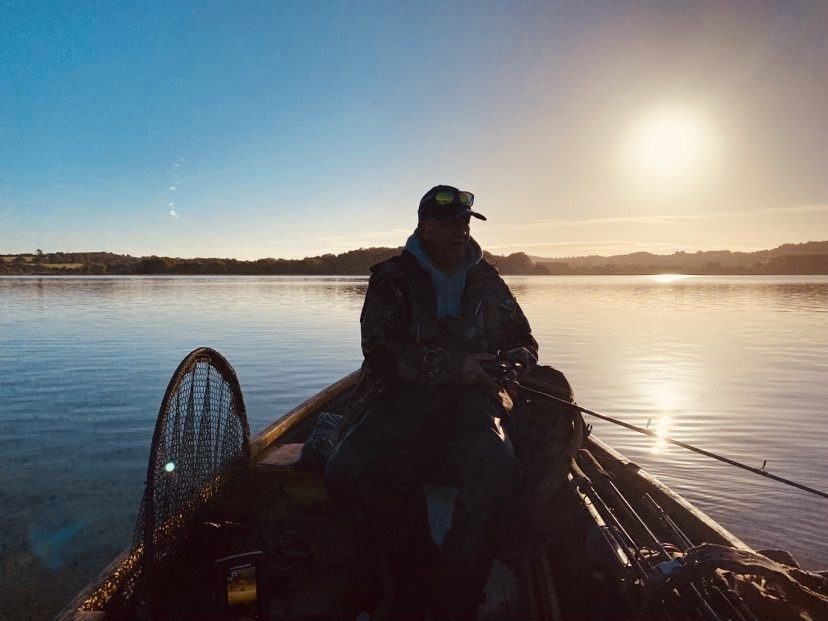
We had boated 14 jacks between us, ten to Bruce and four to me.
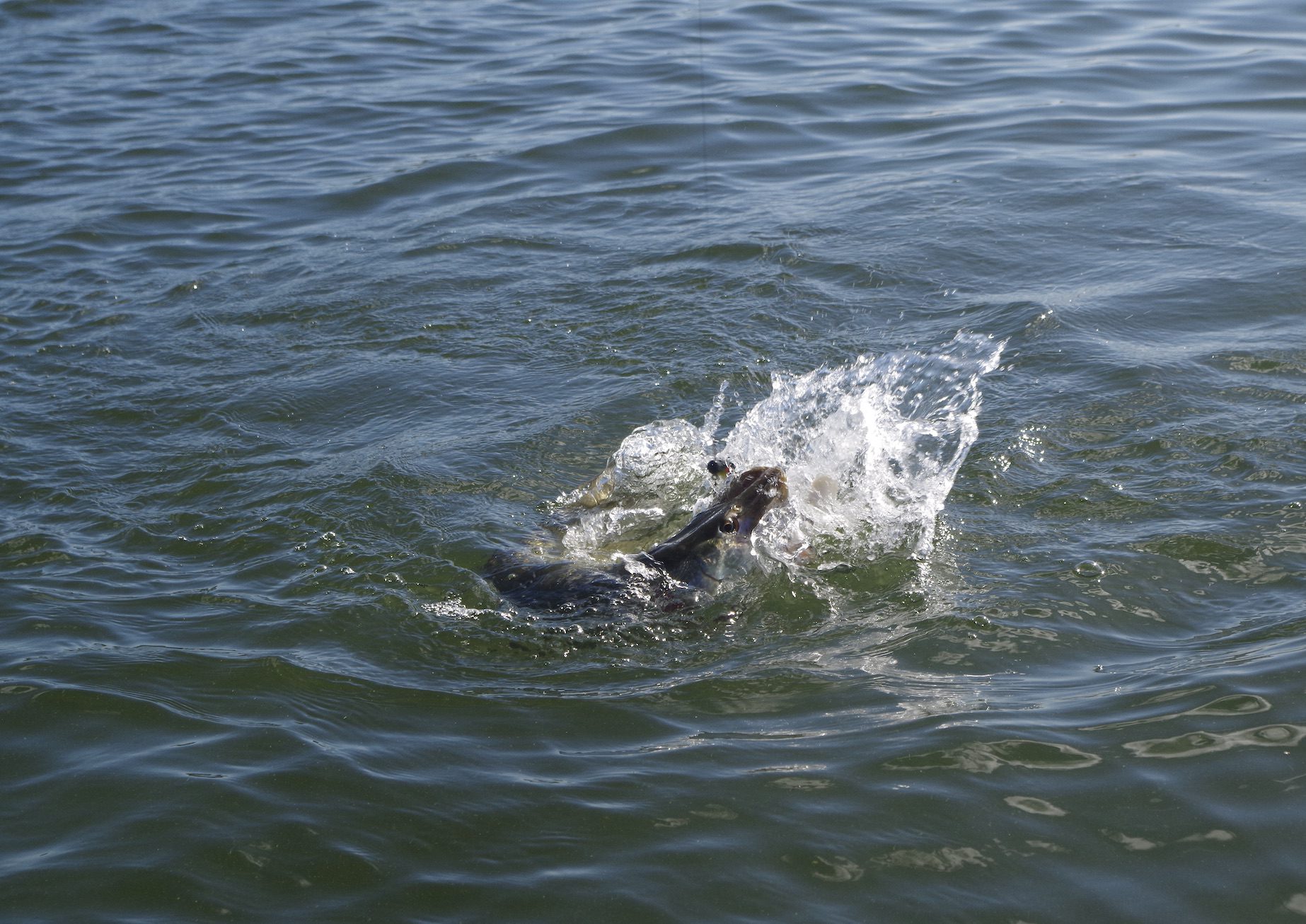
Bruce fished with his good friend Stuart Calder the following day. They chose to anchor up in the renowned Stratford area as thick mist hung over the lake. Early in the day Stuart boated a fine pike of 26lb 10oz. Bruce blanked. Chew is a big lake and each day deals a different hand there are many variables that go to make the game so fascinating and addictive.
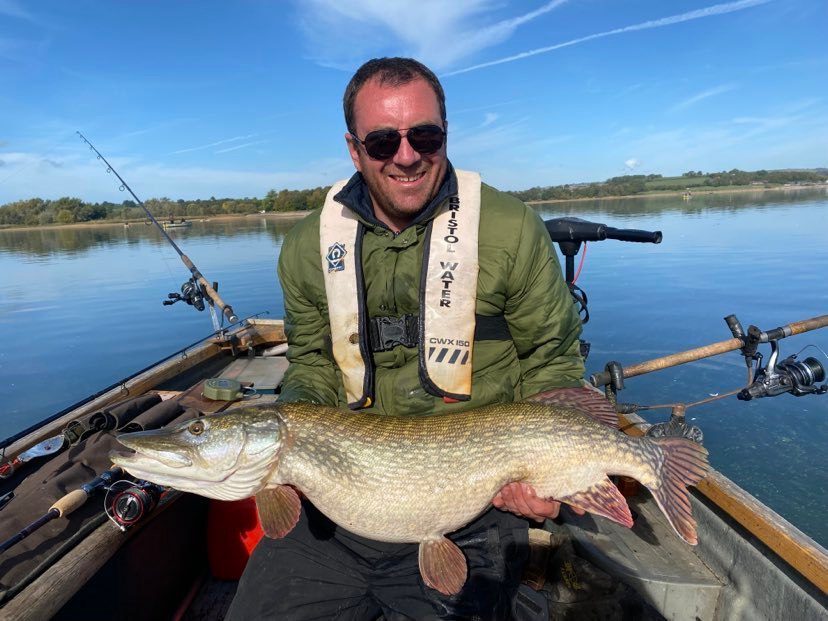
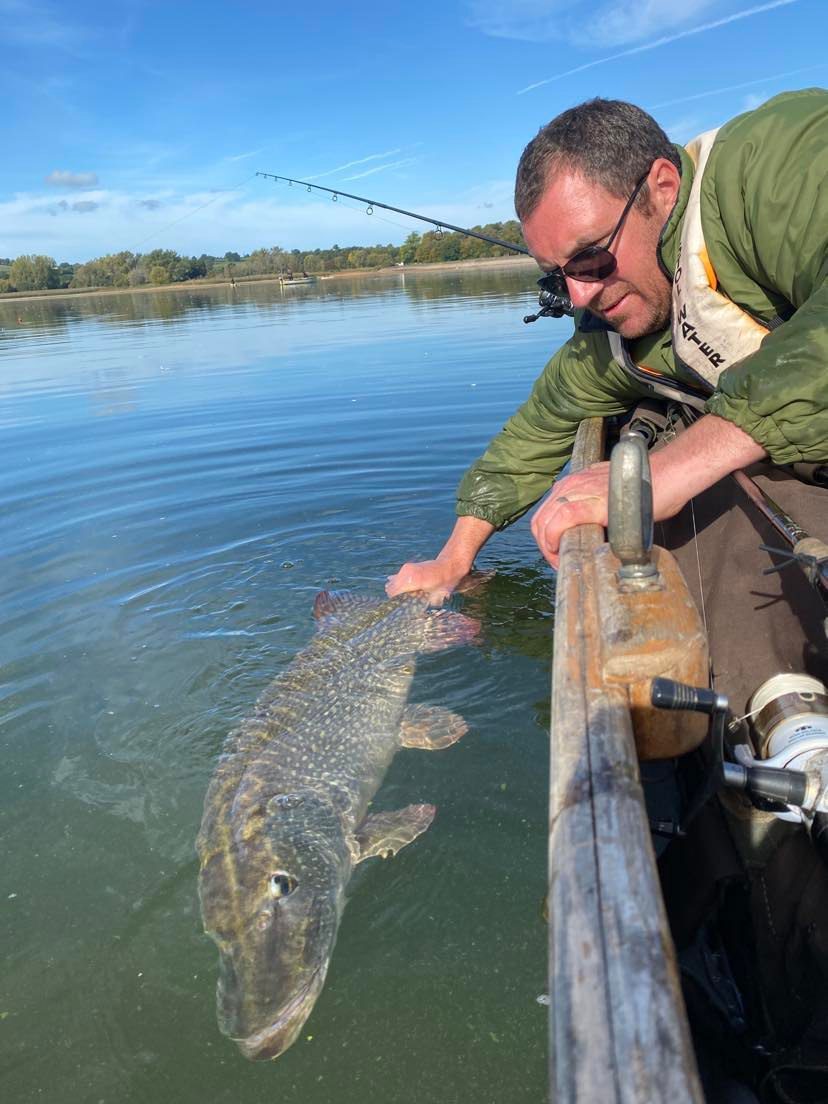
We will be back in the Spring Fly rods in hand casting in hope and hopefully connecting with one of those famous Chew Valley Giants.
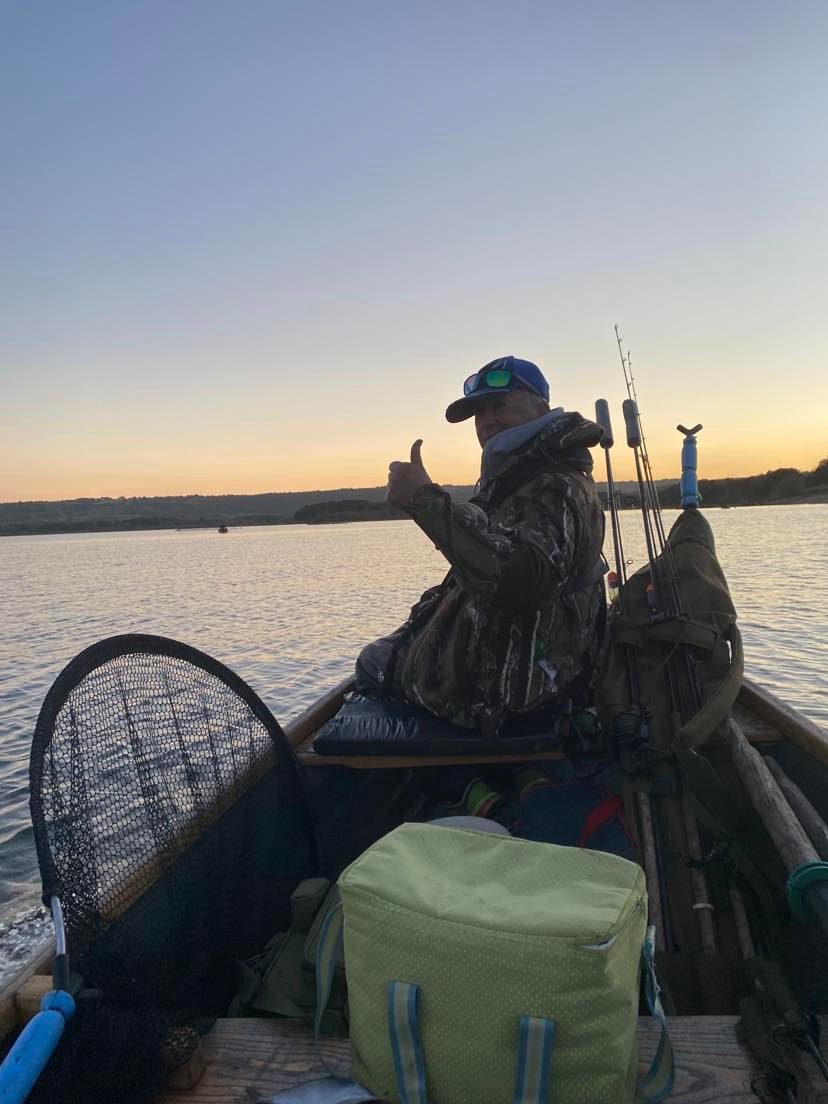
Looe in Cornwall has been a constant throughout my life and a significant stopping off point for fishing adventures for close to sixty years. We were staying in an apartment overlooking the estuary and we delighted in watching the ebbing and flowing of the tides from our vantage point.
Pauline and I had booked the short break to coincide with a boat trip I was joining organised by my friend Keith Armishaw. The trip was to be a reef fishing trip giving the chance of a wide variety of species.
A strong North Westerly wind had been blowing throughout the week making conditions difficult for trips to fishing grounds further off the coast. Keith had organised a week’s fishing that included reef fishing, Shark and tuna fishing. I was heading out on the Thursday and Pauline and I met up with members of the fishing entourage and their families in the ‘Old Salutation Inn’. This old Inn situated in the heart of East Looe has a wealth of old shark and fishing images upon its walls. Old black and white portraits of huge shark hanging at the weigh station beside their proud captors. Fortunately, such slaughter is now a thing of the past as a more enlightened generation now return all shark alive in the hope that a thriving sport fishery can be maintained for future generations.
Fishing was of course high on the agenda as we dined and it appeared that the days shark fishing had been challenging with a very rough sea making conditions difficult for even seasoned anglers. A good shark had been brought boat-side and was estimated at 95lb. A qualifier for the Shark Angling Club of Great Britain that has its headquarters in Looe.
Optimism for the reef fishing day was high and with fishing likely to be on reefs closer to the coast there would be a degree of shelter from the prevailing North West wind.
I arrived quayside at 8:00 and met with fellow anglers for the day. Keith Armishaw, Dom Garnett, Mark Everard, Reg Talbot, Peter Evans, Nick Roberts and Tony Christou. Whilst waiting we chatted to the film crew who were busy filming a spin off drama of ‘Death In Paradise’. It was enlightening to see how many technicians and support were involved in such a production that undoubtedly brings significant income into the town.
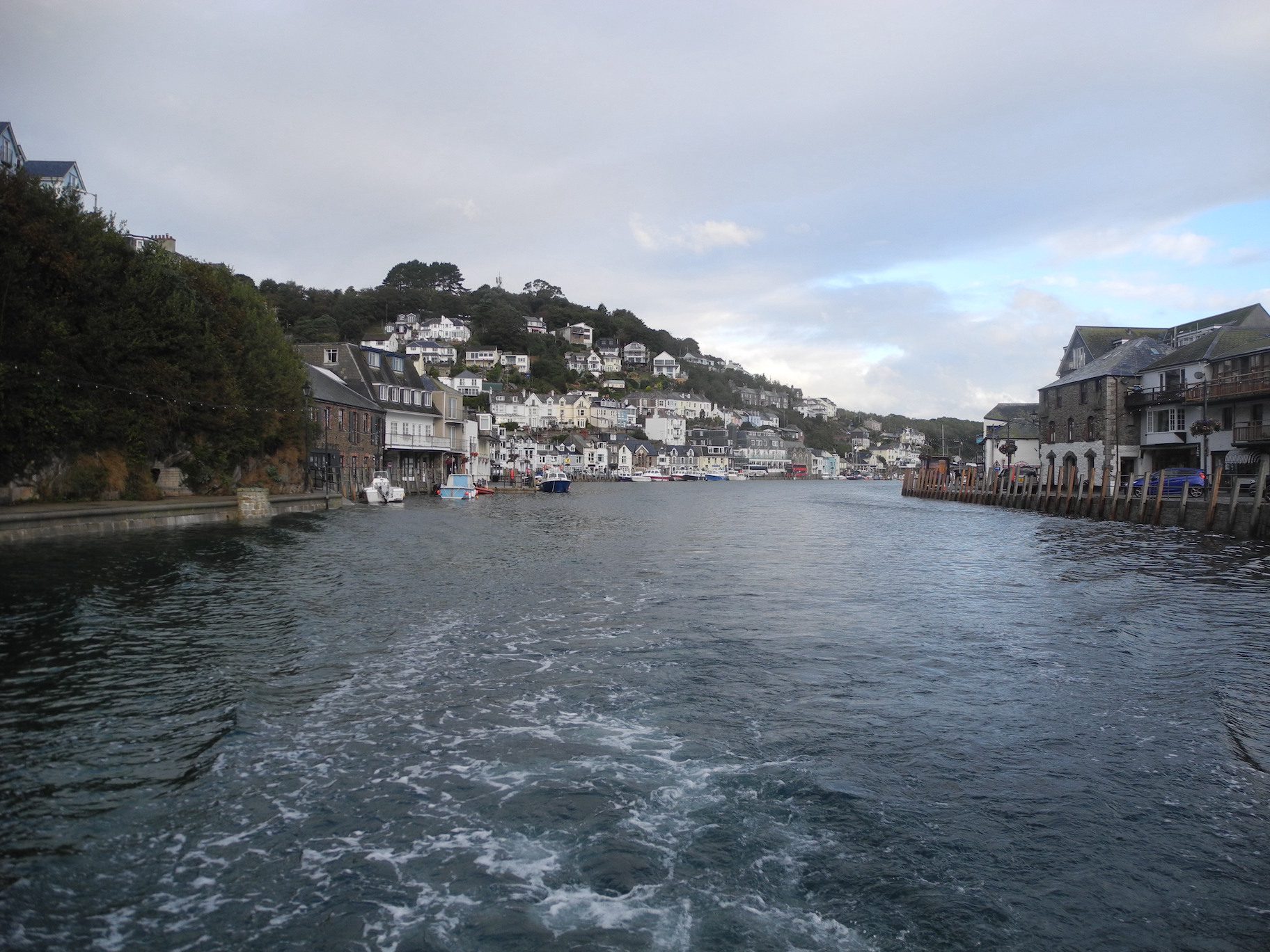
We were fishing from Dan Margetts Sowenna https://www.sowennafishing.com/about-us
The boat departed Looe harbour and passed the unique Banjo Pier where I had started my lifelong angling journey close to sixty years ago. I always relish the trip out to the fishing grounds with the splendour of the Cornish coast as a magnificent back drop. We passed the historic Looe Island that provides shelter for Looe and its foreshore.
Shortly after passing the Island, we stopped to catch fresh mackerel for the days bait. It was a joy to find them in abundance. Strings full of writhing mackerel were swung on board to be unhooked by a busy crew.
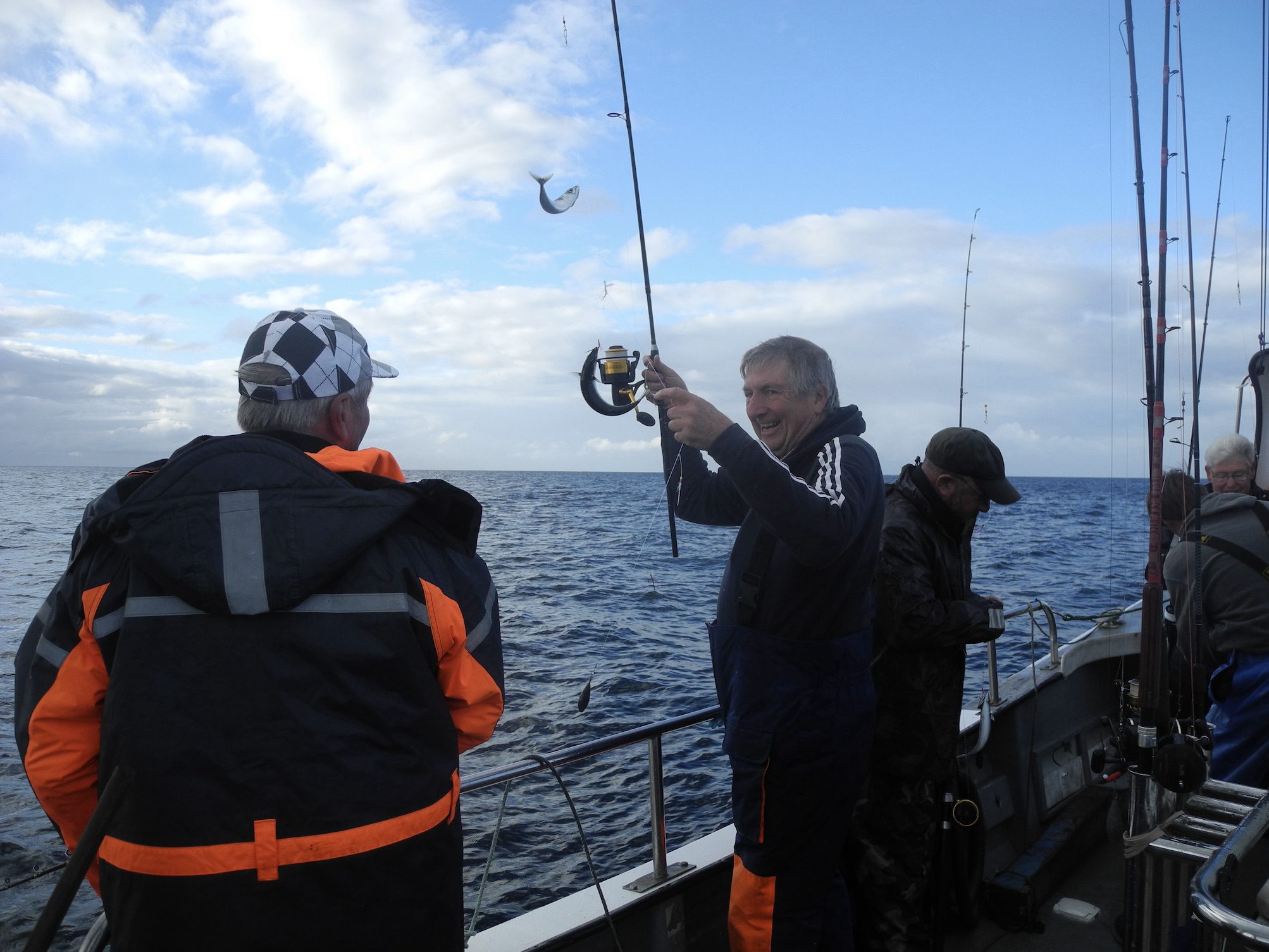
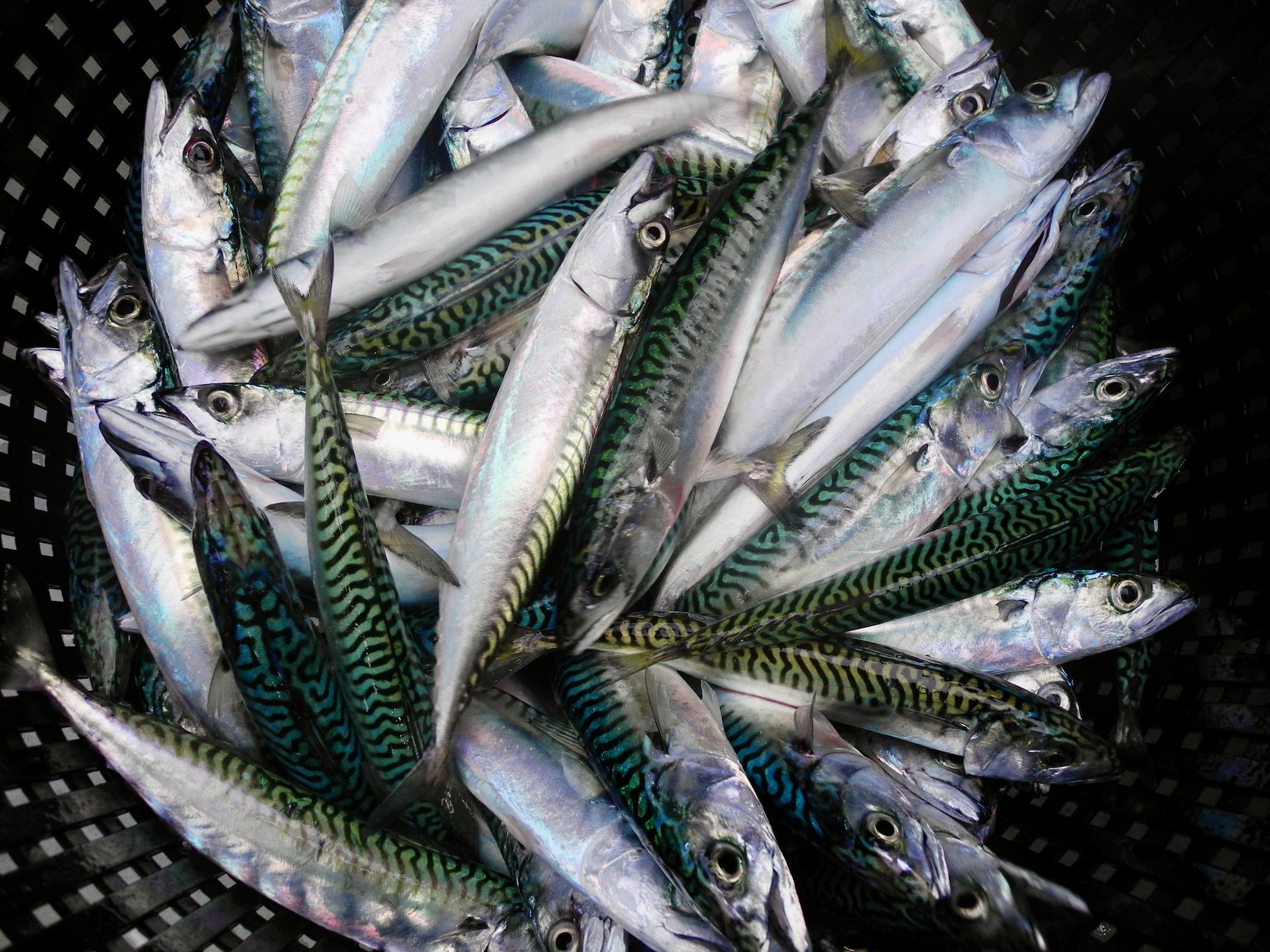
After catching a good supply of bait, we set off for a reef a couple of miles off the coast. As the boat bounced over the waves I caught sight of gannets diving in a feeding frenzy and thrilled at the sight of a tuna bursting out of the sea in a flurry of spray.
On arriving at the reef Dan throttled back and set up a drift. A variety of tackles and baits were employed. Live mackerel on long flowing traces, baited feathers and slow jig lures.
Within moments mackerel and scad were swung aboard along with whiting and pouting. Larger specimens proved elusive with no bass or pollock succumbing to the bigger baits and lures. After one more short drift Dan positioned the boat and lowered the anchor. The engine was cut and it was good to bob around in the lively sea as we lowered our baits. I elected to start off using small strips of squid on size 6 Chinu Sakuma hooks and fluorocarbon hook lengths. Within seconds of the bait hitting the bottom the light rods tip rattled and I reeled in a small pouting and small male cuckoo wrasse. Second drop and a better rattle on the rod tip resulted in a small red bream one of five i went on to land up to around 1lb. The last time I had caught red bream was on a reef fishing trip in the mid-seventies when they were a common catch. The species had declined with very few caught for several decades. A recent increase in numbers caught is encouraging. A handsome female cuckoo wrasse of close to a pound was also tempted with the small bait tactic.
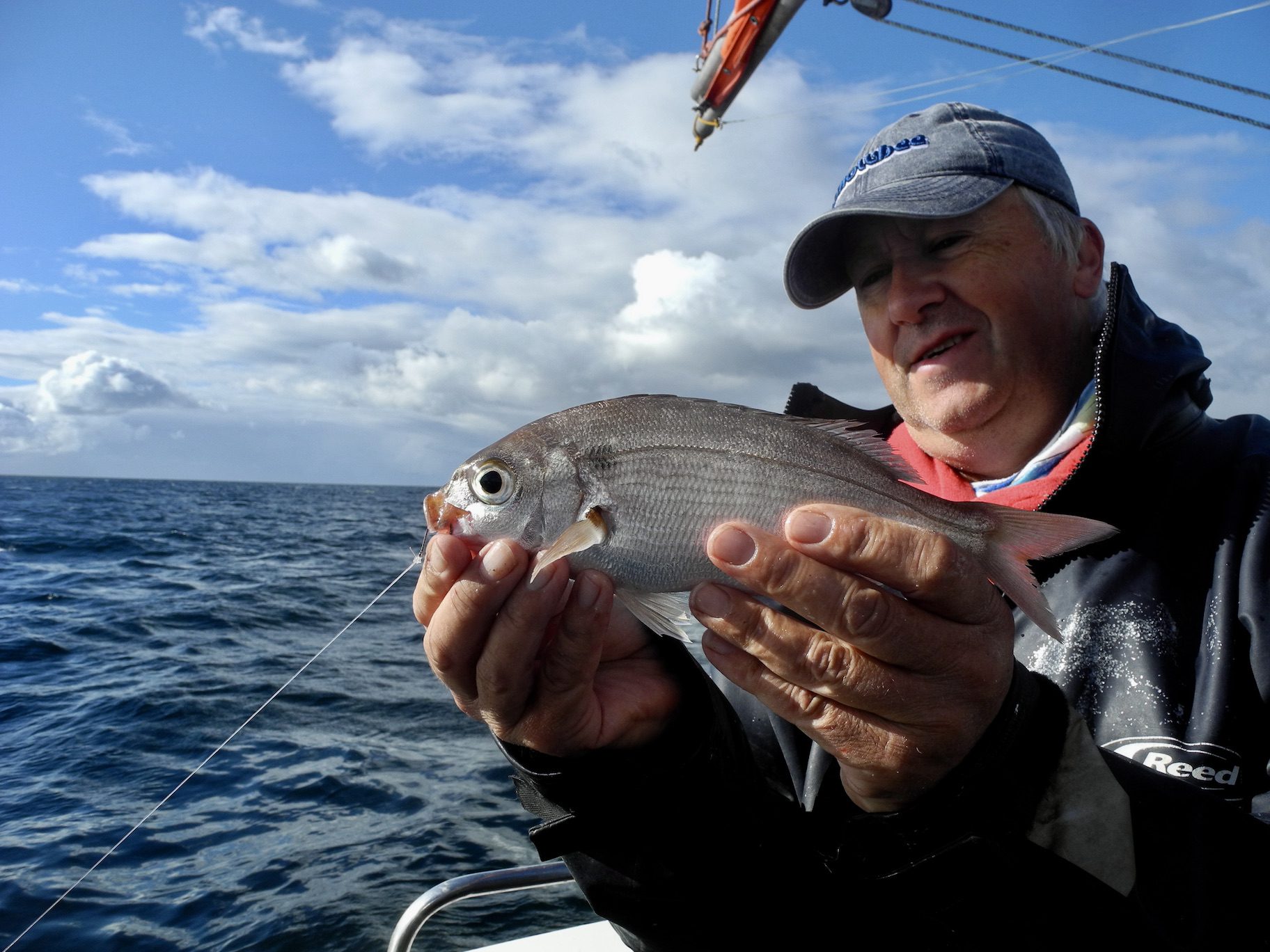
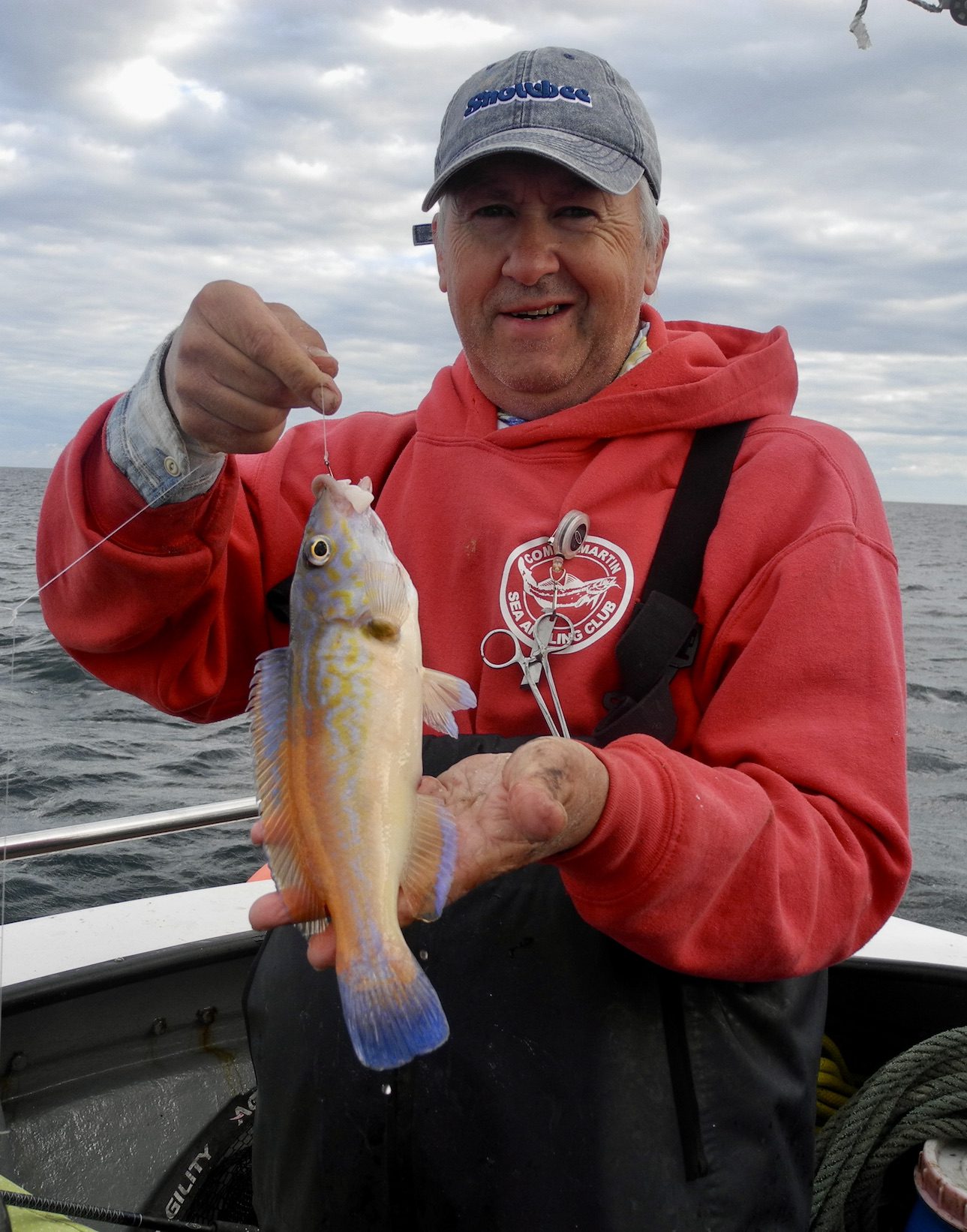
Mark Everard fishing closer to the cabin also tempted a brace of red bream his first of the species. Mark was also delighted to catch a huge scad that would probably have tipped the scales close to 2lb.
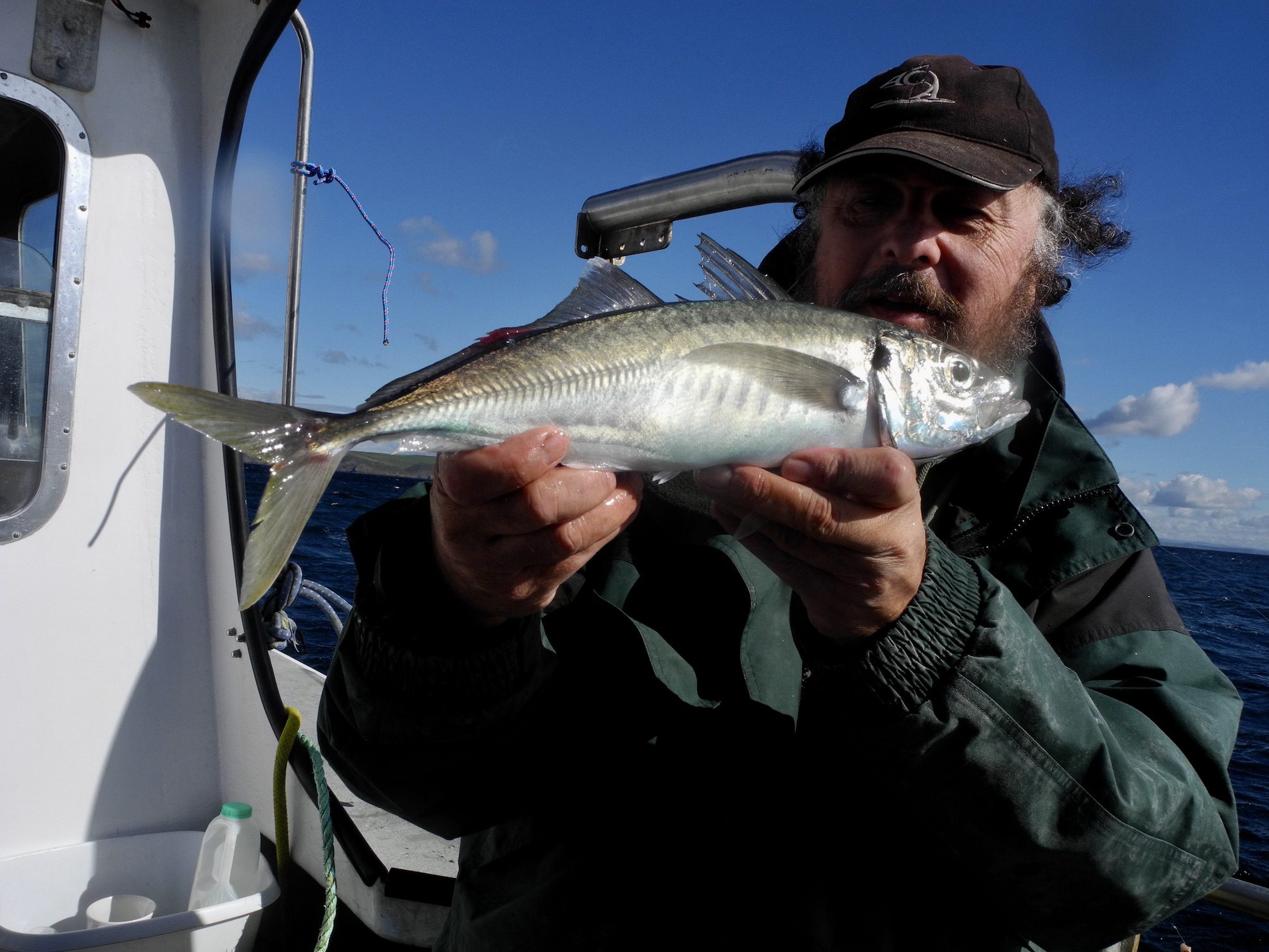
The sight of bent rods around the boat prompted me to send down a larger bait. A mackerel flapper on a 10/0 Sakuma Manta was lowered to the sea bed and was soon devoured by a conger of around 10lb. Conger sport continued and I watched my fellow anglers rods bending in a typical scene of traditional deep sea boat fishing.
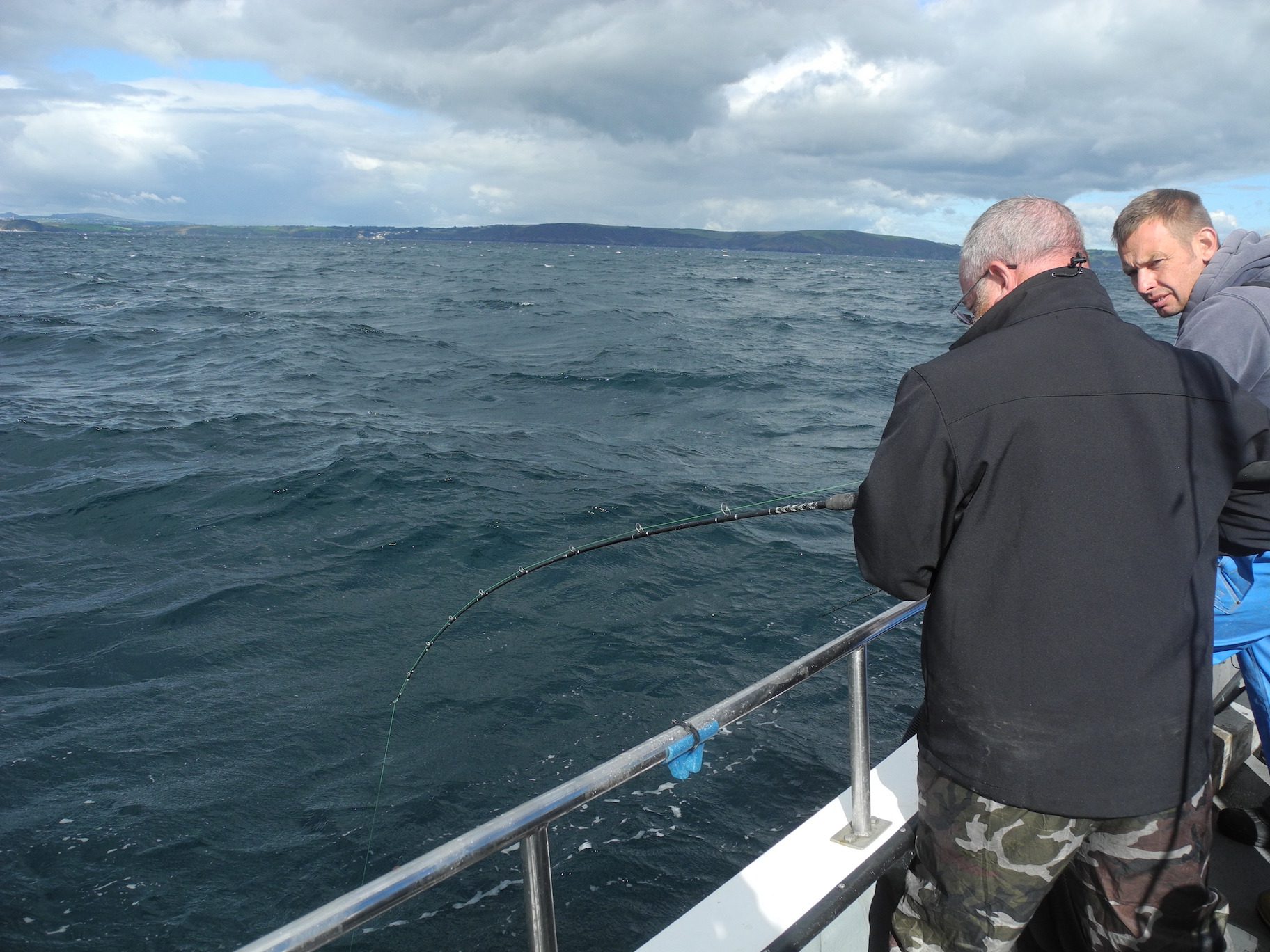
For the following hour or two conger, wrasse, scad and pouting were caught as regular teas and coffees were delivered by Dan and his helpful deckhand.
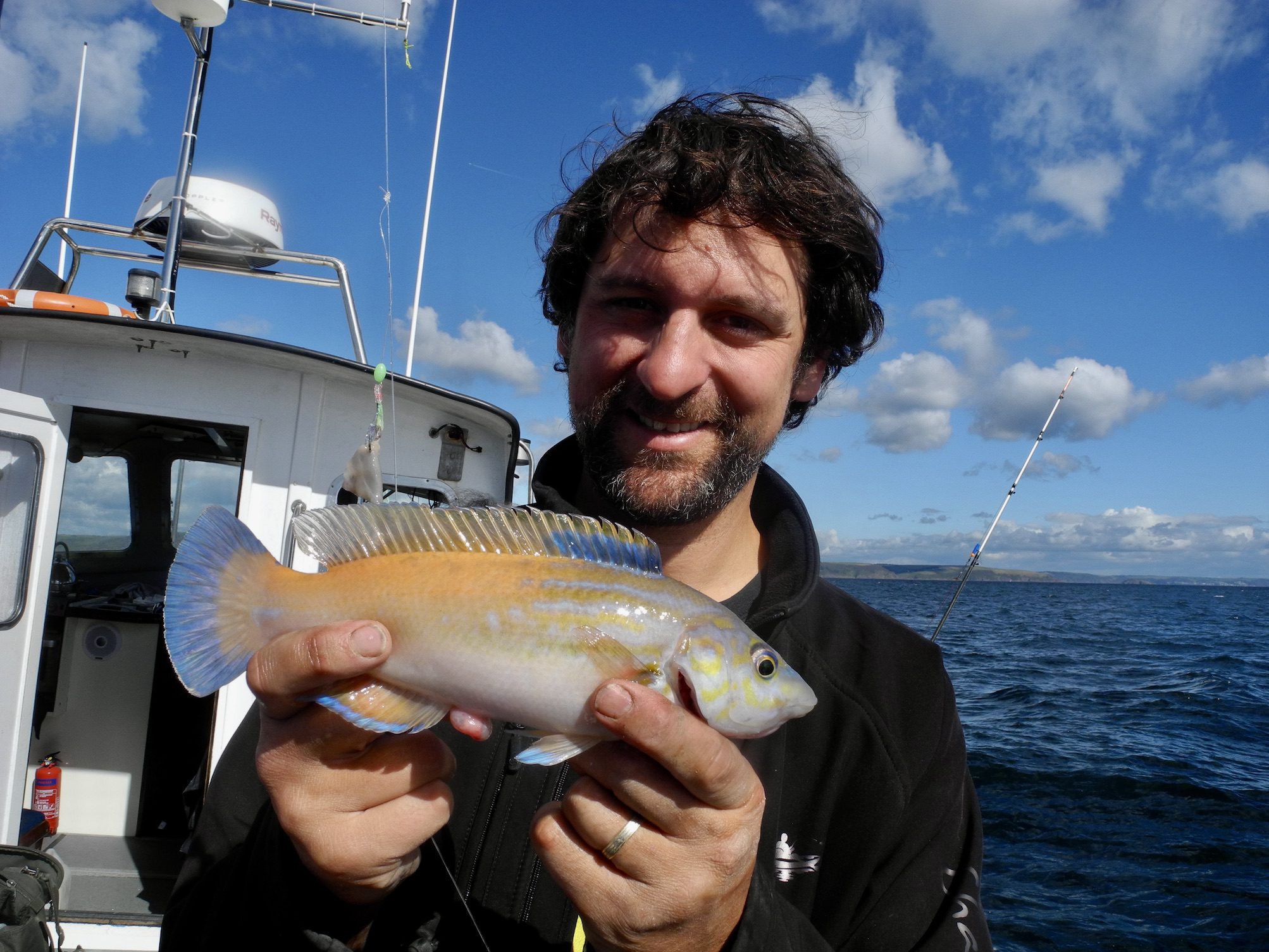
As the day drifted past Dan discussed an option to try a new mark close inshore where he had received reports of specimen small eyed ray. Ray are not a common feature of boat catches off this part of Cornwall and with a brisk North West Wind buffeting the boat the sheltered waters close to the coast seemed worth a try.
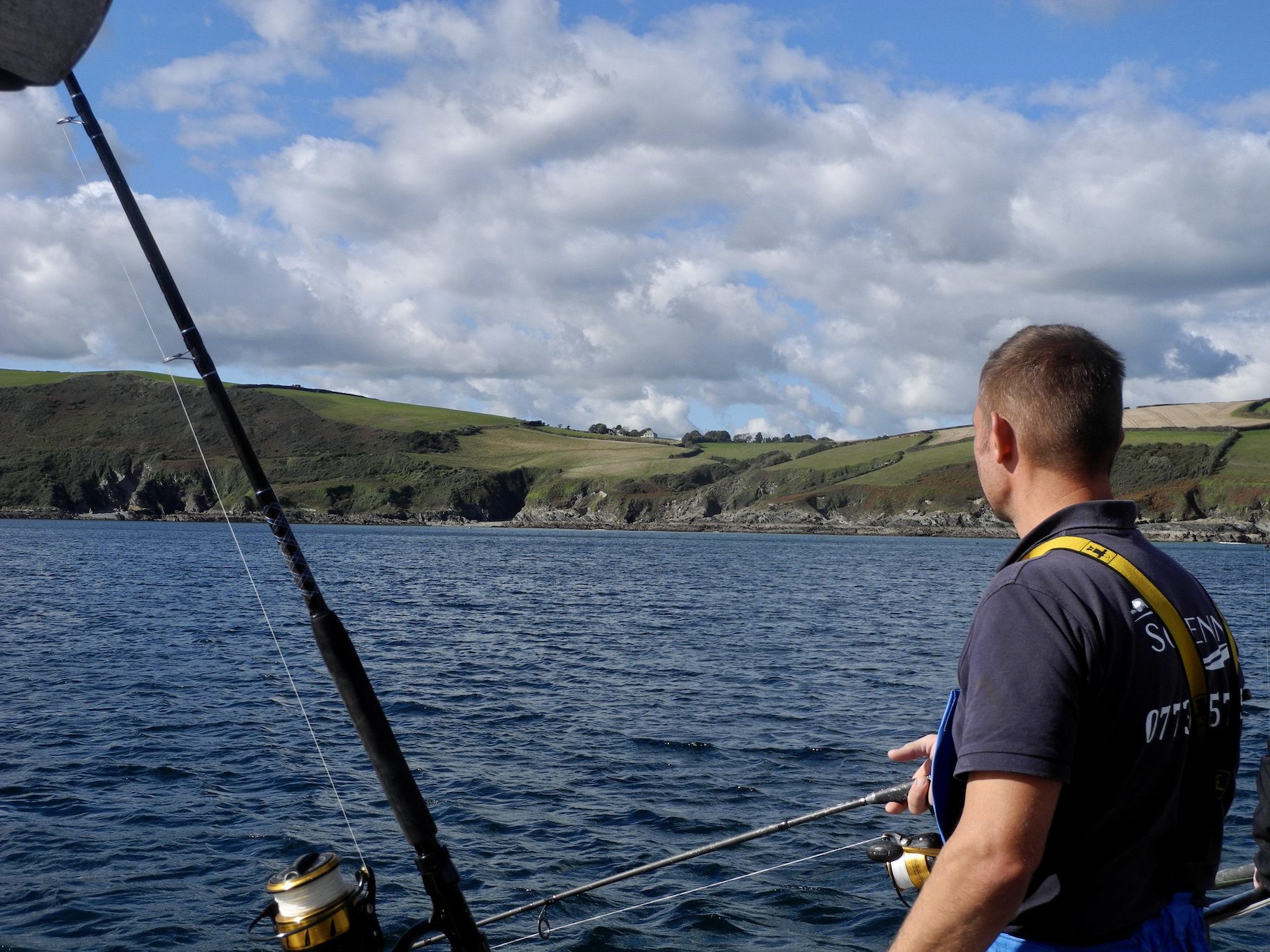
Dan set off and we were soon anchoring over clean ground just a few hundred yards offshore. It was good to survey the rocky shoreline from the boat places I had visited on coastal walks with Pauline on numerous occasions over the years. The area undoubtedly had huge shore fishing potential and I couldn’t help formulating plans to one day visit and fish. There are so many places to cast a line in this world and so little time!
I tried small baits first on my light rod hoping to tempt something different. Whilst I like catching small eyed ray they are abundant up off the Somerset coast and if I want to catch them I can go to Minehead. A mackerel seized my small squid strip and was swung aboard and added to the bait store.
On the opposite side of the boat Keith Armishaws rod took on an impressive curve as something large pulled back on the end of the line. We all watched in anticipation as the battle ebbed and flowed. The head of a large conger estimated at between 30lb and 40lb appeared and writhed at the side of the boat. I suggested we get a picture but the trace failed as Dan tried to pull the fish through the gate. This counted of course as the trace had been touched.
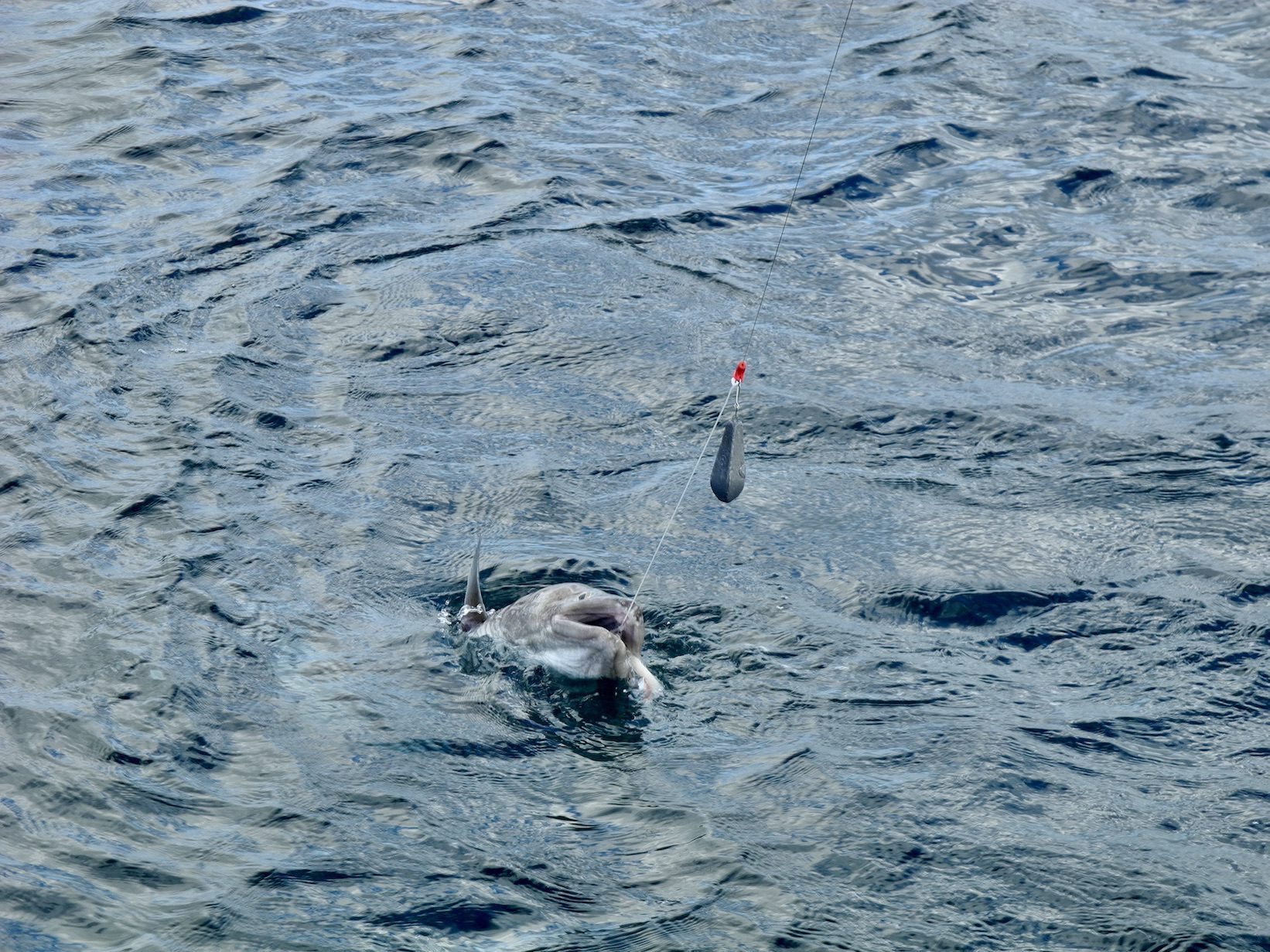
Dan is a very keen skipper and works hard to try and find fish willing to experiment to build on his already extensive experience. When it became clear that sport was slow close inshore it was back out to drift the reefs once more. Sport soon resumed with wrasse, mackerel, pouting and scad.
Dan suggested we try one more mark on the way back to Looe. By now it was late in the day and the afternoon sun illuminated Looe Island. Gannett’s dived into the calming waters. A short drift brought a few mackerel and a large pouting succumbed to my slow jig.
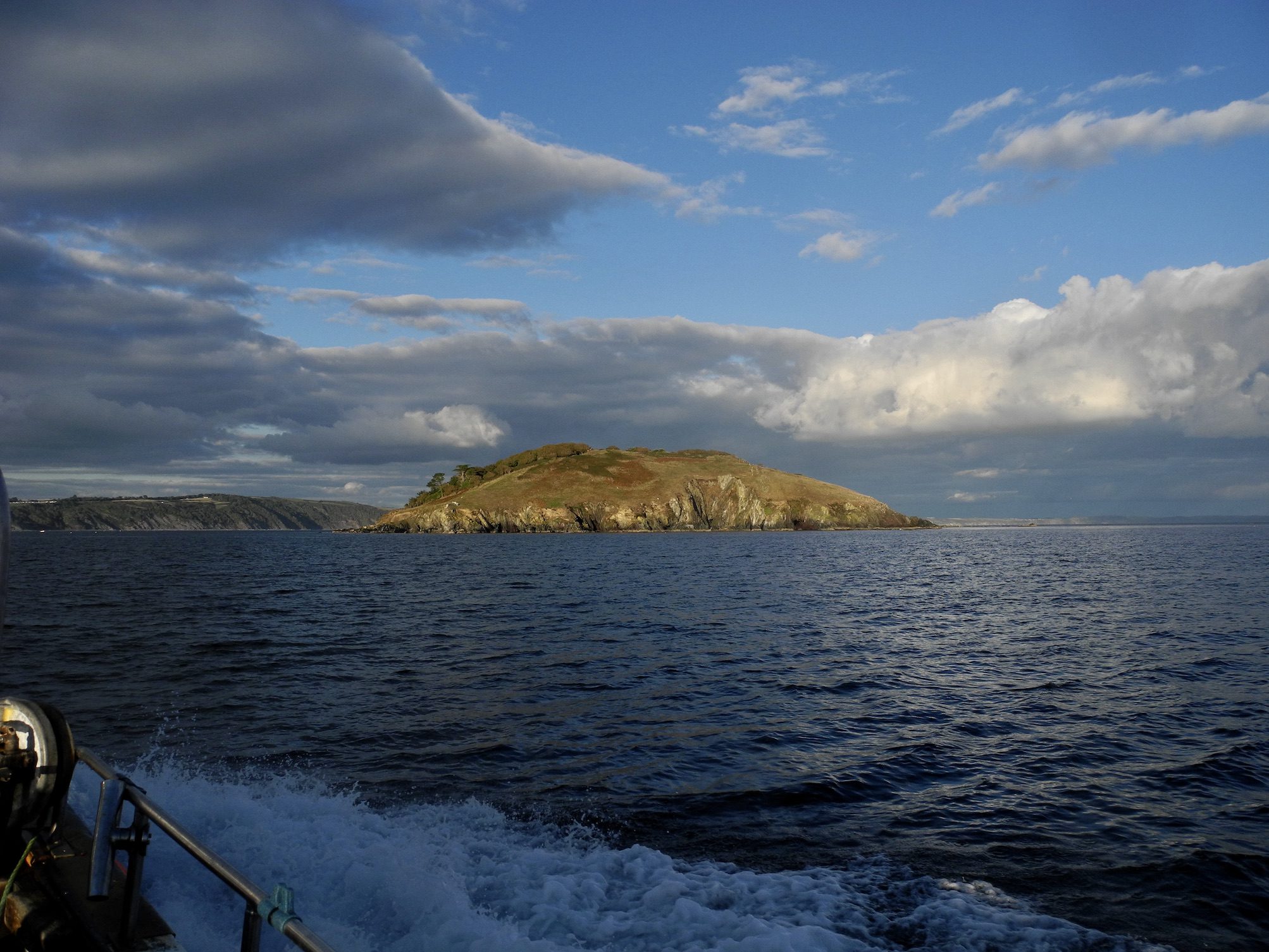
Sowenna bounced back towards Looe and we chatted about the day and past and future trips. Seagulls wheeled and turned behind the boat as a few fish were filleted for the table. The ride home after a day’s fishing as the light fades is something I always savour as I gaze back into the boats wake.
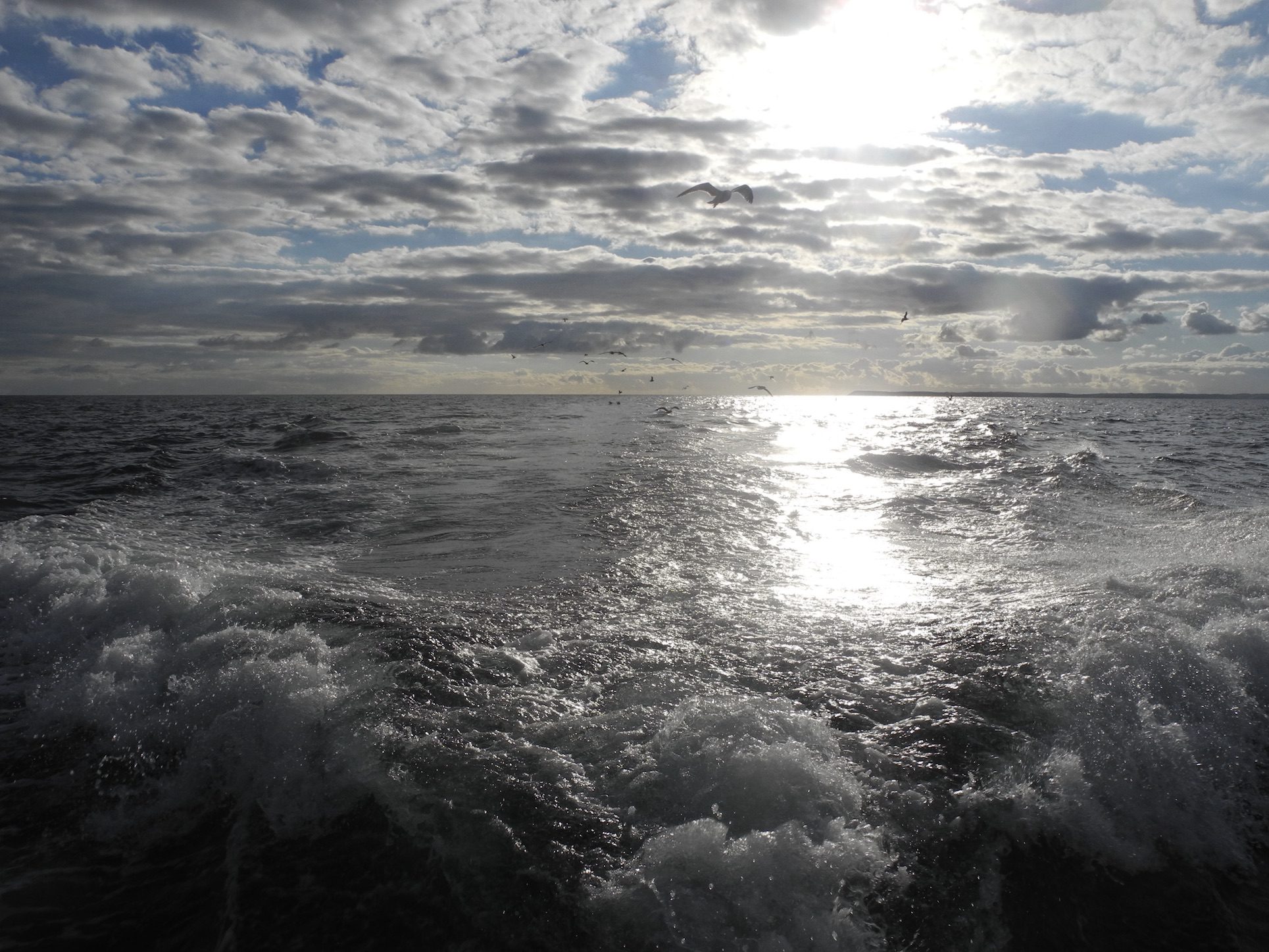
The tide was well in as we chugged into Looe and its familiar lively harbour.
I walked back towards the car park with Dom and Mark chatting about our trip. All three of us reflected upon an enjoyable day but all conceded that a dabble after large gobies with LRF tackle had perhaps been the highlight of the trip a chance perhaps to rekindle a connection to childhood adventures beside the sea.
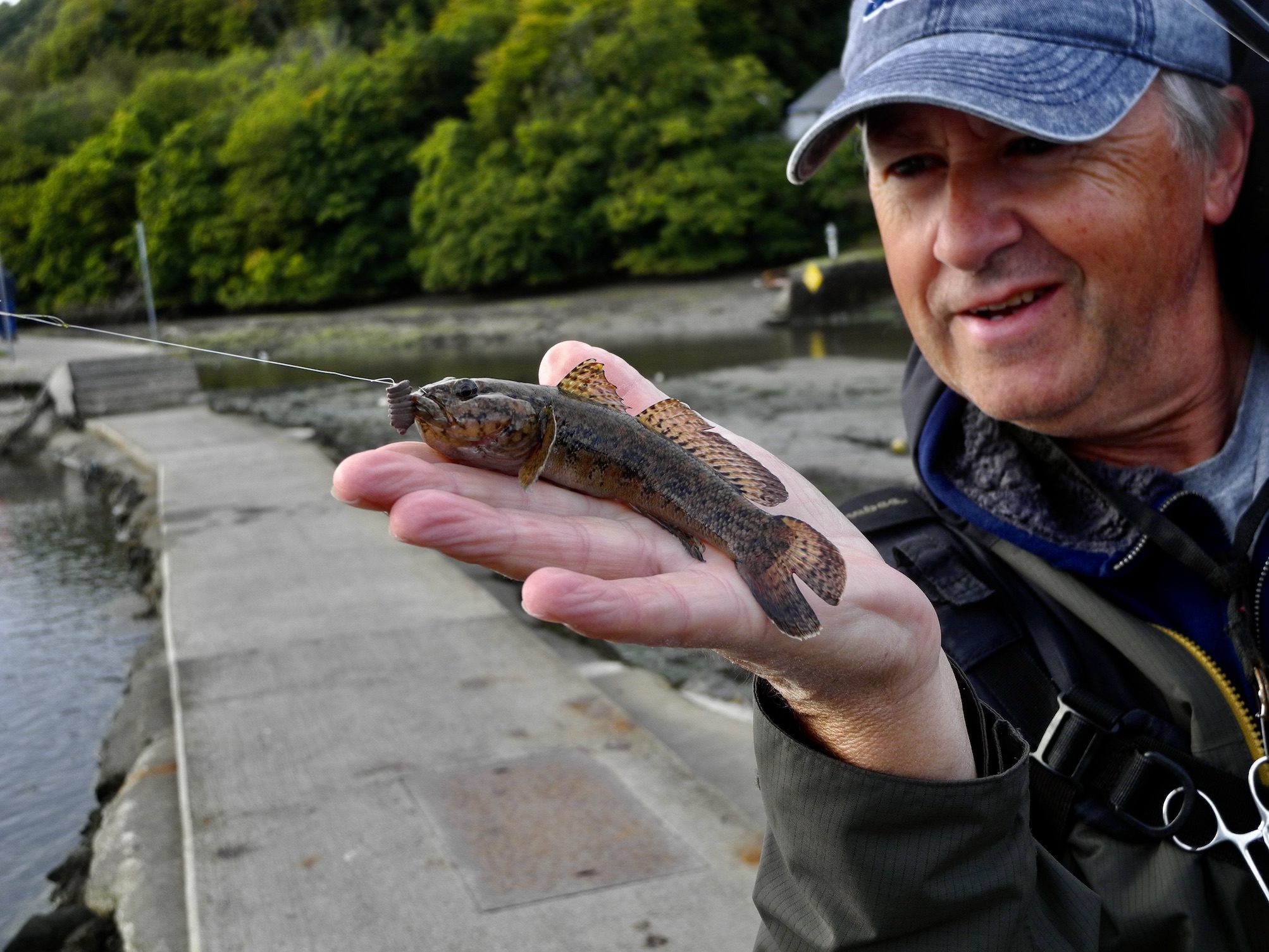
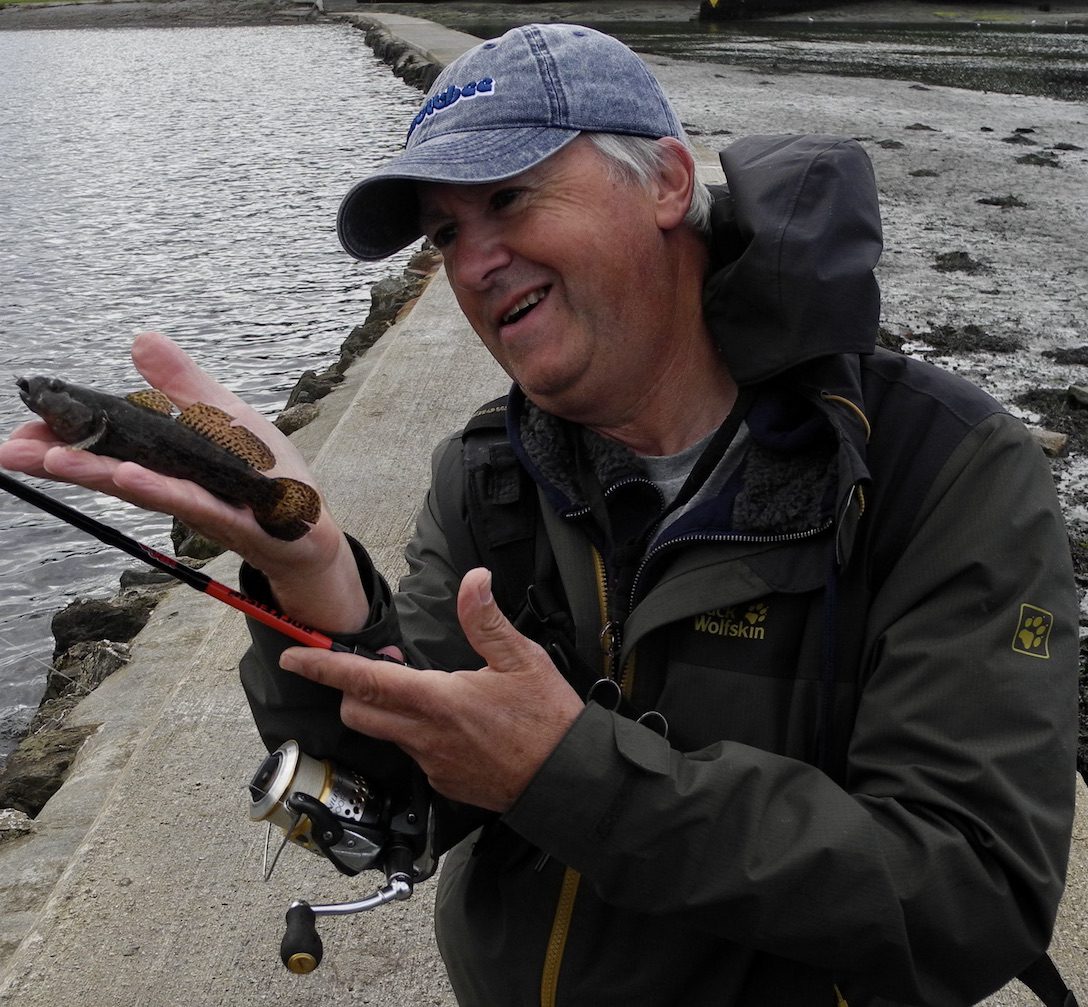
The Half Moon Inn at Sheepwash has long been at the heart of the River Torridge angling community and a meeting place for the River Torridge Fishery Association. Many of the anglers who visit the Torridge to cast a line have been visiting for decades migrating to this old fishing Inn in Spring and Autumn.

In Springtime the AGM greets a new season, plans are made for the coming months as swallows arrive to swoop over the spring countryside as life springs forth after winters chill. In early Autumn fishers return for the annual dinner as the swallows depart reflecting upon the season just past.
The salmon season of 2022 will go down in history as one of the worst on record with a long drought keeping the river low throughout most of the season. Fortunately, the Torridge angling community is still bound by its traditions and the Half Moon Inn is an integral part of that bond. Fishing Inns are sadly dwindling along with the iconic salmon that face an uncertain future as many factors combine to thwart a heroic drive to survive.
Pauline and I sat down with forty guests to enjoy a delicious meal sharing stories of life, fishing and the Torridge. Joining the association this year was author Mark Wormald whose excellent book ‘The Catch’ I read earlier this year. The book delves back into the life of the late Ted Hughes, poet Laurette who fished many waters with passion the Torridge being one of his favourite haunts. It was good to chat briefly with Mark about his book that is available to buy at the Half Moon where 50% of any purchase will be donated to the River Torridge Fishery Association. Mark pays several visits to the Half Moon throughout the books narrative with Charles Inniss and Adam vital stars of the books strong cast of characters.
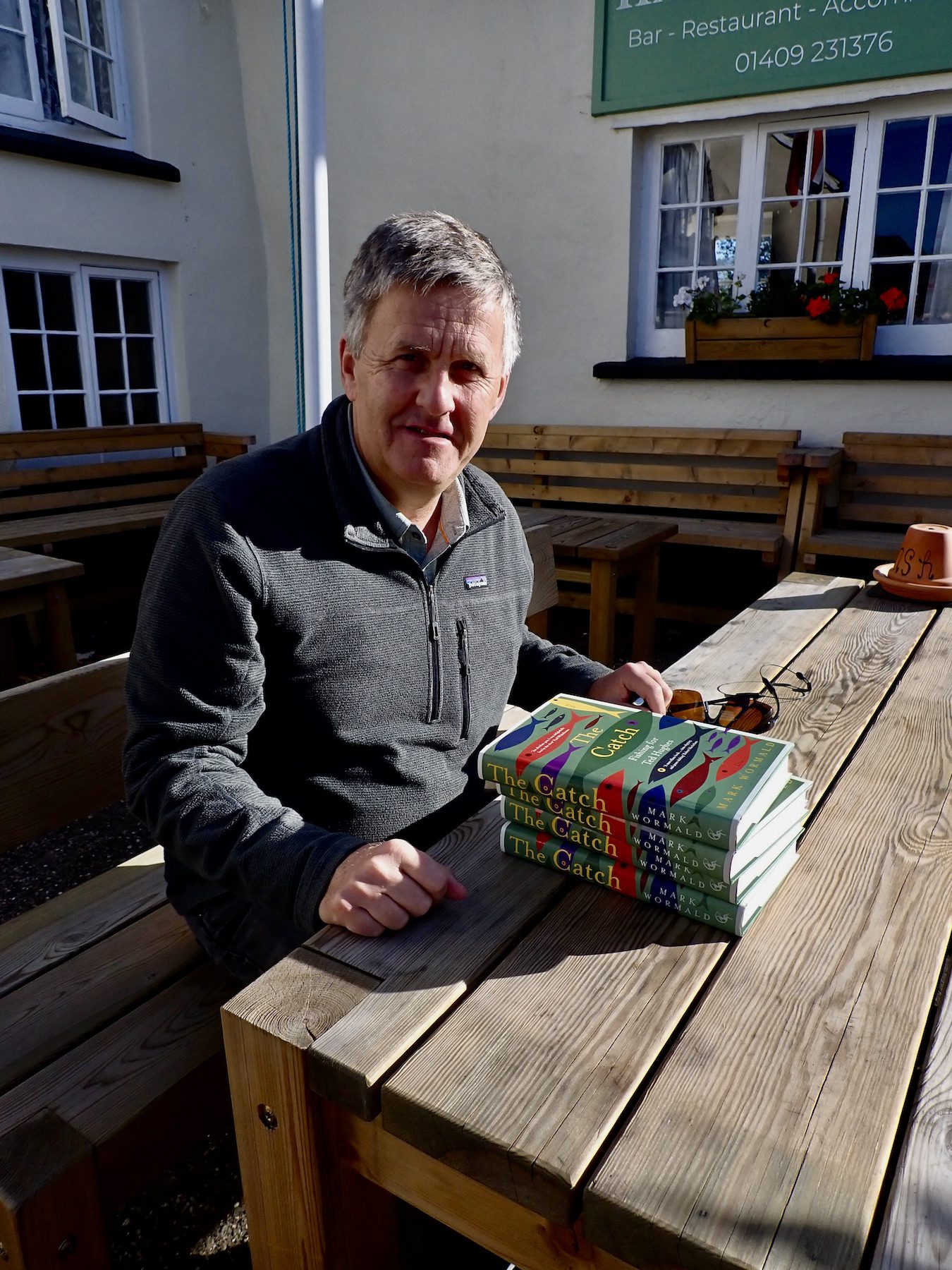
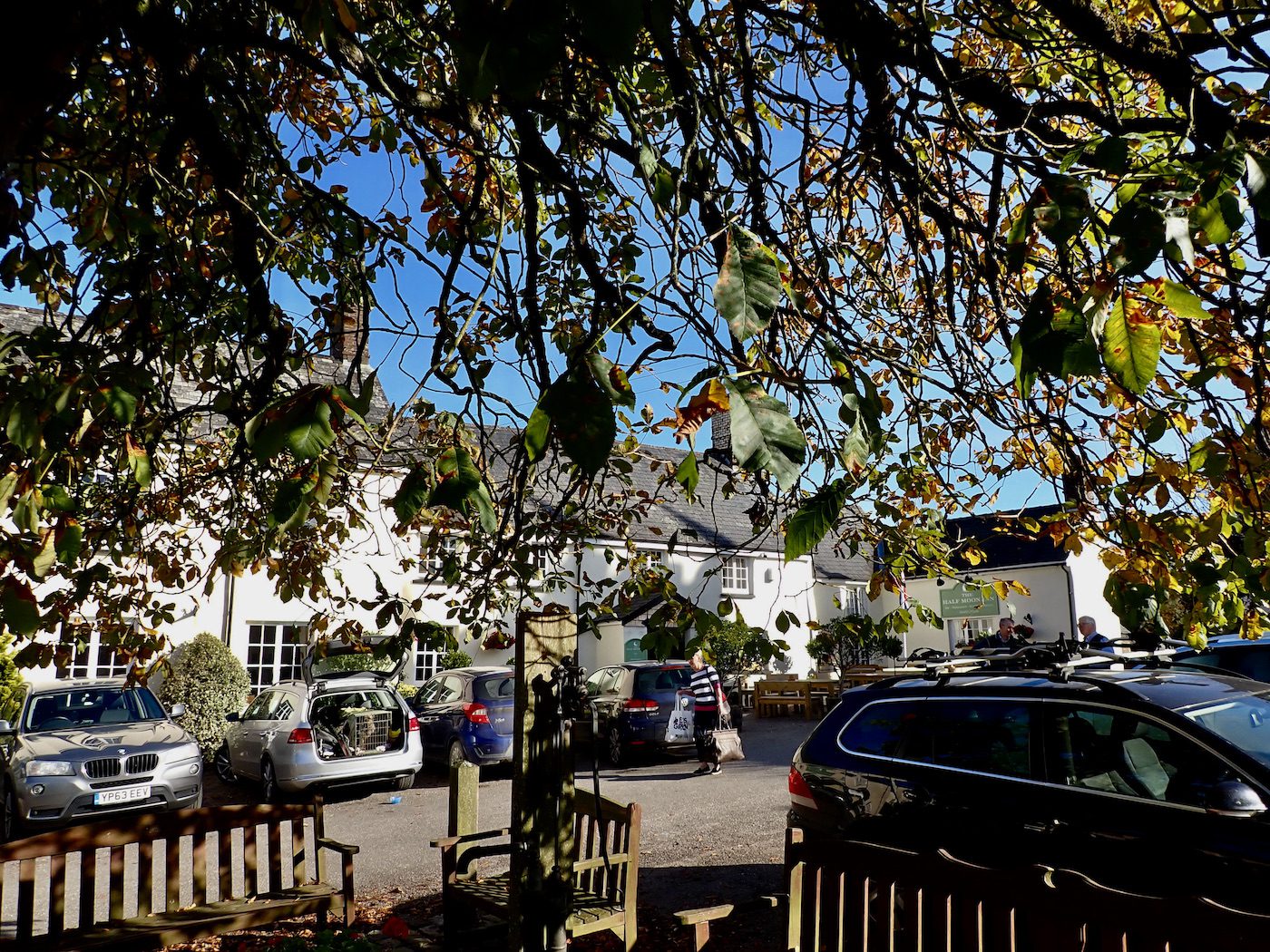
Whilst stories of recent fish were scarce fish from other tributaries of angling provided vital piscatorial content with carp, bass, perch and the occasional trout peppering discussions.
As Pauline and I left on the Sunday morning Autumn sunshine illuminated the village square. I paused to note the plaque that commemorated the Coronation of Her Majesty Queen Elizabeth Ⅱ 1953. It seemed rather poignant to note this just a week after Her Majesty’s Funeral.


Just a few days remain of the 2022 salmon season on the Taw and Torridge and soon it is hoped rain will fall swelling the rivers and bringing salmon forging to the redds that will ensure the future of both salmon and the community that is brought together by their presence in the rivers.
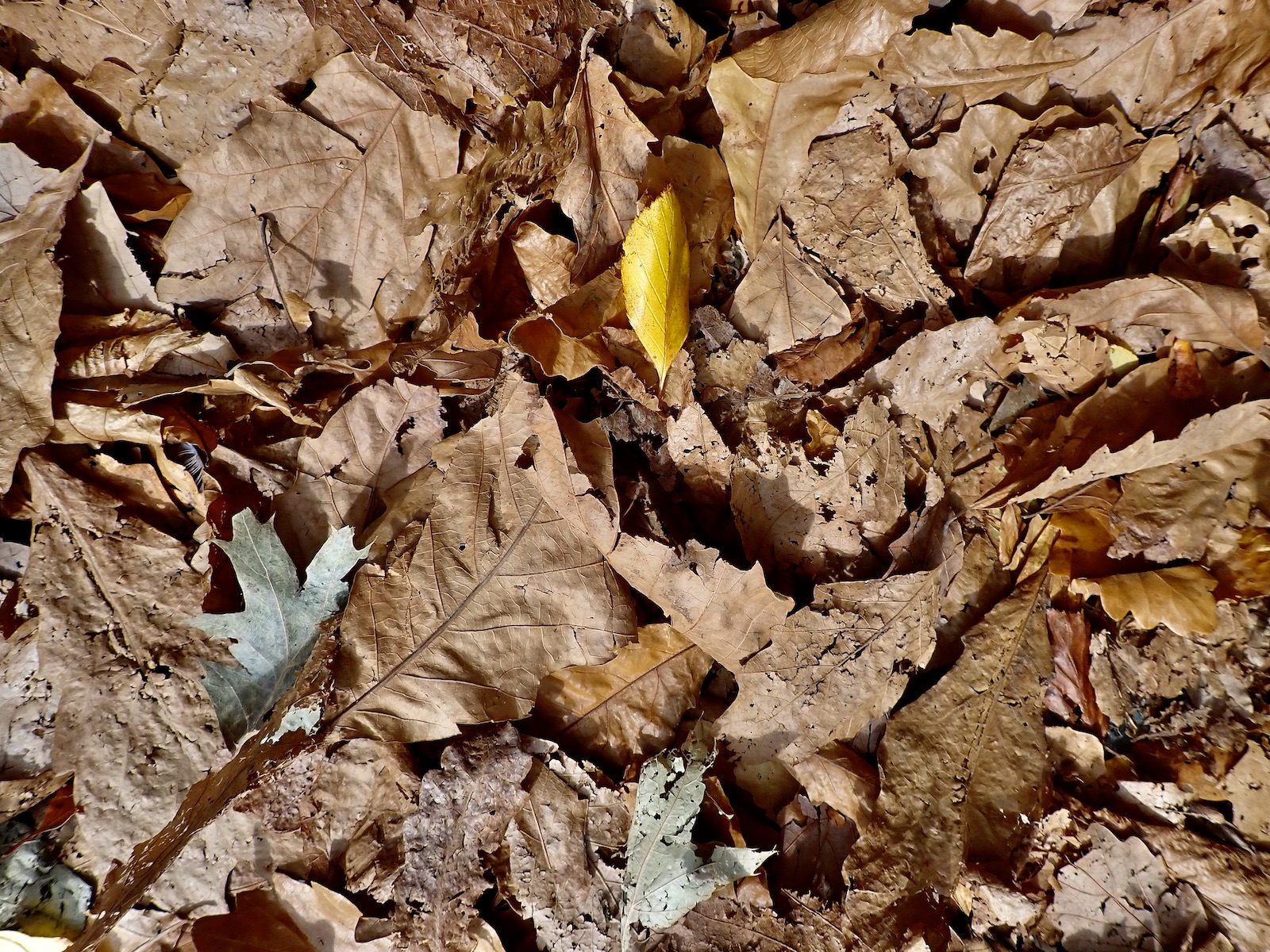
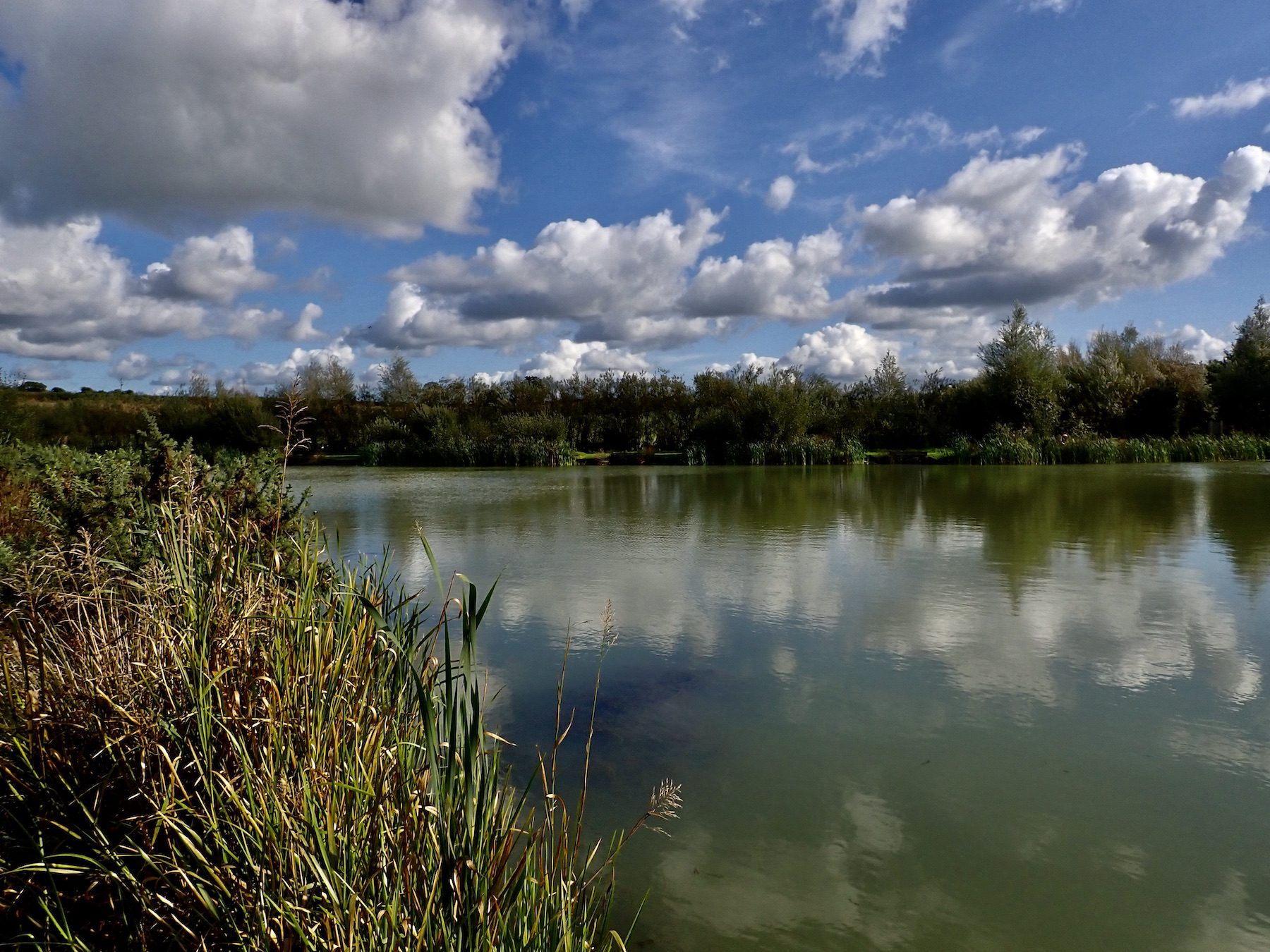
Earlier in the Summer I had enjoyed some success with carp on the Fly at the club Lake so before the Autumn set in I was keen to once again try my hand with the fly. A brisk North wind was blowing as I arrived at the Lake with white clouds scurrying across a blue sky. The occasional swallow swooped over the water a sight I savoured knowing that in a few weeks they will swooping over the vast plains of Africa where buffalo, Lions and elephants roam.
I had come armed with a 7/8 weight Fly Rod, a floating line and a 10lb leader. A deerhair Fly tyed to imitate a dog biscuit was tied on. I catapulted a steady stream of Krill floaters on the lake and watched the water carefully. I was concerned that the cool wind would put the fish down but within a minutes a few carp started to slurp down the loose offerings.
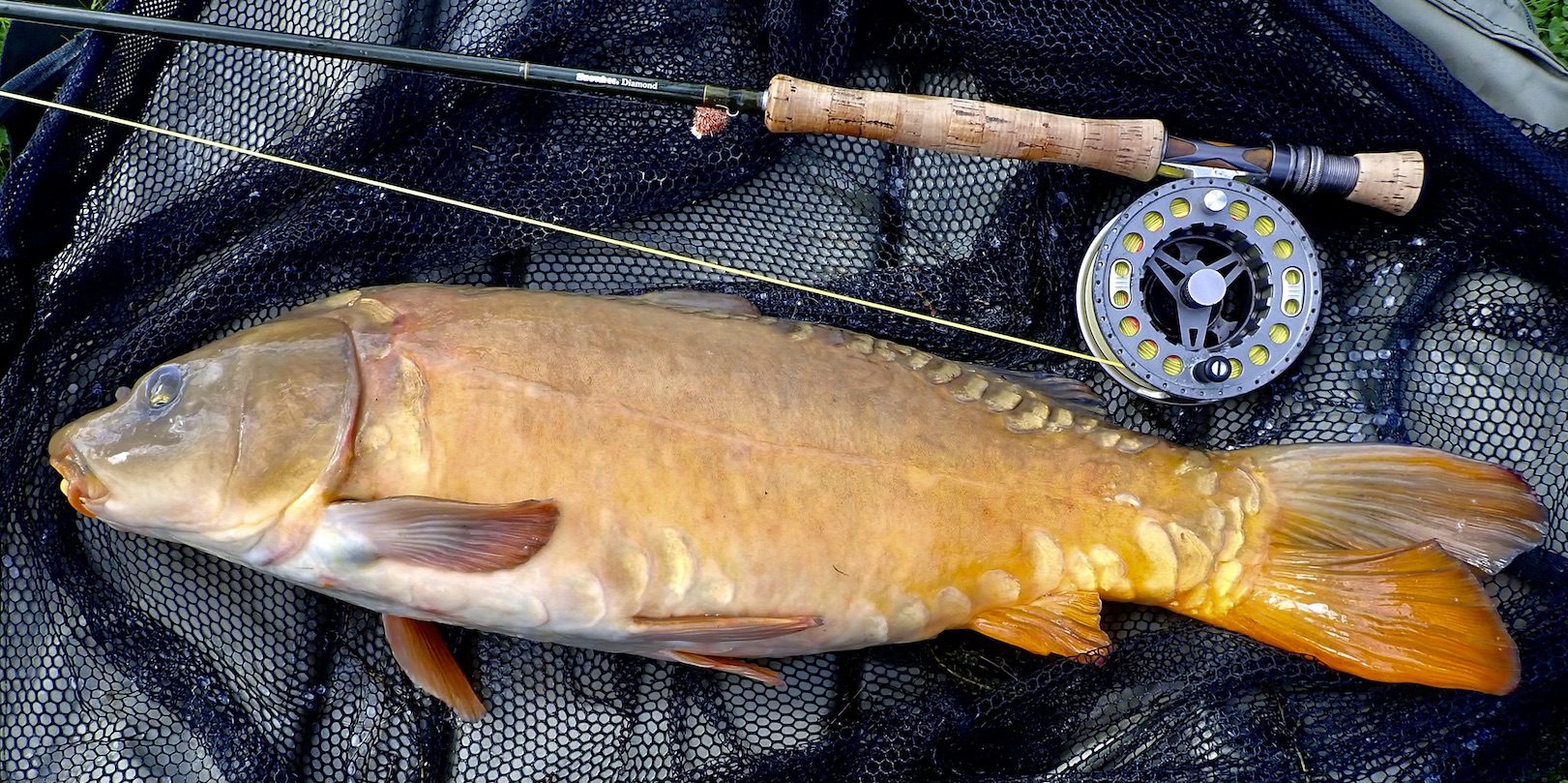
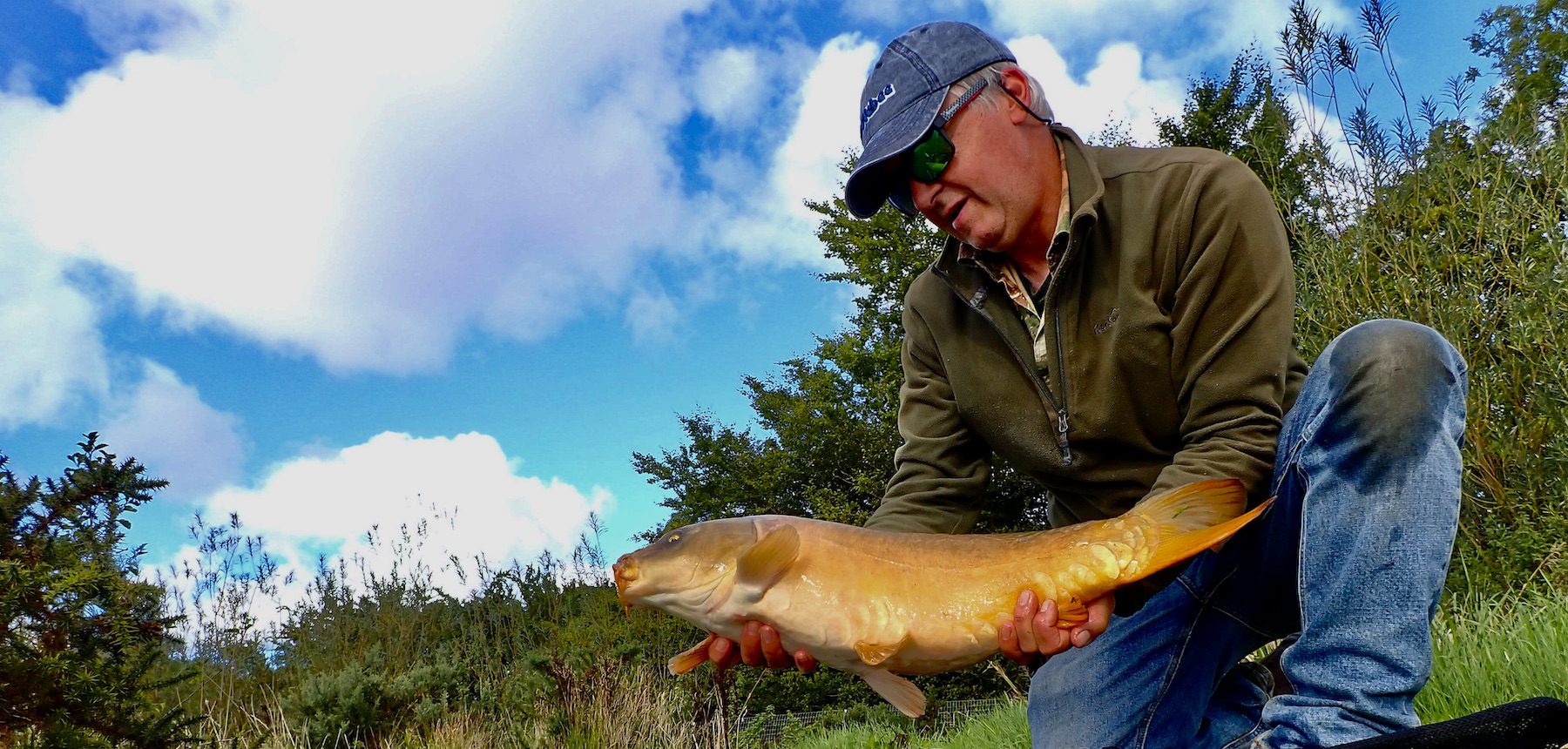
Once the carp were feeding confidently I put out the fly and waited in anticipation. I didn’t have too long to weight before carp appeared and sucked in my fly. I strip striked and was thrilled to feel the power as the carp surged away. I kept a tight line putting on as much pressure as I dared allowing the line to cut through the dense weed. After a tussle the a mirror carp of around 13lb was safely in the net its bronze and gold flanks a refection of the coming season.

After landing the carp I had to wait another half an hour before the carp began to feed again. A low double succumbed after missing numerous takes as the carp seemed to have an uncanny knack of ejecting the fly before I could set the hook.
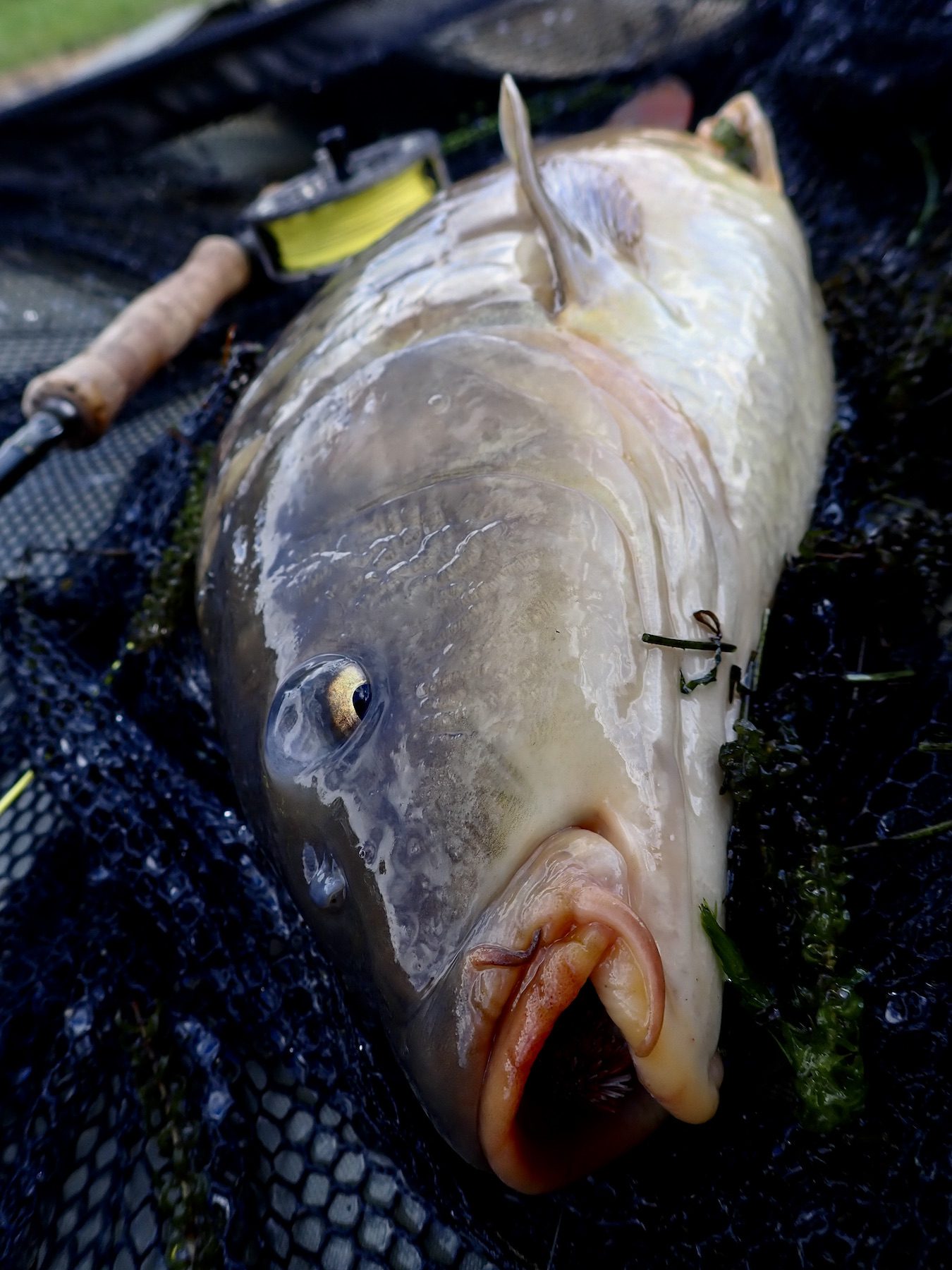
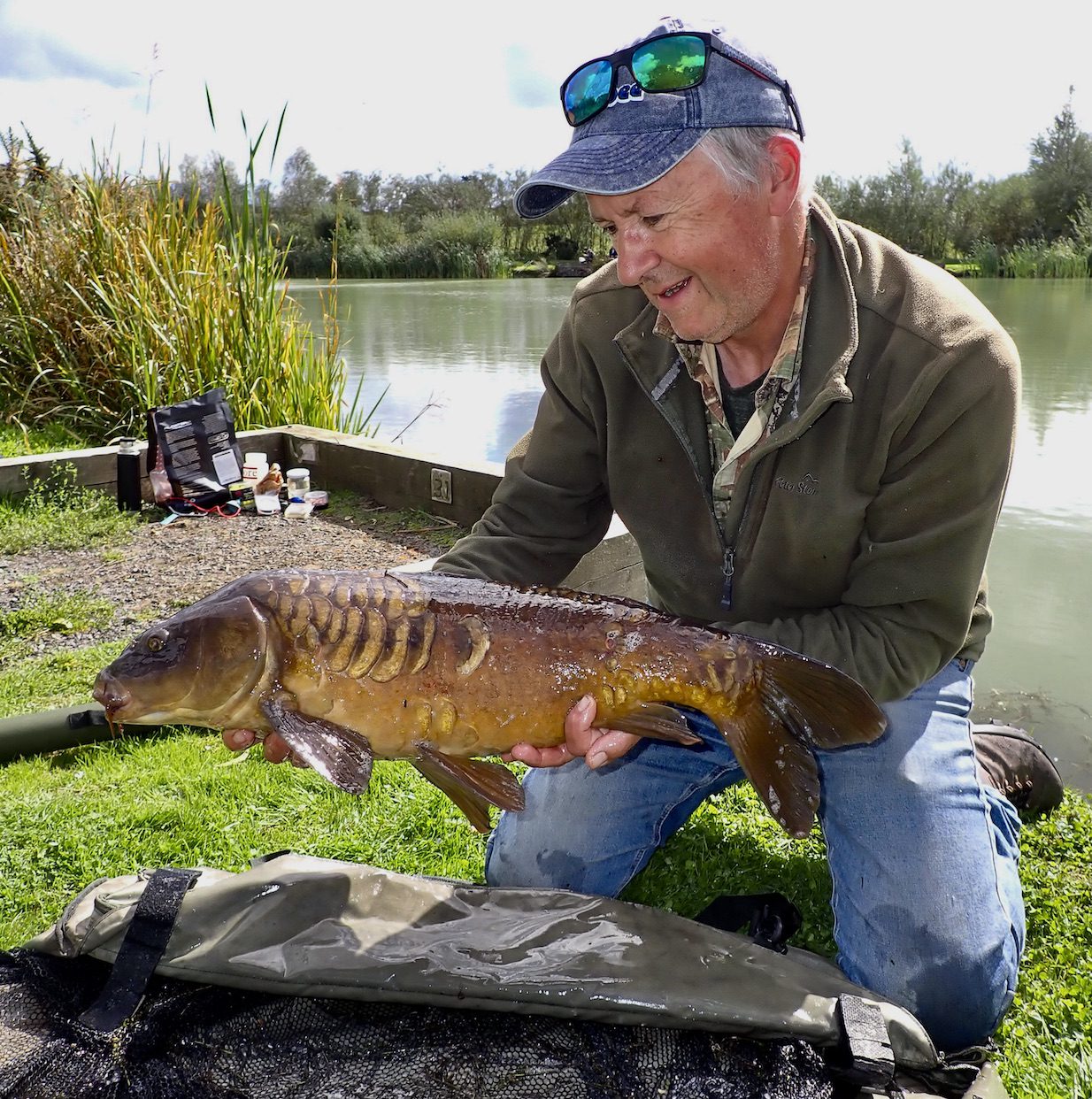
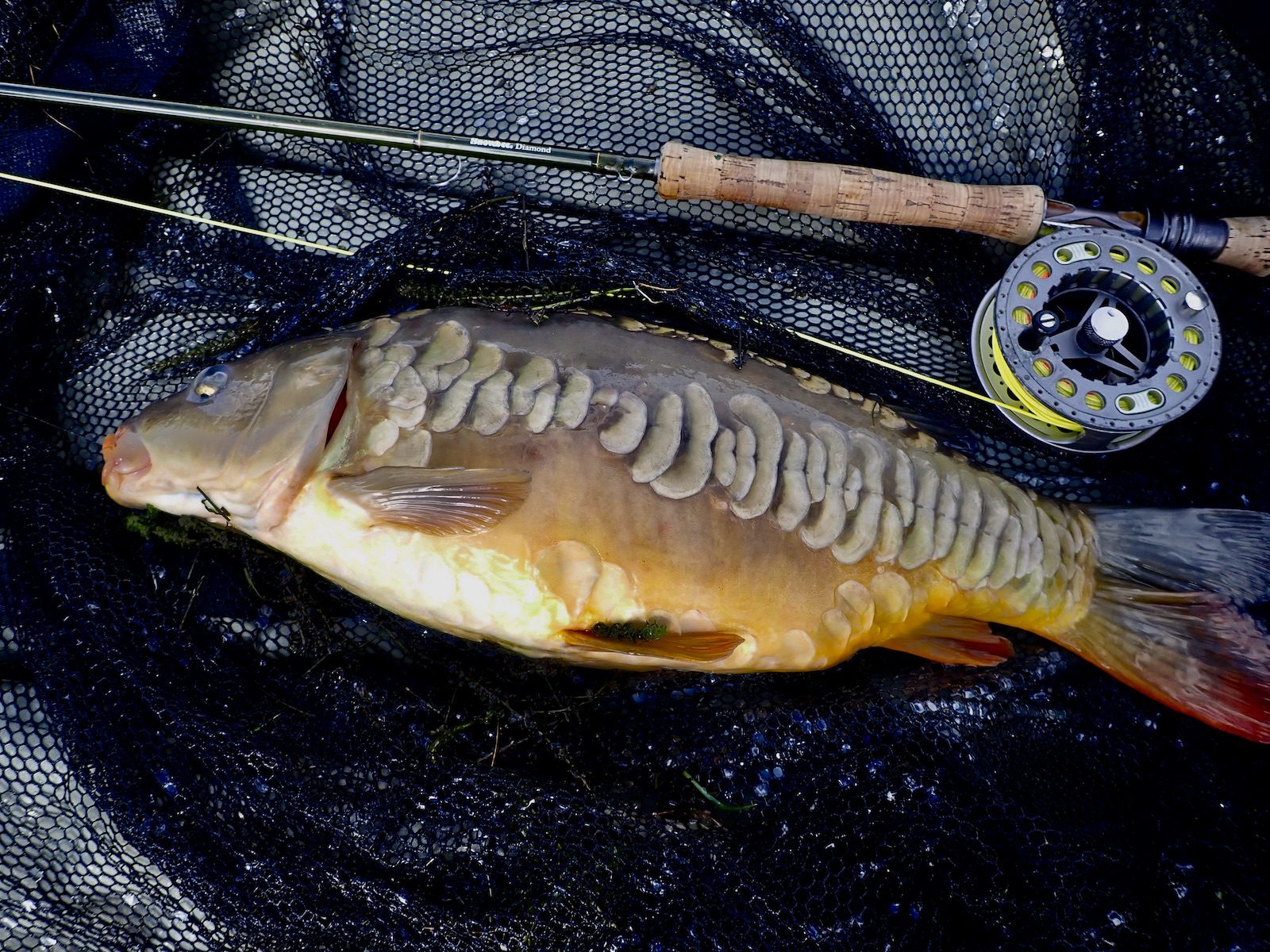
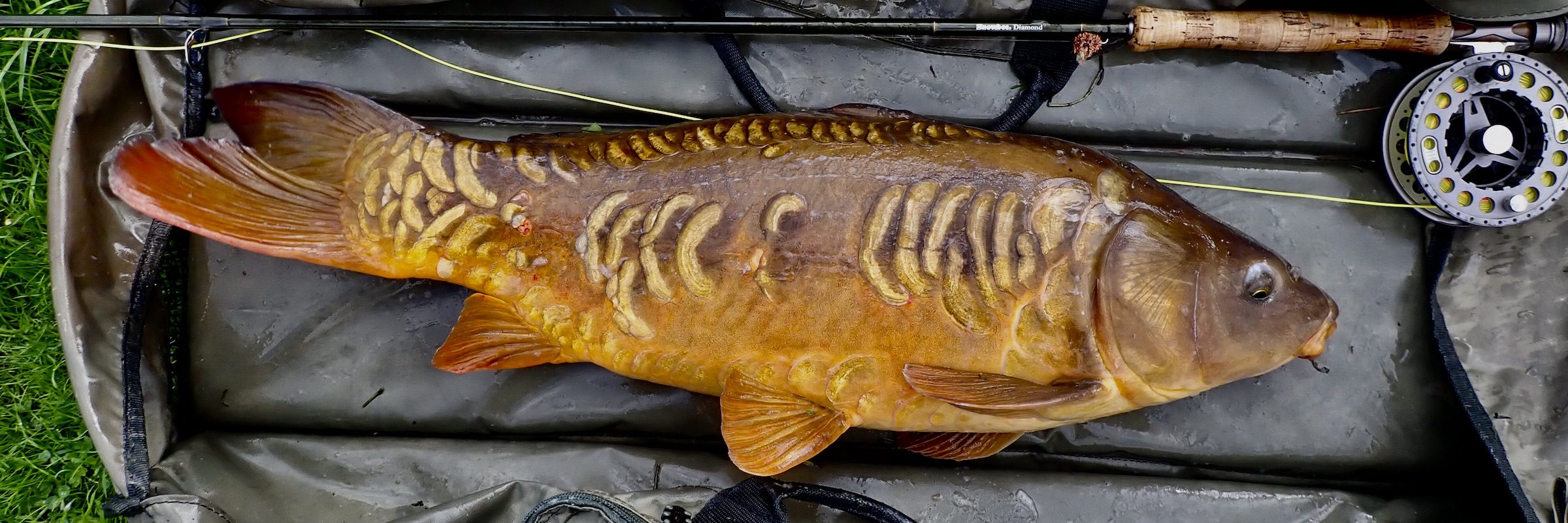
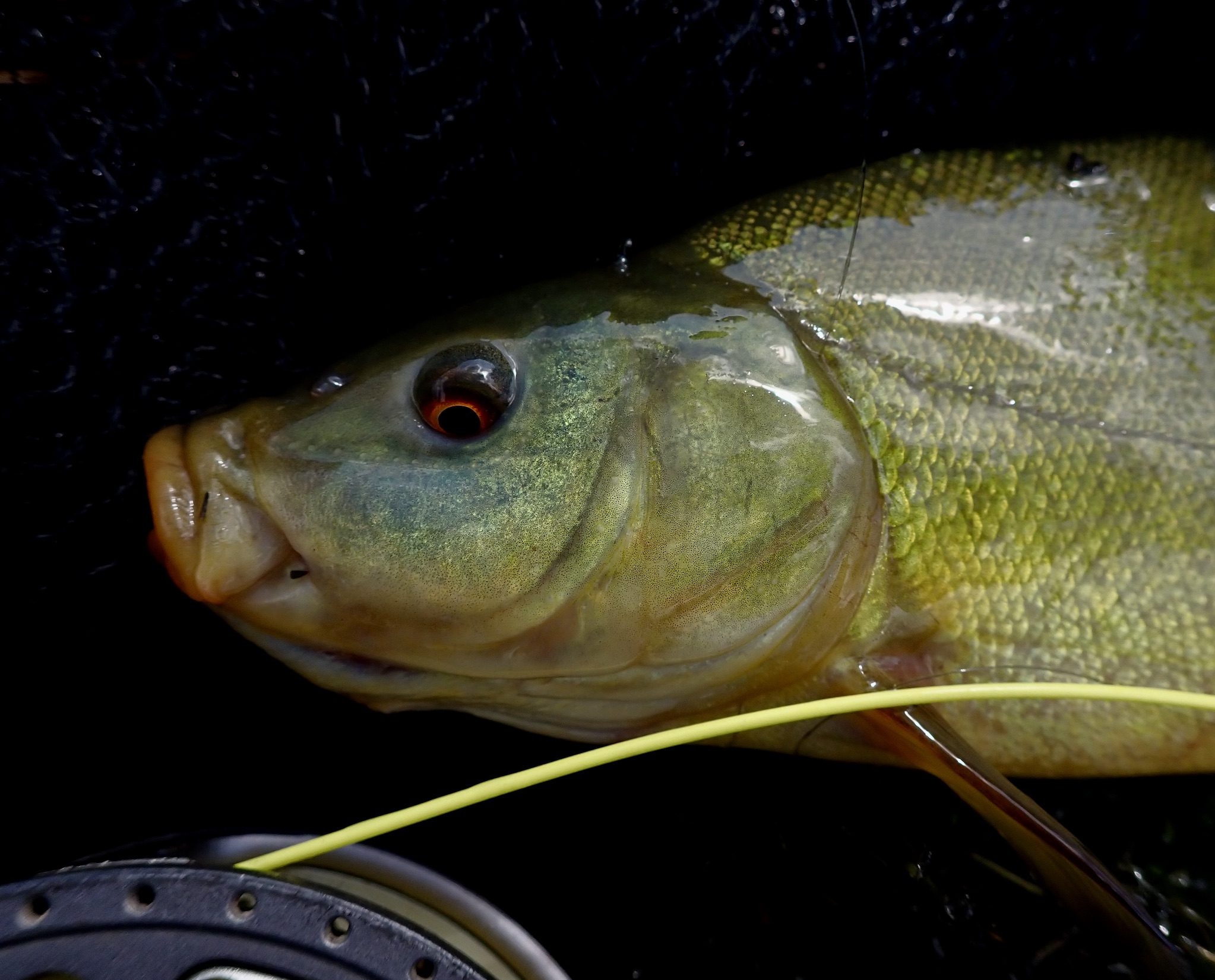
Two more carp and a small tench ( a first on the fly) followed before I ran out of time and headed for home.
James asked me the night before our trip; why do you lot have to get up so early? The view the following morning as we bounced across the water on another fishing adventure aboard Reel Deal was I thought answer enough.
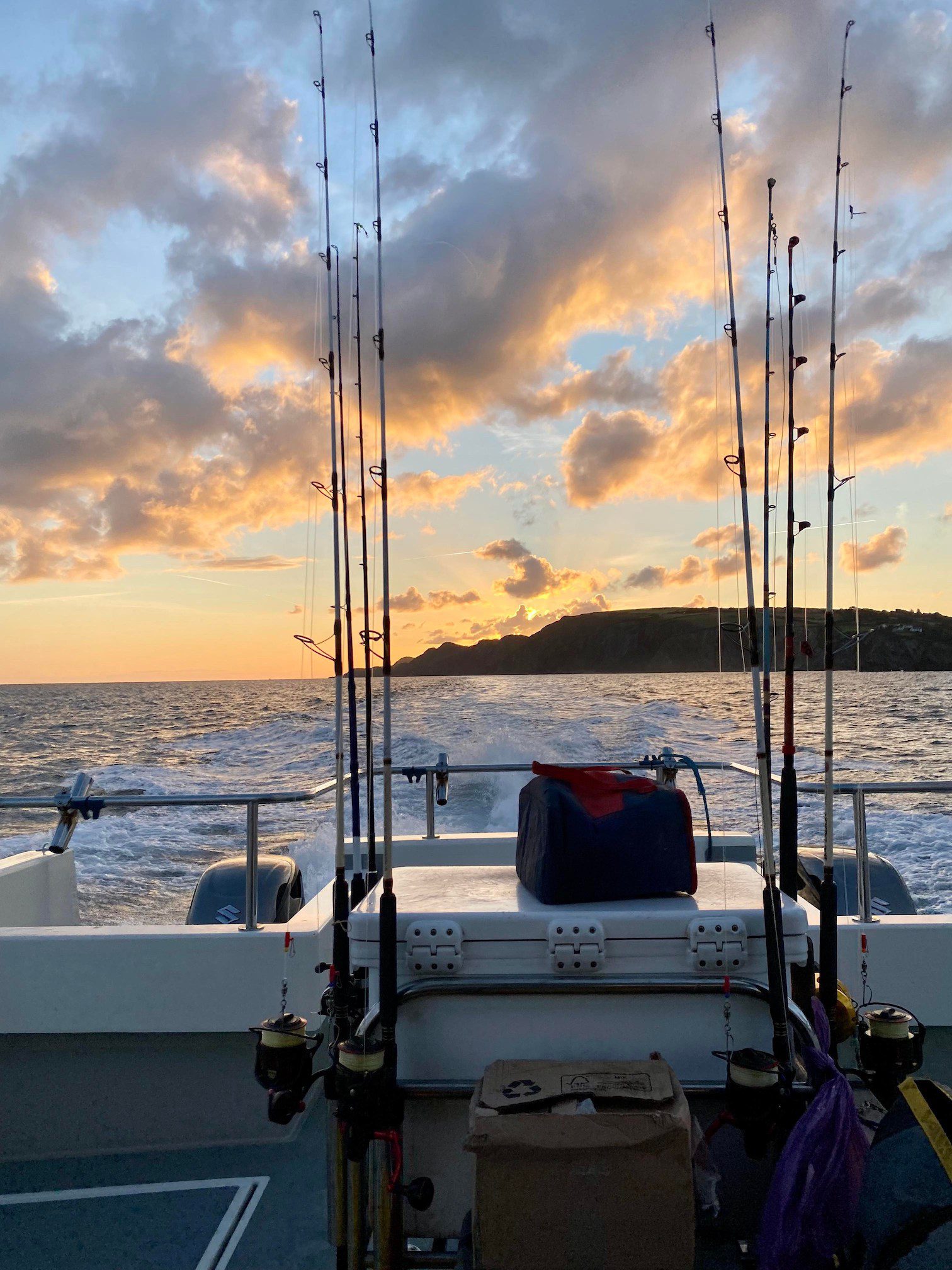
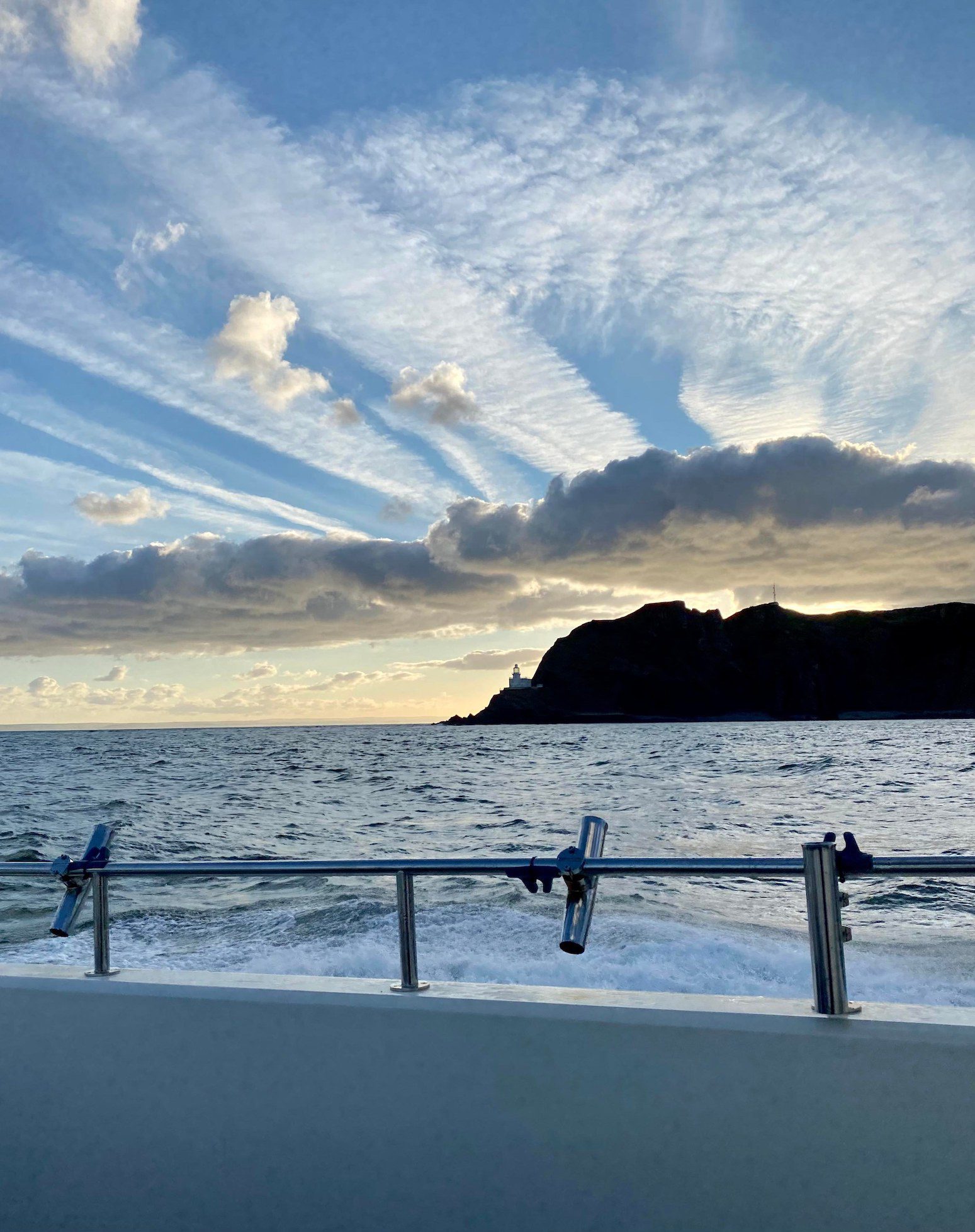
We were targeting porbeagle shark today from the renowned grounds off the North Cornish coast an area that once provided superb sport for members of the Appledore Shark Angling Club back in the 1960’s and 1970’s. During those days shark angling practices were less enlightened than today and all shark were slaughtered with many shark sold at market to pay for the angler’s sport. Fortunately, a ban on commercial fishing for the species and catch and release practiced by all anglers the shark have made a strong recovery. All shark caught are now released at the side of the boat with circle hooks used by all responsible anglers.
Dan Hawkin’s skipper of Reel Deal Charters is a pioneering skipper keen to explore the grounds reachable from Ilfracombe and has explored the potential that is available. I had booked this trip with Dan over twelve months ago and had fitted in with two keen shark fishers who had come fully equipped with their own gear. I had brought with me my son James Thomas, and good friends Peter Robinson and Bruce Elston.
Anticipation was high as we passed Hartland Point and cruised into the Atlantic Waters at the mouth of the Bristol Channel. Dan cut the engines a few miles off the Cornish coast and busied himself setting up our sharking tackles. The two anglers we had joined fished their rods carefully amongst our four rods. James, Bruce, Peter and I drew numbers to determine who would go first. Bruce drew 1, James 2, Peter 3 and myself 4.

Six baits were set up at various distances from the boat the furthest set deep and the closer baits proportionately shallower. As Dan started to prepare the frozen block of rubby dubby his keen eye caught sight of a dorsal fin cutting through the waves. Shortly after the rod tip pulled over and the float disappeared from sight and Bruce picked up the rod to set the circle hook.
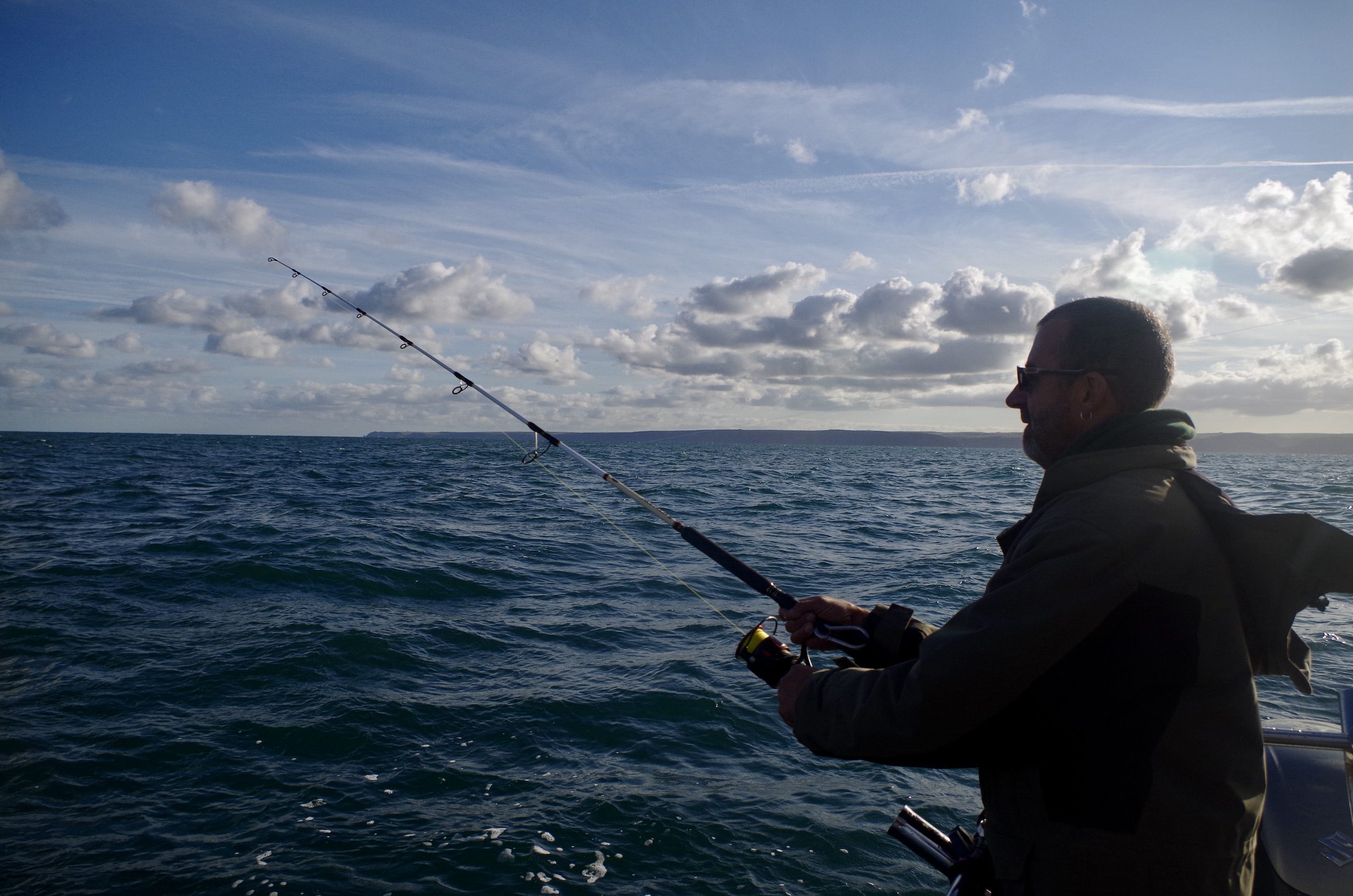
Frustratingly the hook failed to take a hold and we learnt how wily these large porbeagle shark can be. A few minutes later Bruce was given another chance and hooked into a shark that came off after a short tussle. We decided that we would if possible allow each of us to bring a shark to the boat but if the shark was hooked we would allow two hook ups before passing onto the next angler.
A few minutes after Bruce was in action again and this time he endured a long battle with a large porbeagle. These fish battle far harder than blue shark testing both angler and tackle to the limit. Eventually the wire trace was brought within reach and a specimen porbeagle was at the side of the boat. The fish was neatly hooked in the scissors and was released after grabbing a quick picture of the fish with Bruce leaning through the gate.
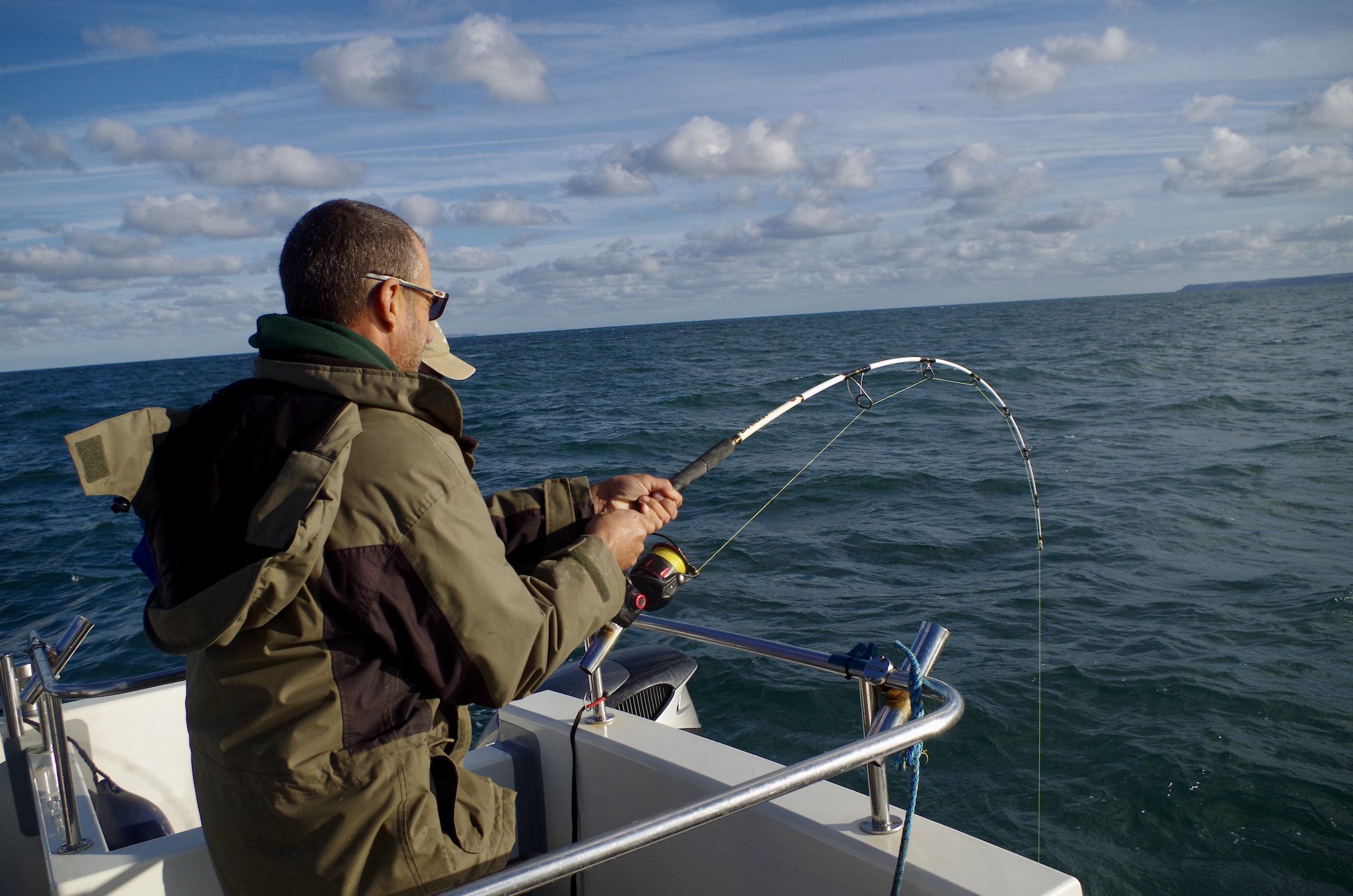
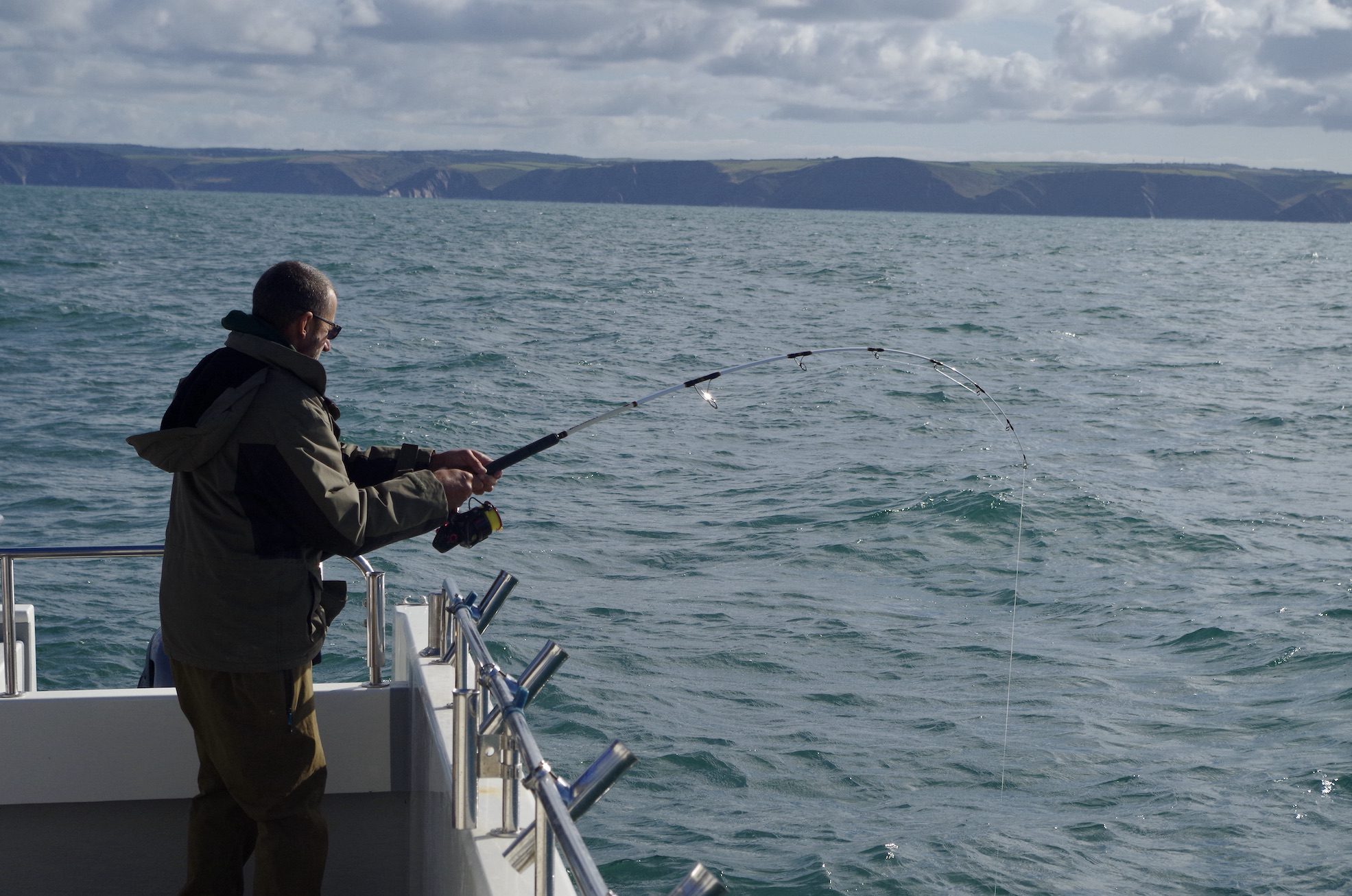
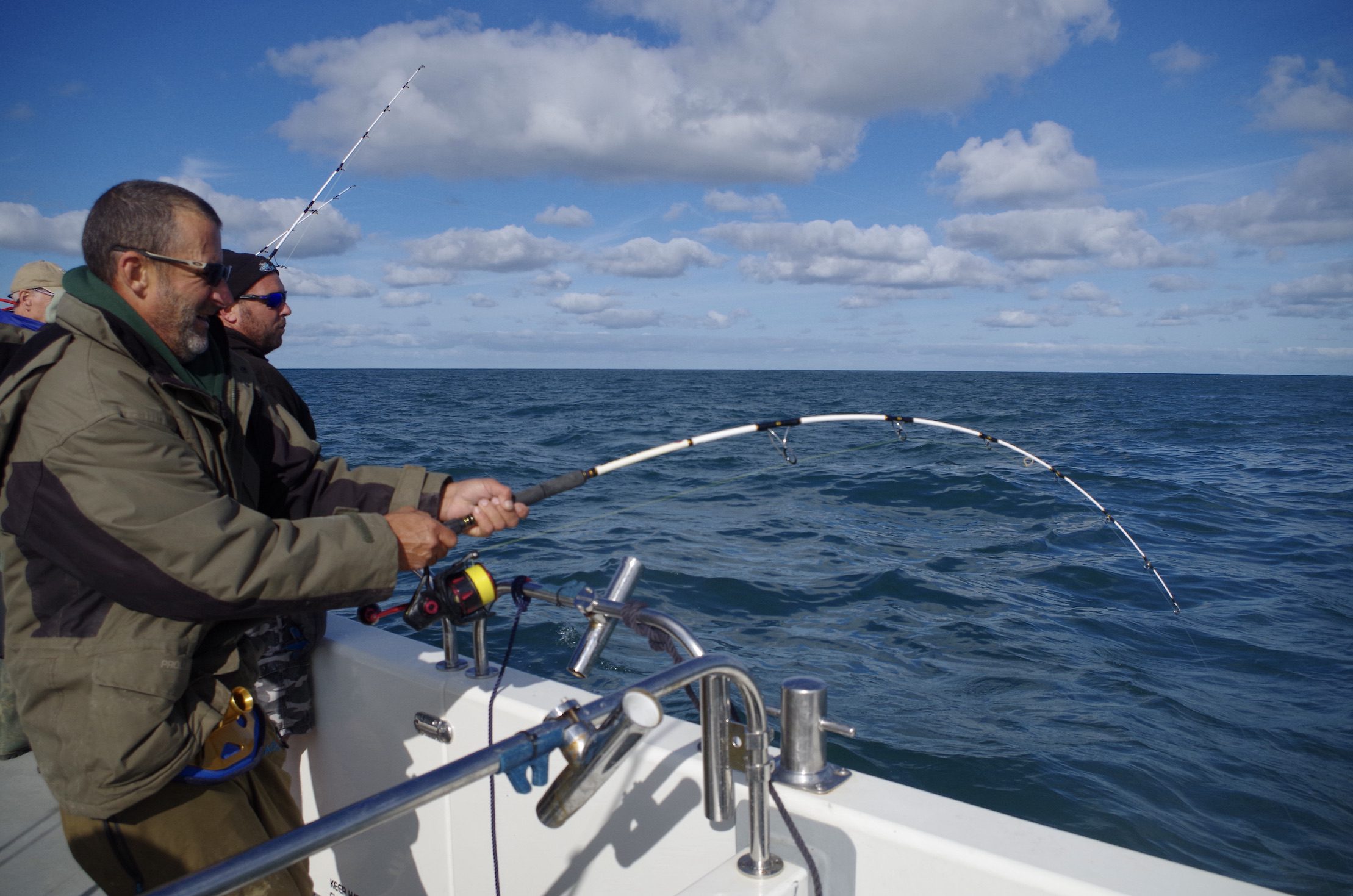
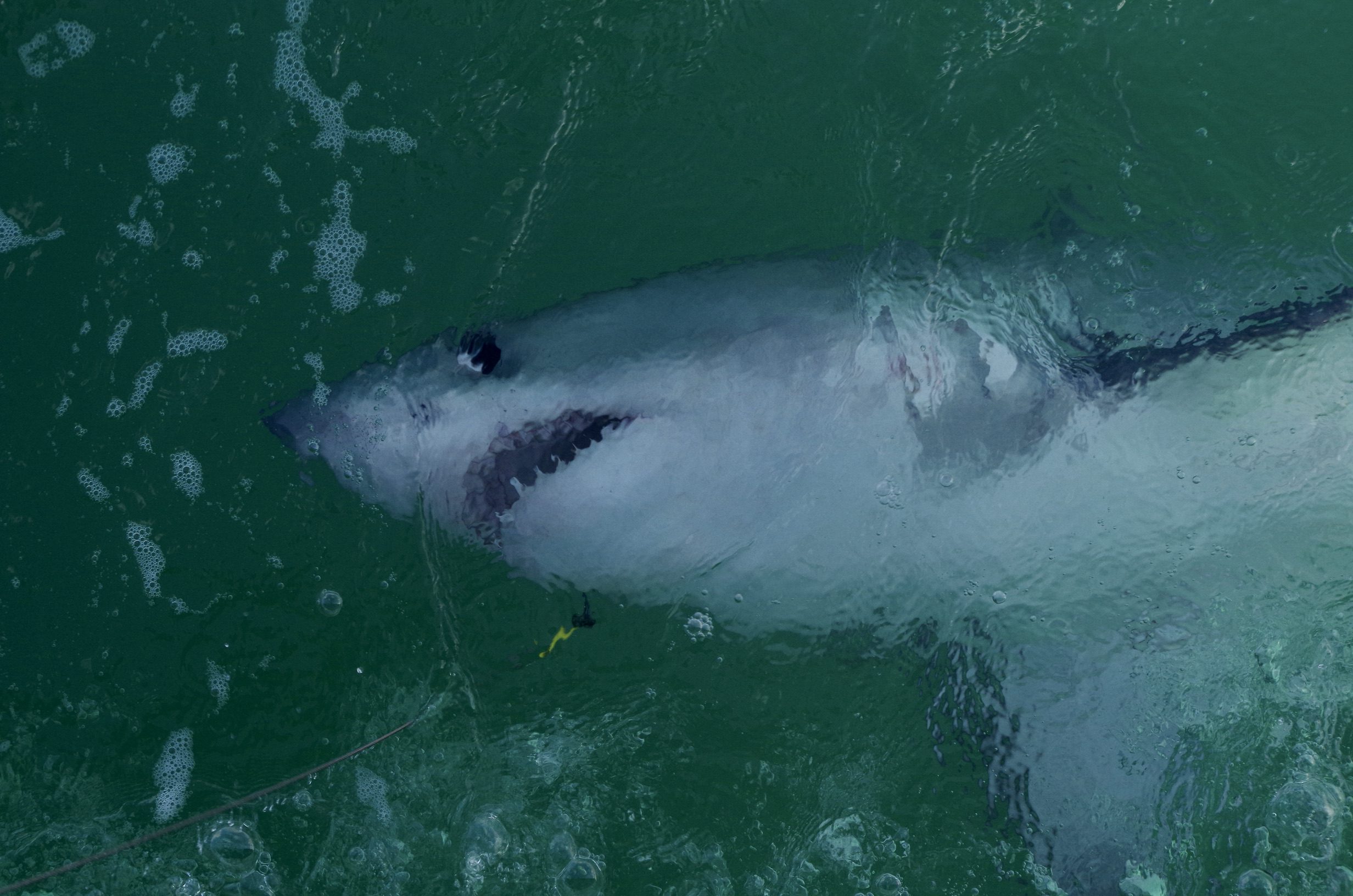
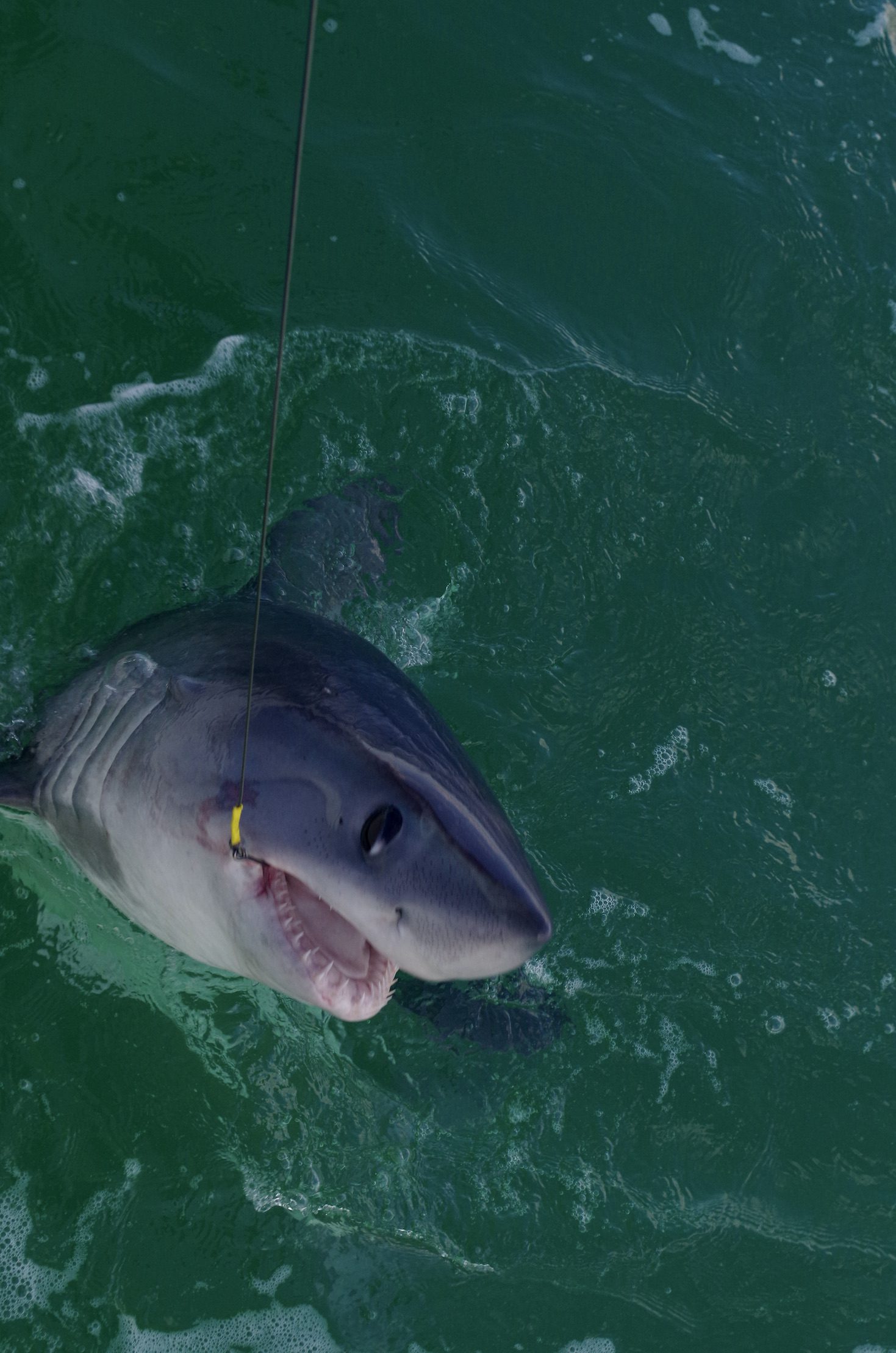
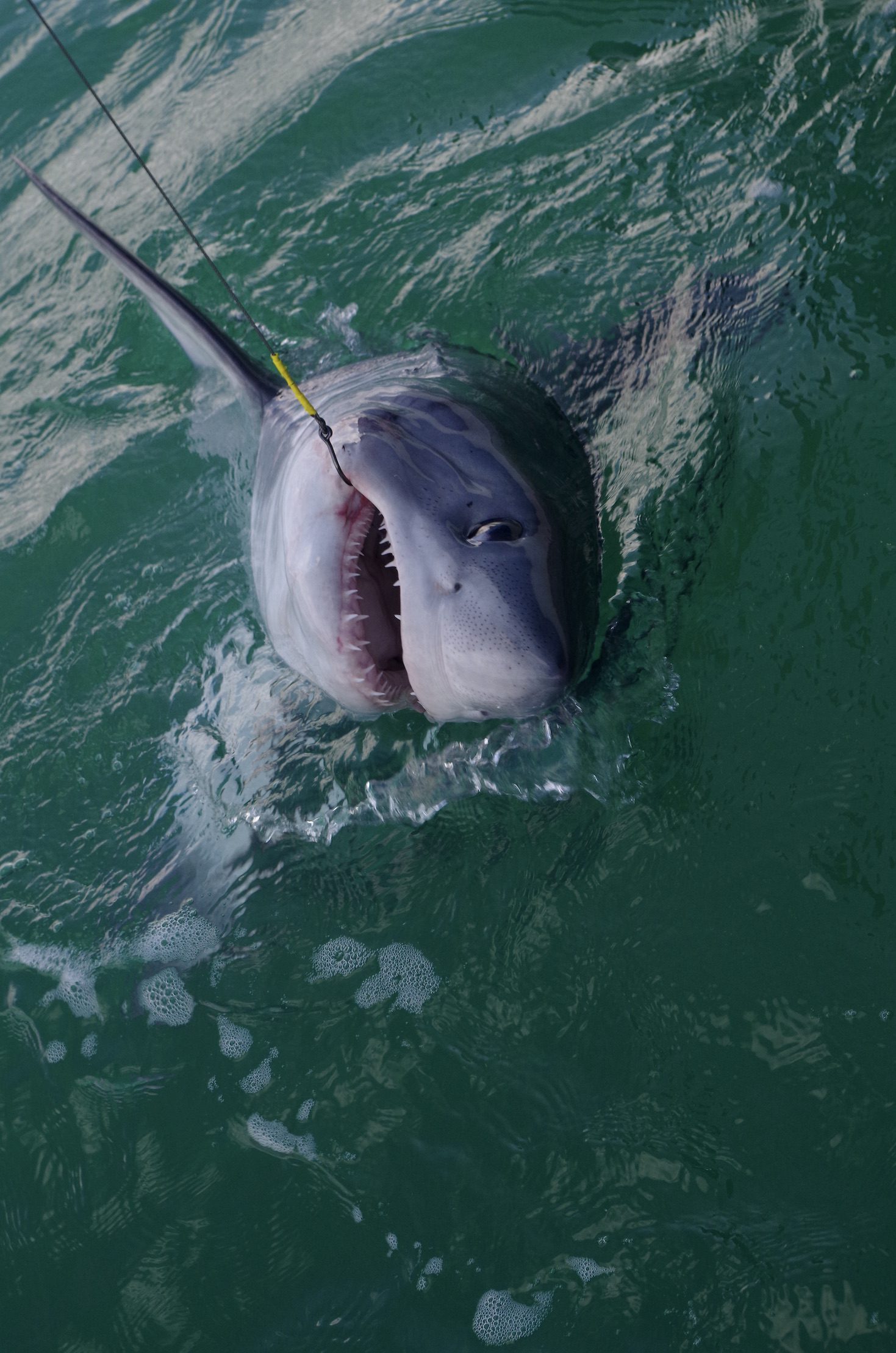
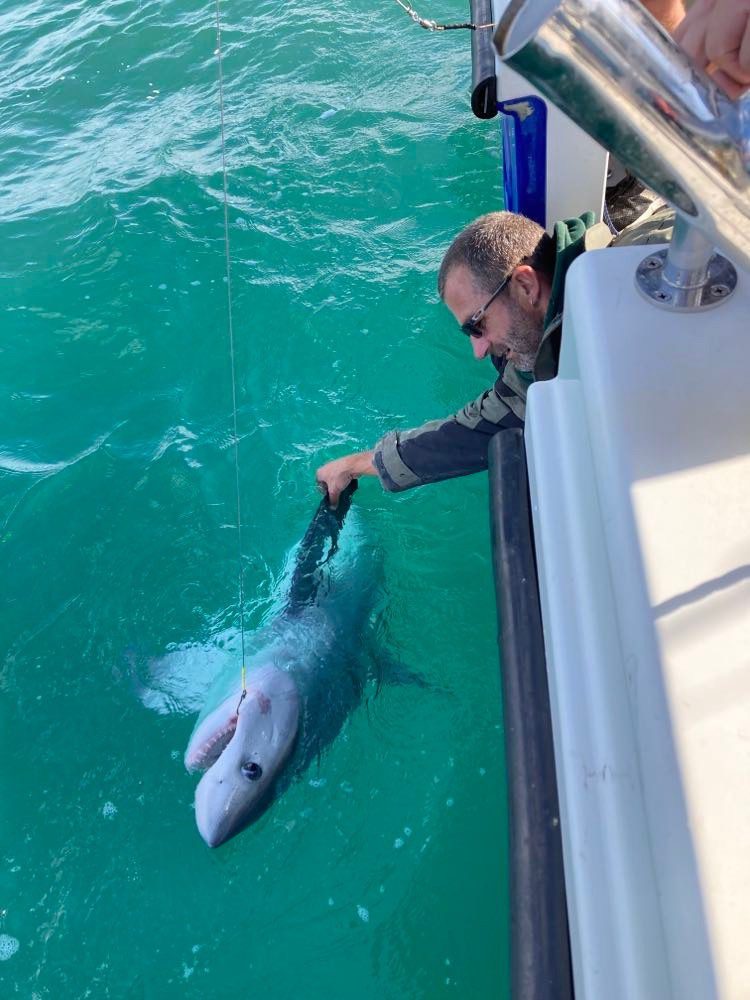
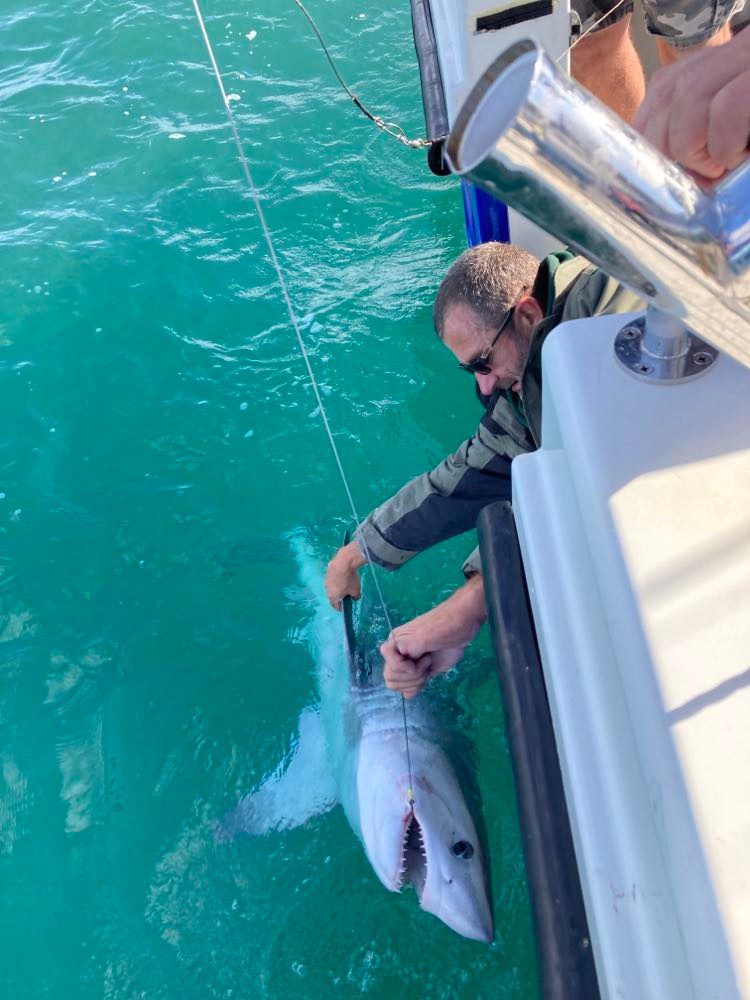
This was certainly a very encouraging start to the day. After a short lull it was James’s turn and after an aborted take another run soon developed. This time James made contact and was connected to a very powerful fish that gave him a long and tiring workout for twenty minutes or more.
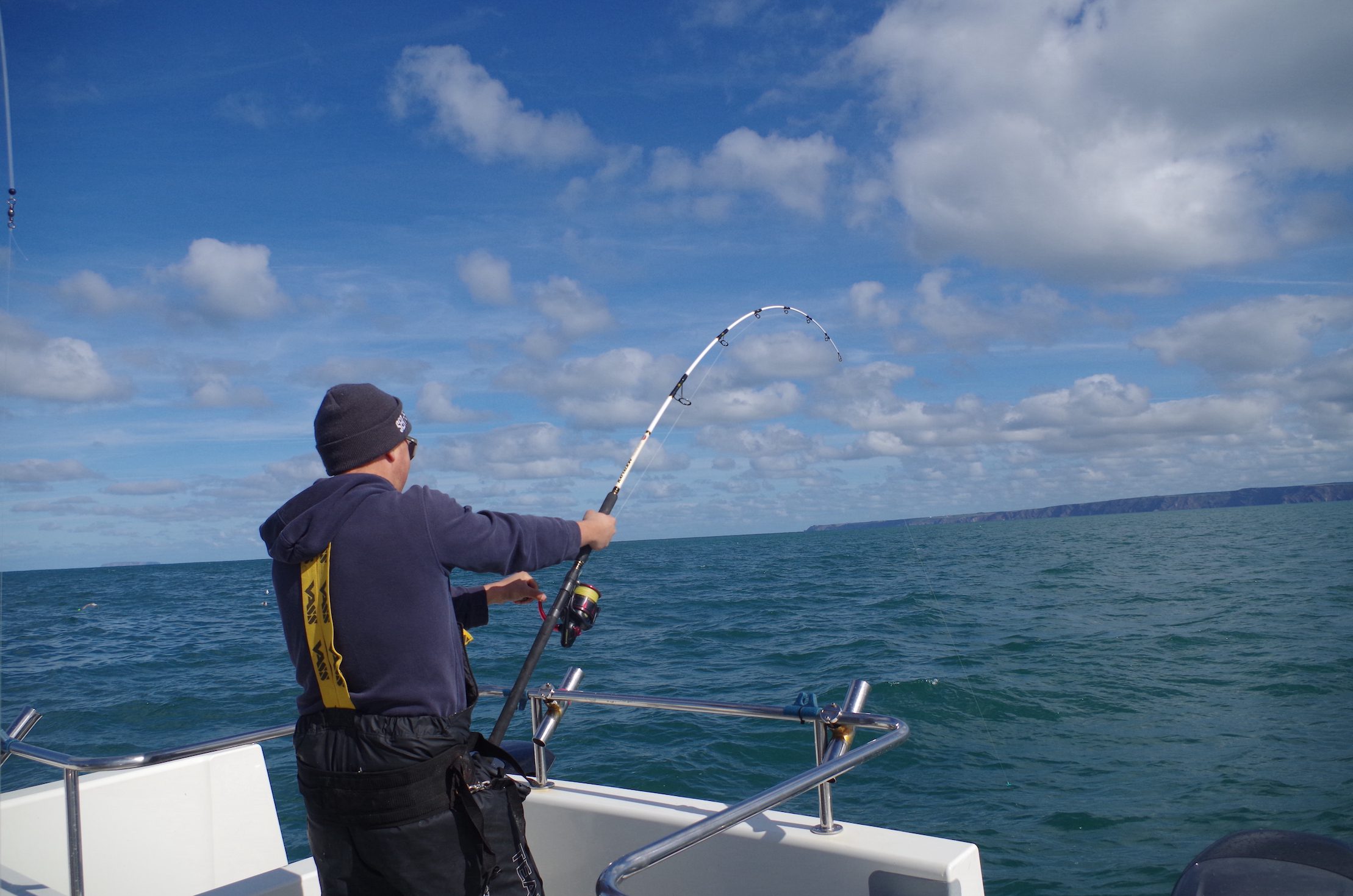
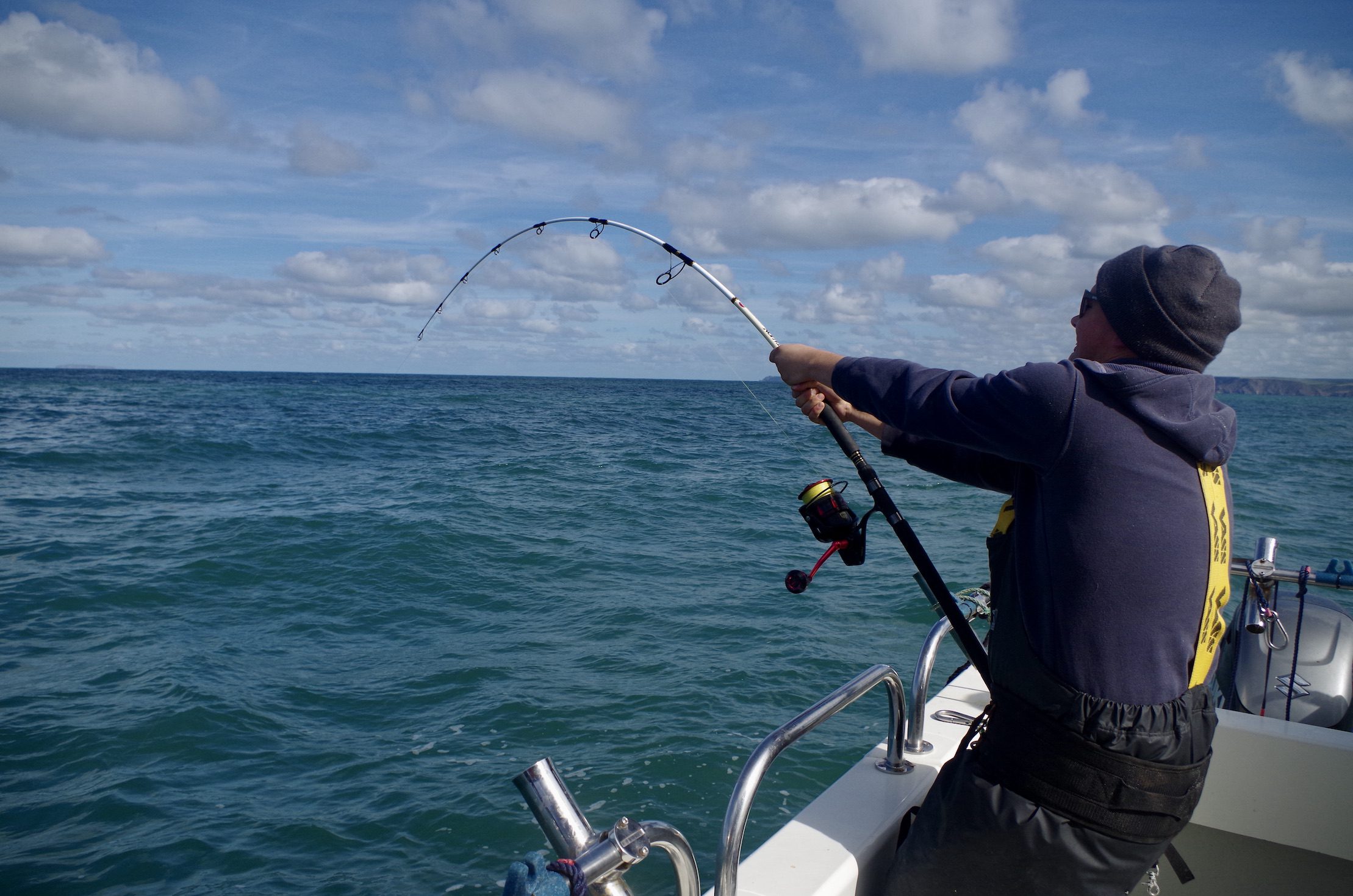
Eventually the heavy wire trace appeared boat side and Dan grabbed the trace pulling the fish into view. It was a big shark and we were dismayed to see that it had a large wound around its body. A strip of white plastic was wrapped around the shark’s body. Dan was determined to remove the torturous plastic from the shark. With the shark on the port side of the boat It was now necessary to bring the shark to the starboard side.
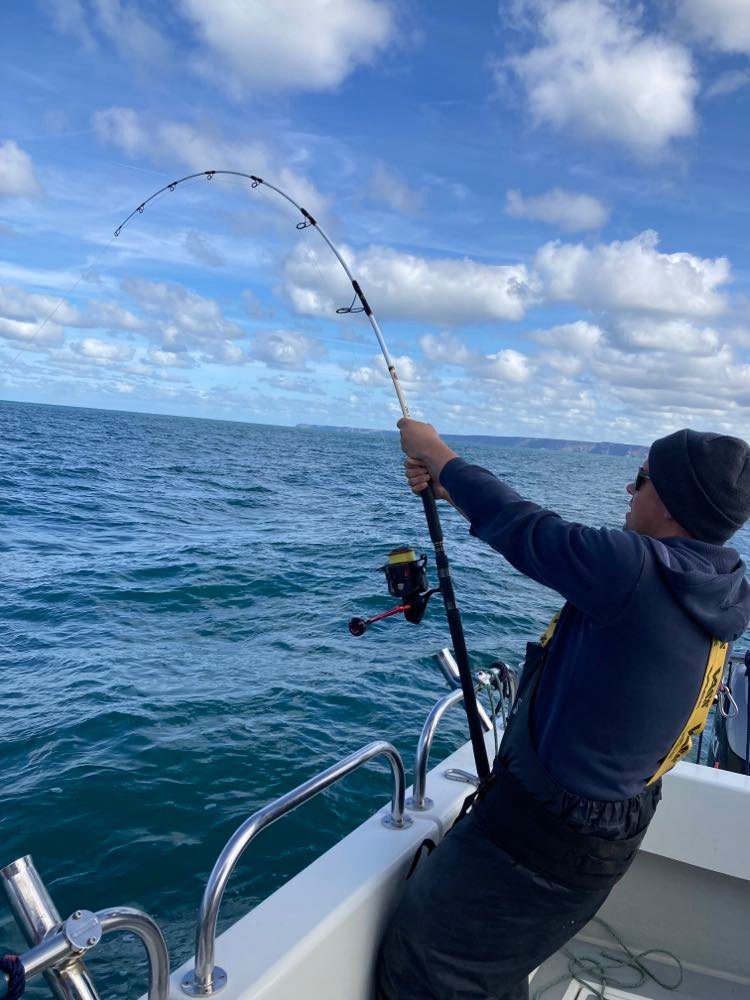
This appeared to give the shark a second wind at is point and it battled gamely for another twenty minutes before being brought to open gate. The fish was then swiftly brought on board where Dan got to work with a pair of scissors to remove the piece of plastic strapping that had cut cruelly into the shark’s body. Whilst on board the shark was quickly measured and dowsed with sea water before a quick photo. The measurements gave a predicted weight of 179lb. The fish was then slid carefully back into the sea to hopefully recover from its wounds free of the plastic that had been so carelessly dumped.
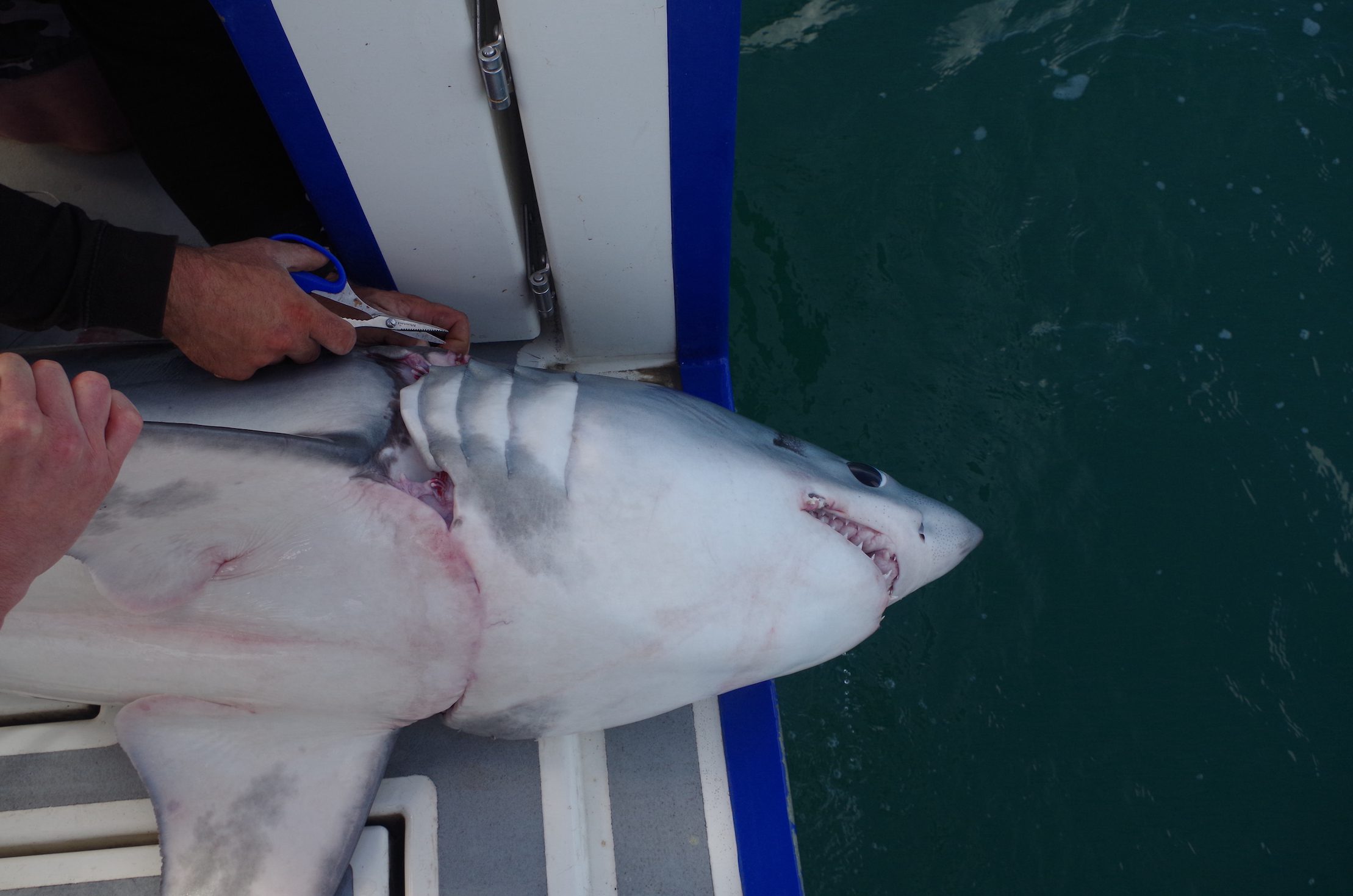
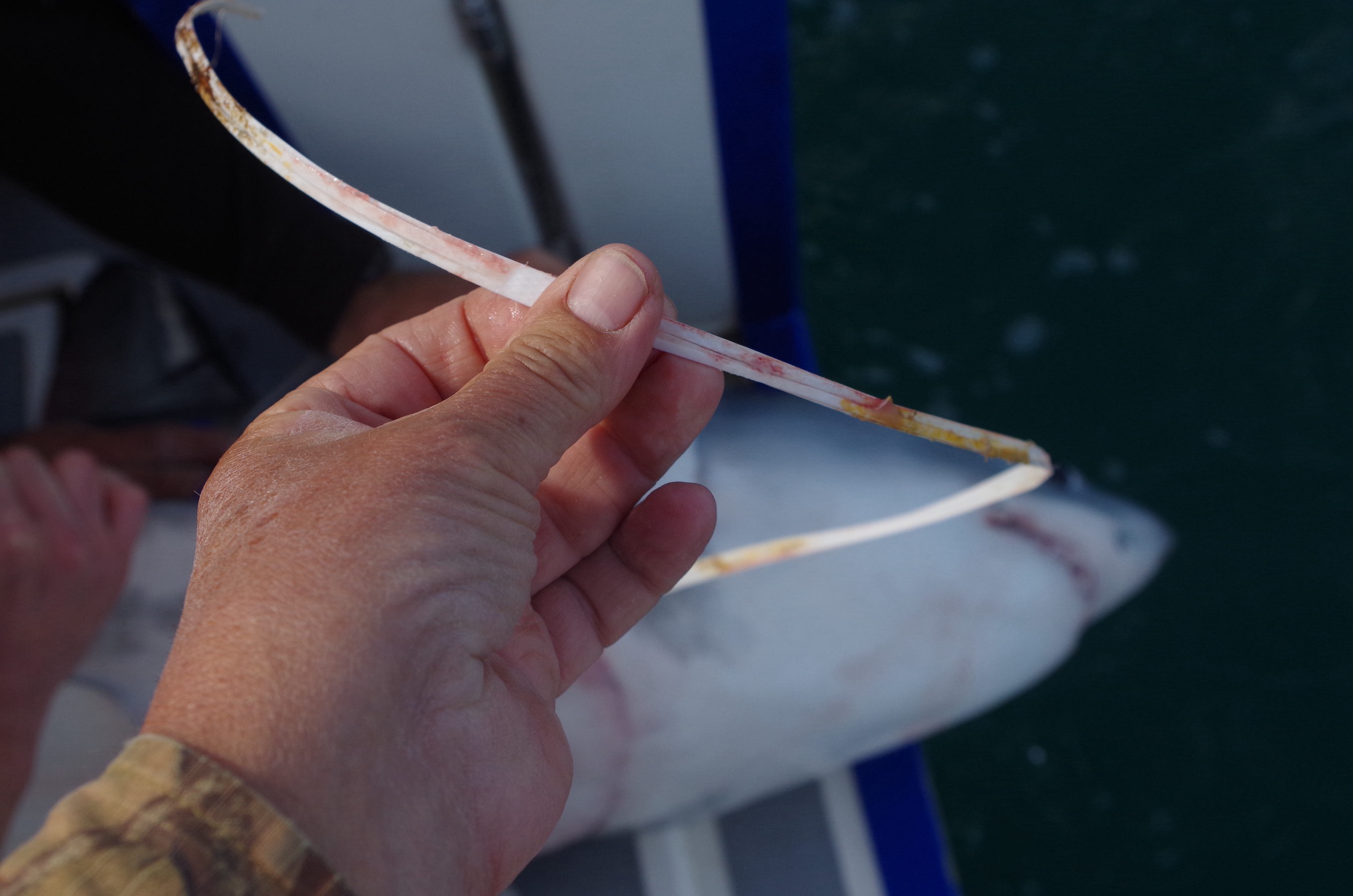
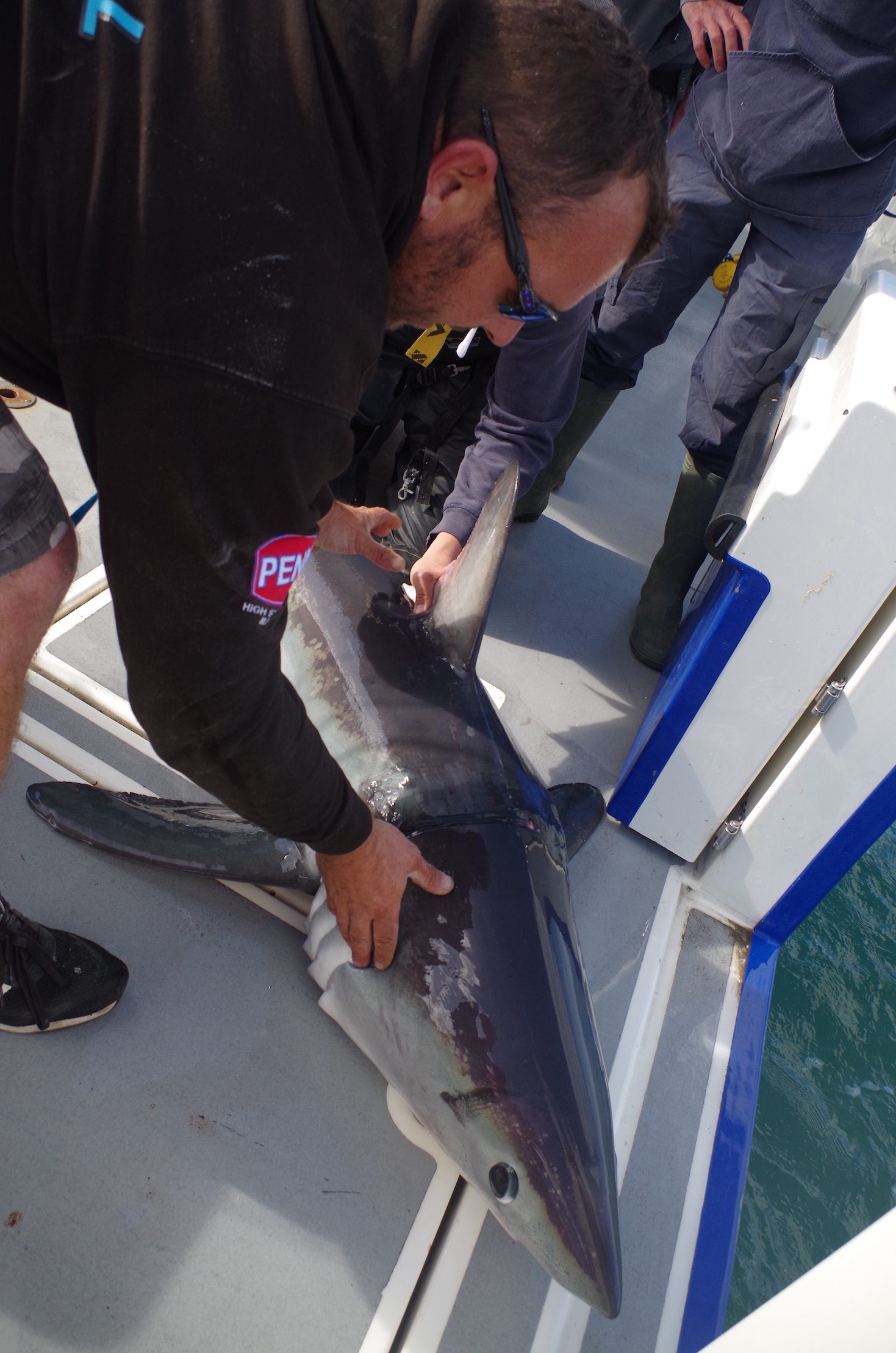
Many thanks to James for allowing me to add his account of the trip and for Peter, Bruce and James in providing additional images.
A great days fishing out of Ilfracombe. Perfect conditions to be out on a boat and amazing scenery as we steamed out to the fishing mark. Searching for a fish that I’d never caught before yesterday the Porbeagle Shark ![]() . When it came to my turn to take the rod the float dipped and the fish was on. The sheer power was quite remarkable… when I got the fish to the side of the boat where they are normally released straight away to keep any stress on the fish to a minimum we noticed some plastic around it’s gills. Dan the skipper brought the fish aboard snipped off the plastic and after a very quick photo we released the fish back into the water hopefully to fully recover from the tangle of plastic. Was shocking to see the damage caused by such a small piece of rubbish and shows the importance of reducing our plastic usage and dumping into the oceans. A great day, good company, stunning scenery and a fish I’ll never forget. Thanks Daniel Hawkins and Wayne Thomas.
. When it came to my turn to take the rod the float dipped and the fish was on. The sheer power was quite remarkable… when I got the fish to the side of the boat where they are normally released straight away to keep any stress on the fish to a minimum we noticed some plastic around it’s gills. Dan the skipper brought the fish aboard snipped off the plastic and after a very quick photo we released the fish back into the water hopefully to fully recover from the tangle of plastic. Was shocking to see the damage caused by such a small piece of rubbish and shows the importance of reducing our plastic usage and dumping into the oceans. A great day, good company, stunning scenery and a fish I’ll never forget. Thanks Daniel Hawkins and Wayne Thomas.
With two shark by 1.00pm our hopes were high for another couple of shark and it was Peters turn to take up the rod when a run came.
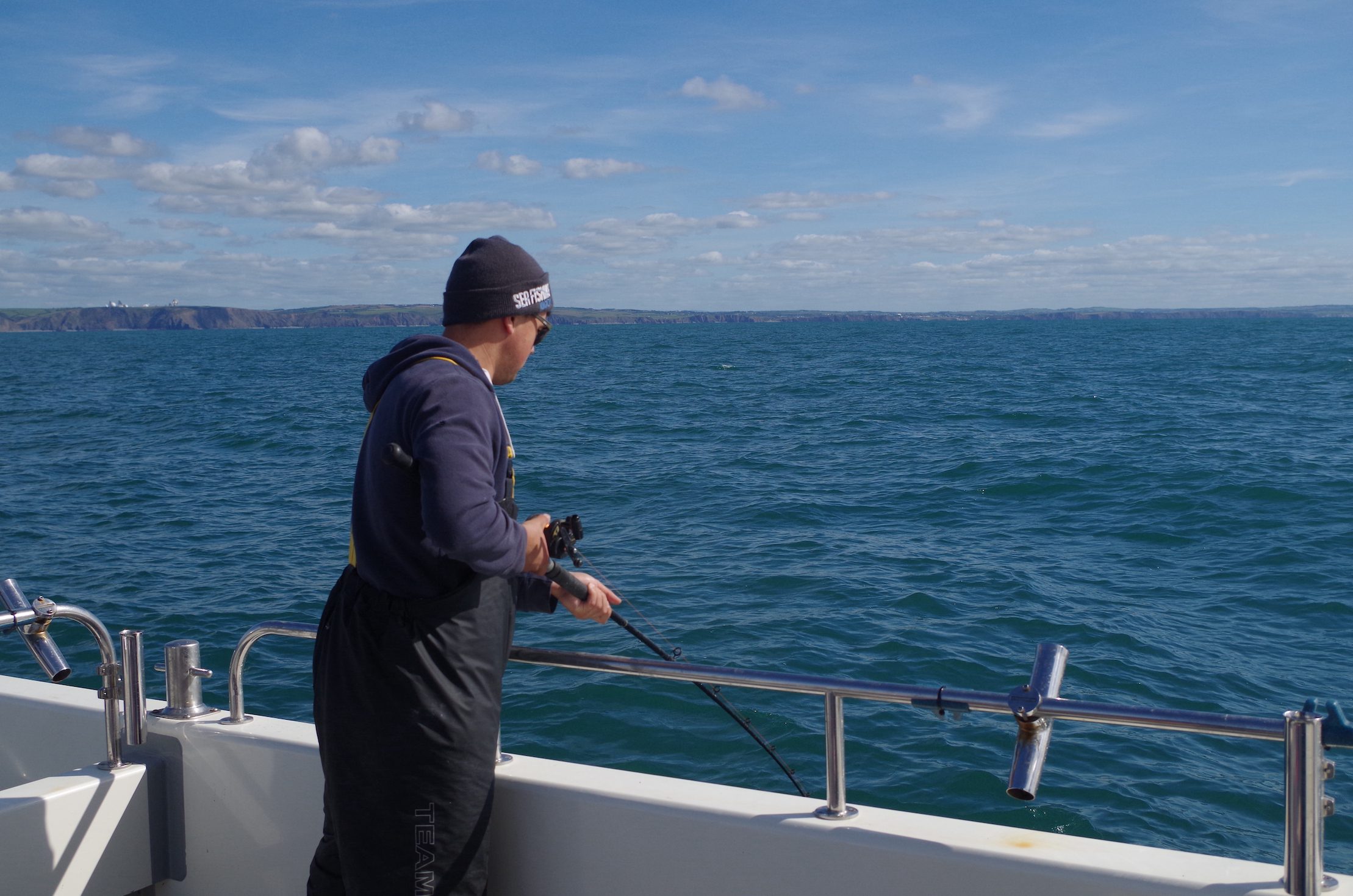
The boat drifted pushed by tide and wind a slick of oily scent calming the water in the wake of the boat. Whilst shark were top of the agenda lures, feathers and mackerel bait tempted bass in good numbers with fish to six pound plus brought to the boat. A couple of bass were retained for the table.
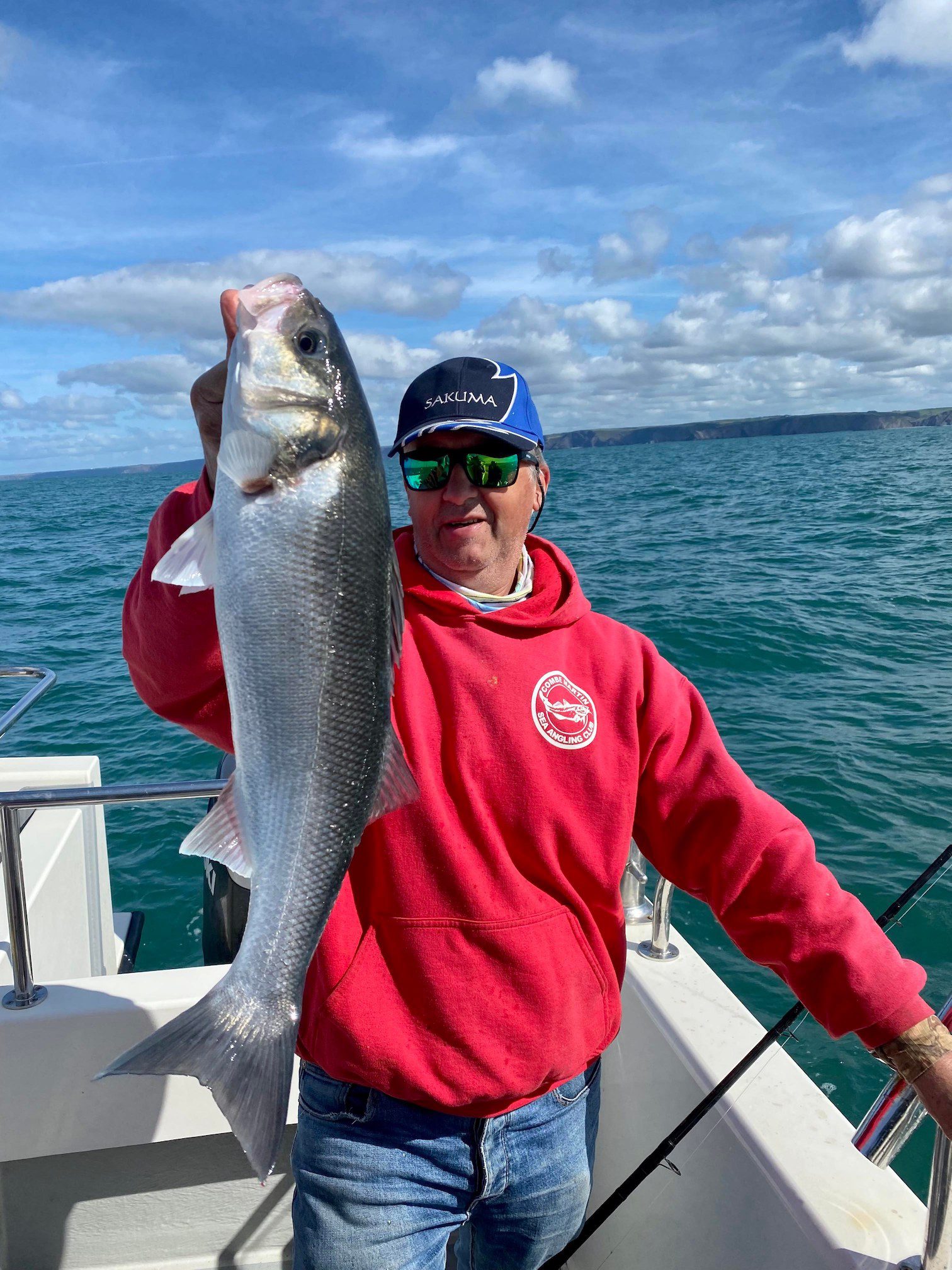
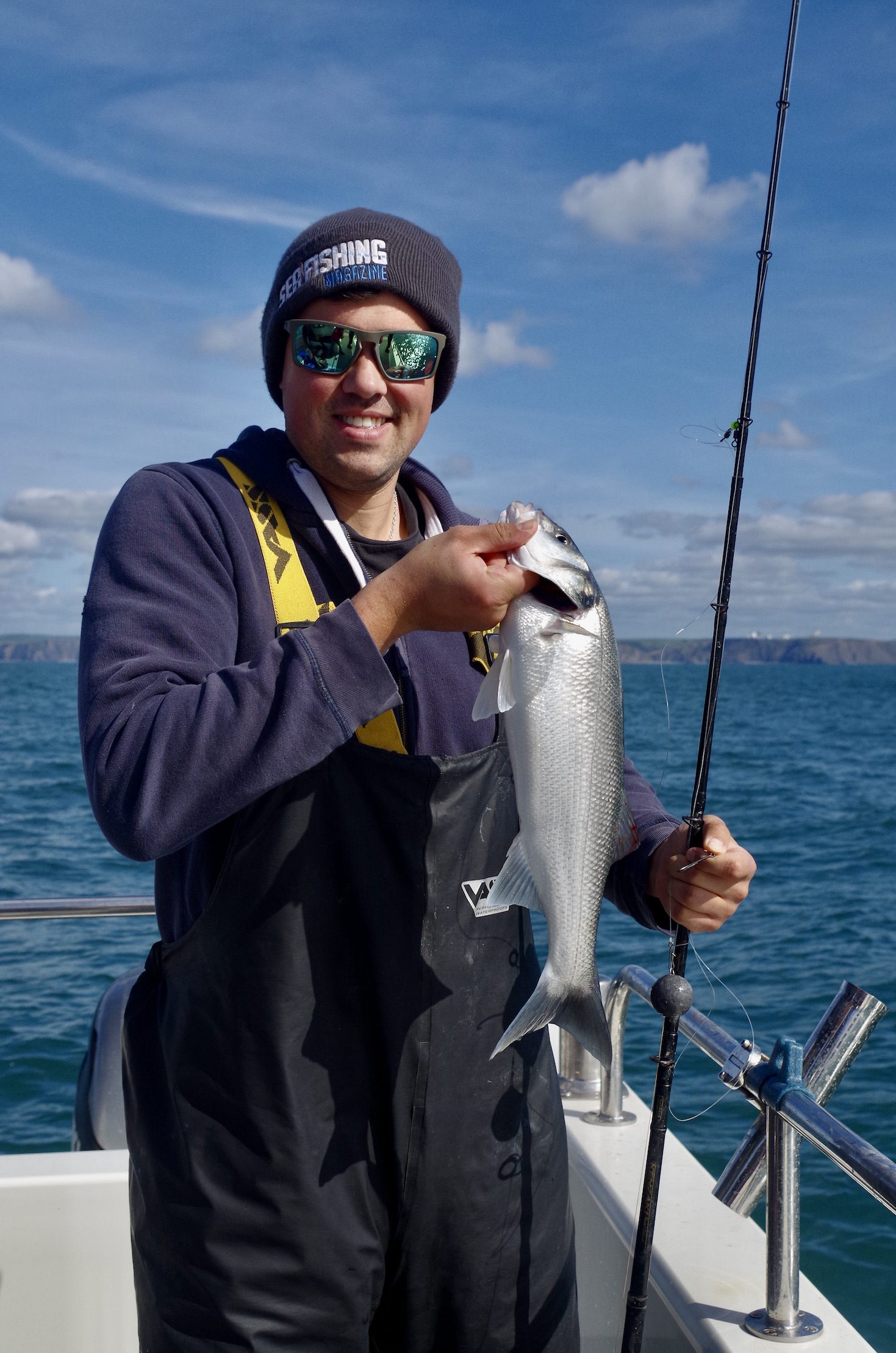
We chatted and relaxed watching the occasional gannet gliding above the vast ocean. At any moment we expected a float to plunge beneath the water or a rod to keel over as a porbeagle hit the baits. Dan kept us topped up with hot tea and coffee as we waited in tense expectation.
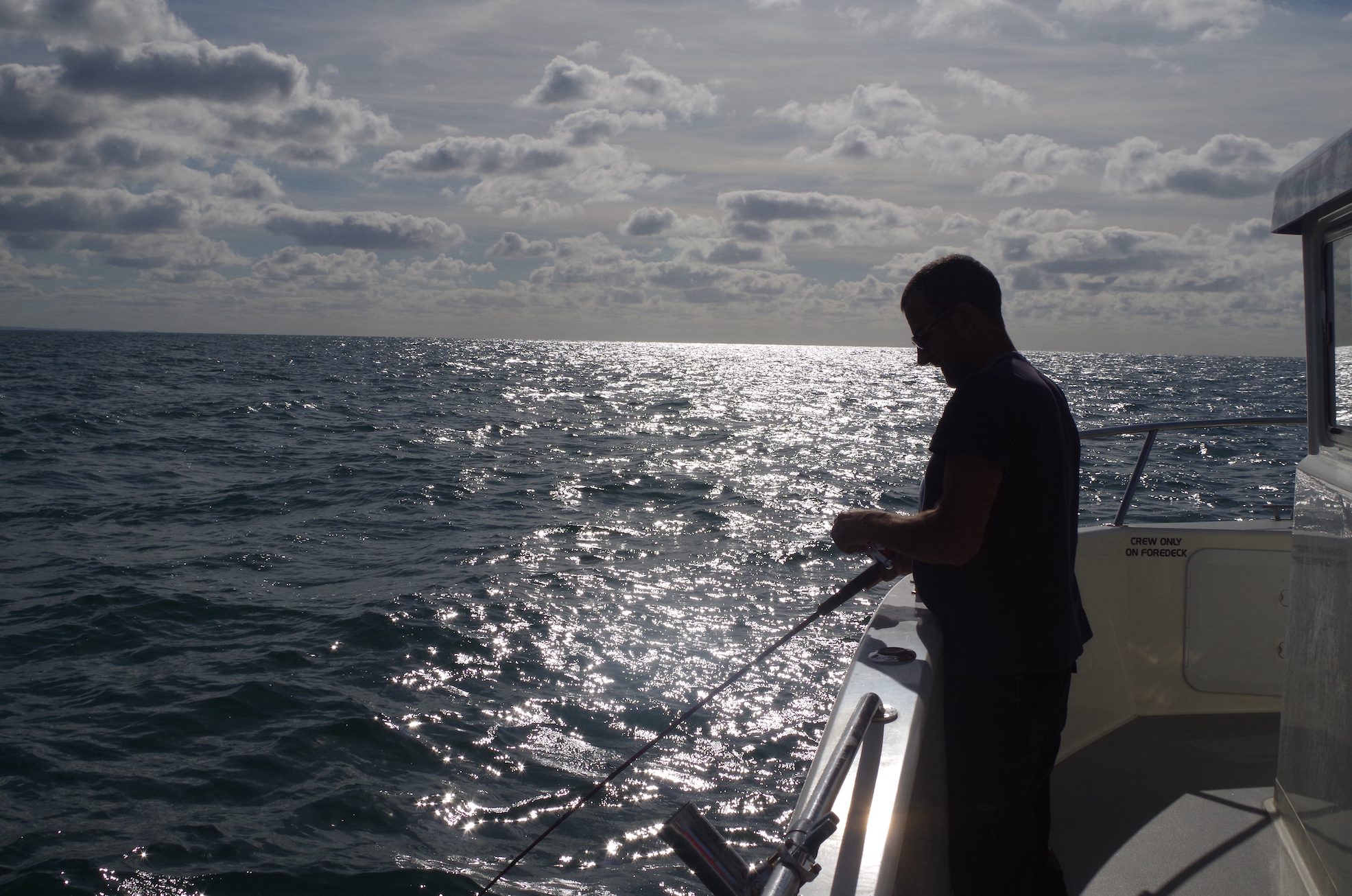
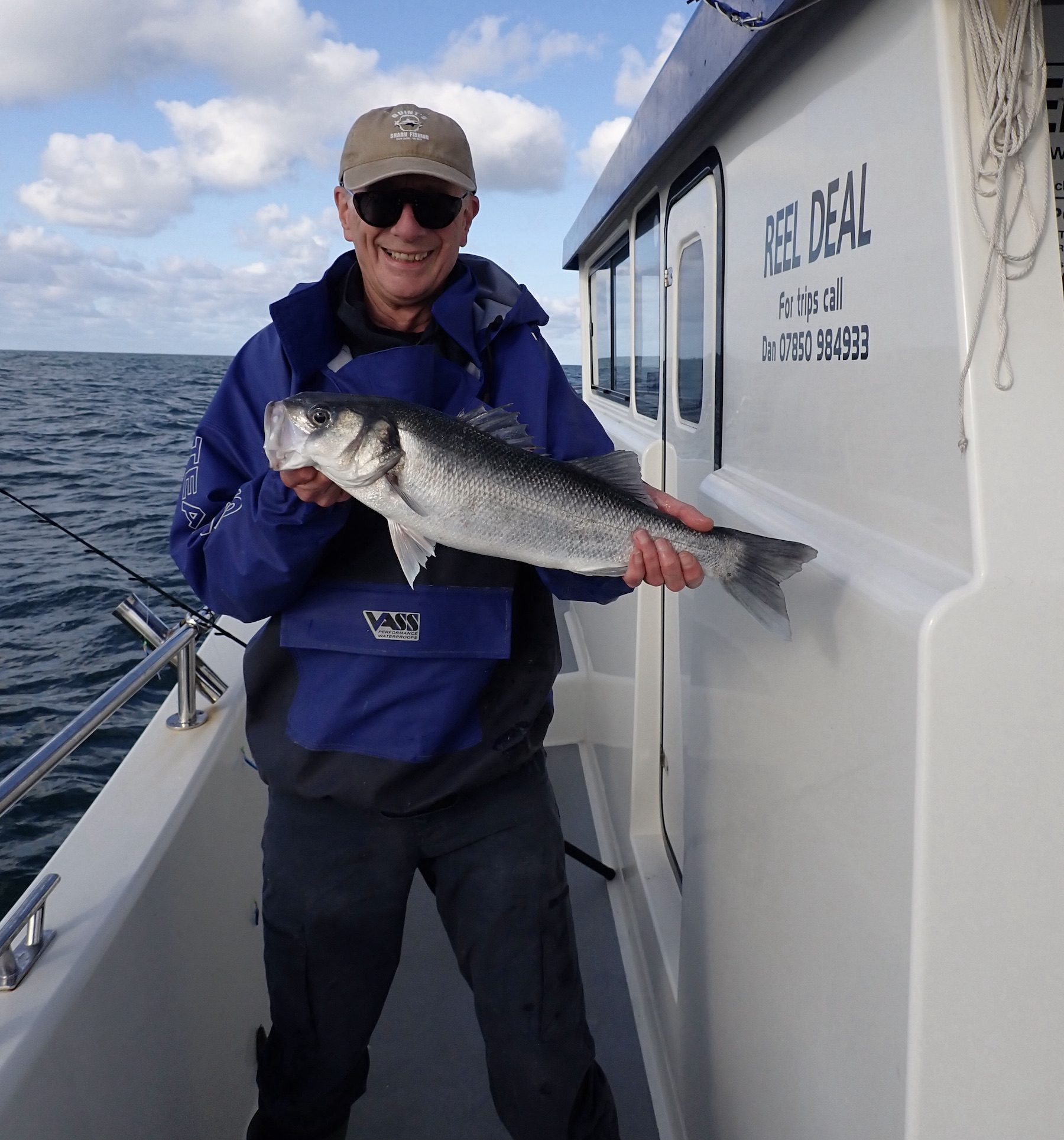
As the afternoon ebbed away our time ran out and Dan called time expressing disappointment at the quietness of the afternoon. The run back to Ilfracombe went surprisingly quickly as we passed familiar landmarks of the North Devon coast. Hartland Point at the mouth of the Bristol Channel, the dunes and estuary mouth of Bideford Bay. The headlands of Baggy Point, Morte Point and Bull Point and the spectacular cliffs between Lee Bay and Ilfracombe.
It had been a great day with couple of special fish along with silver bass, good company and spectacular scenery. I look forward recommencing the search again next year weather and life permitting.
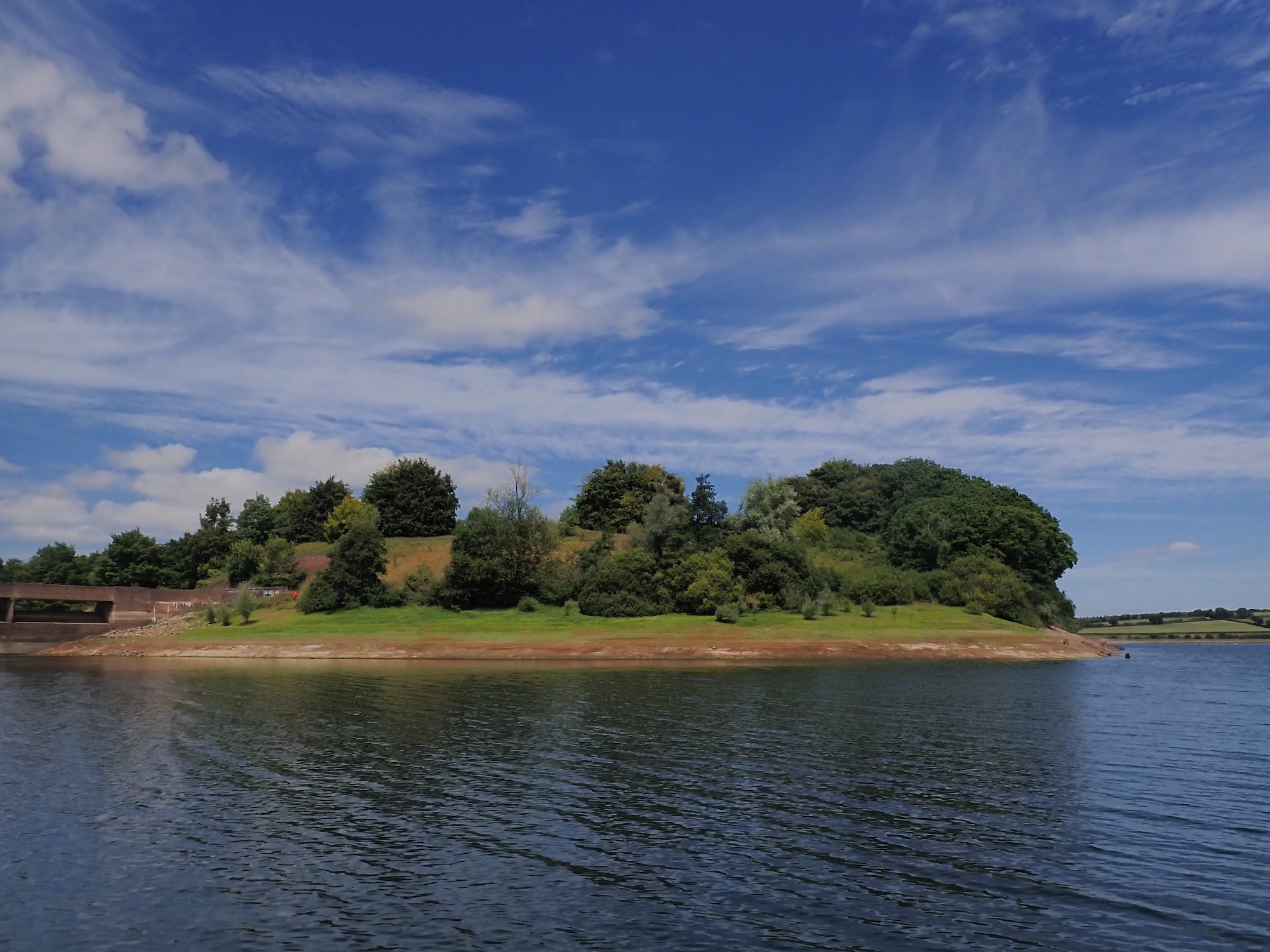
I joined Snowbee Ambassador Jeff Pearce at Wimbleball Lake to try for a summer rainbow. We knew conditions would be challenging with the long hot dry spell continuing to impact upon the lake and the surrounding countryside.
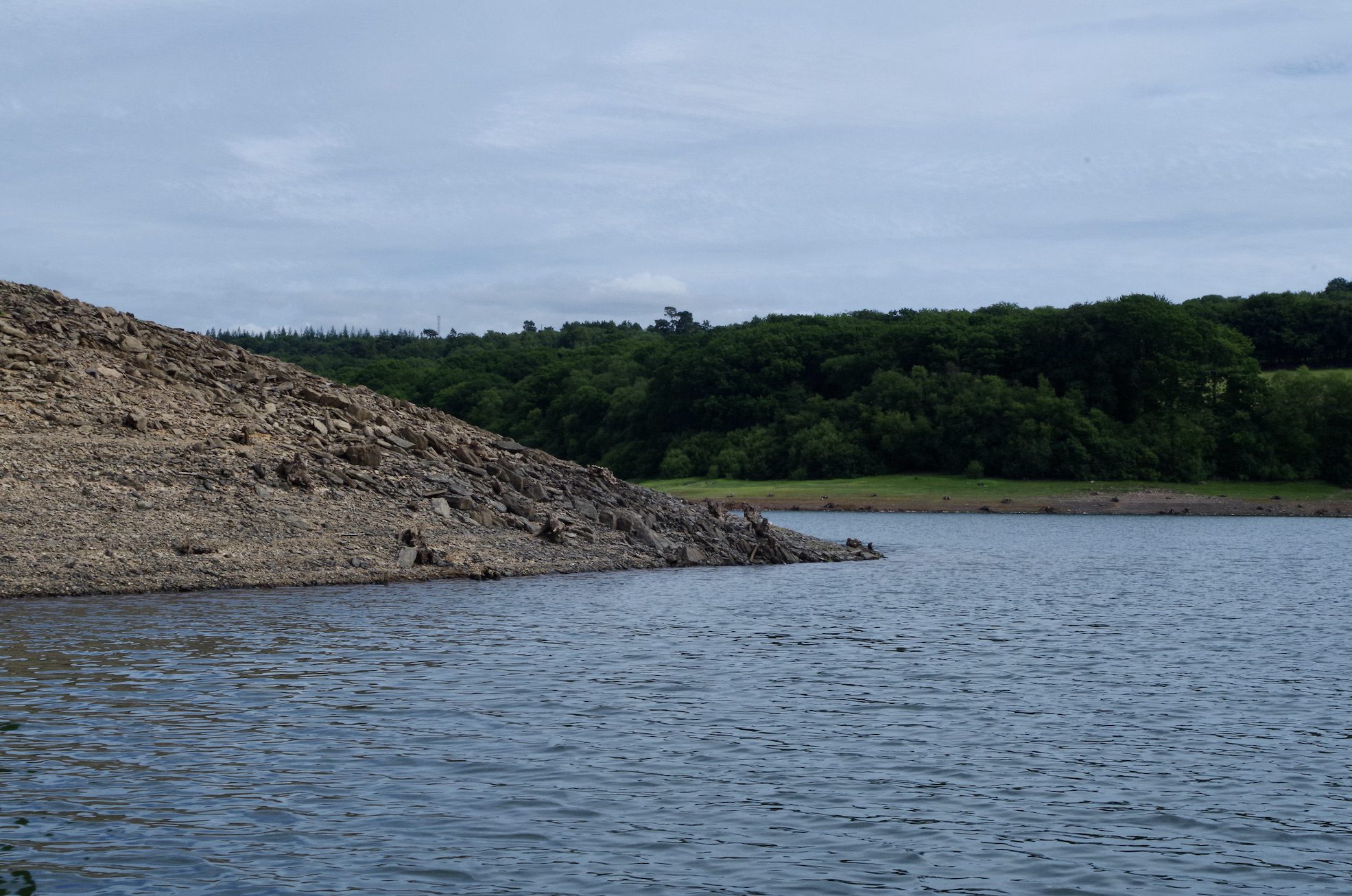
Jeff had already been fishing for several hours when I joined him in late afternoon. He had boated a rainbow of over 4lb and had lost a couple. We hoped that the fish would come on the feed as the hot sun sank beneath the surrounding hills.
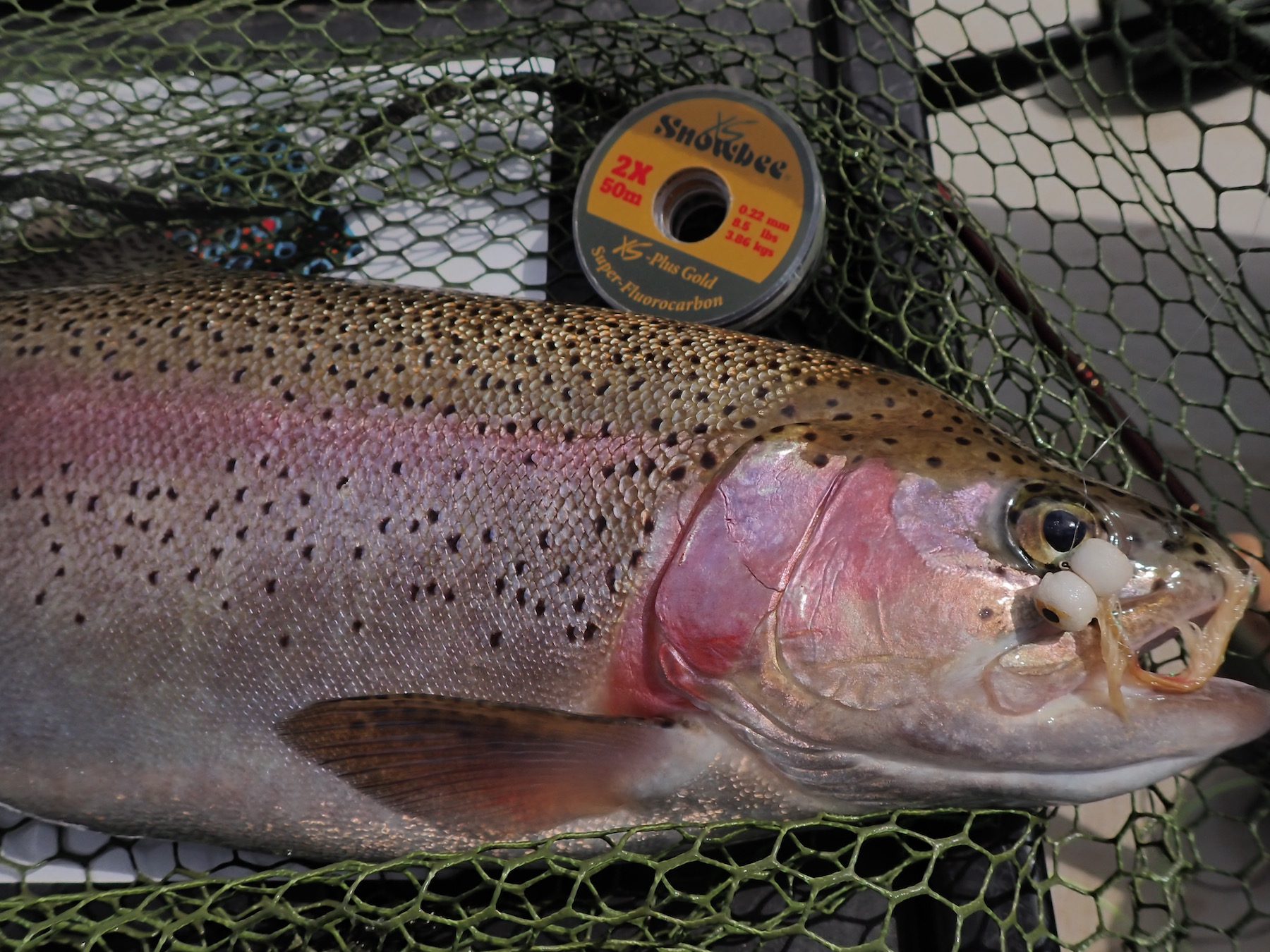
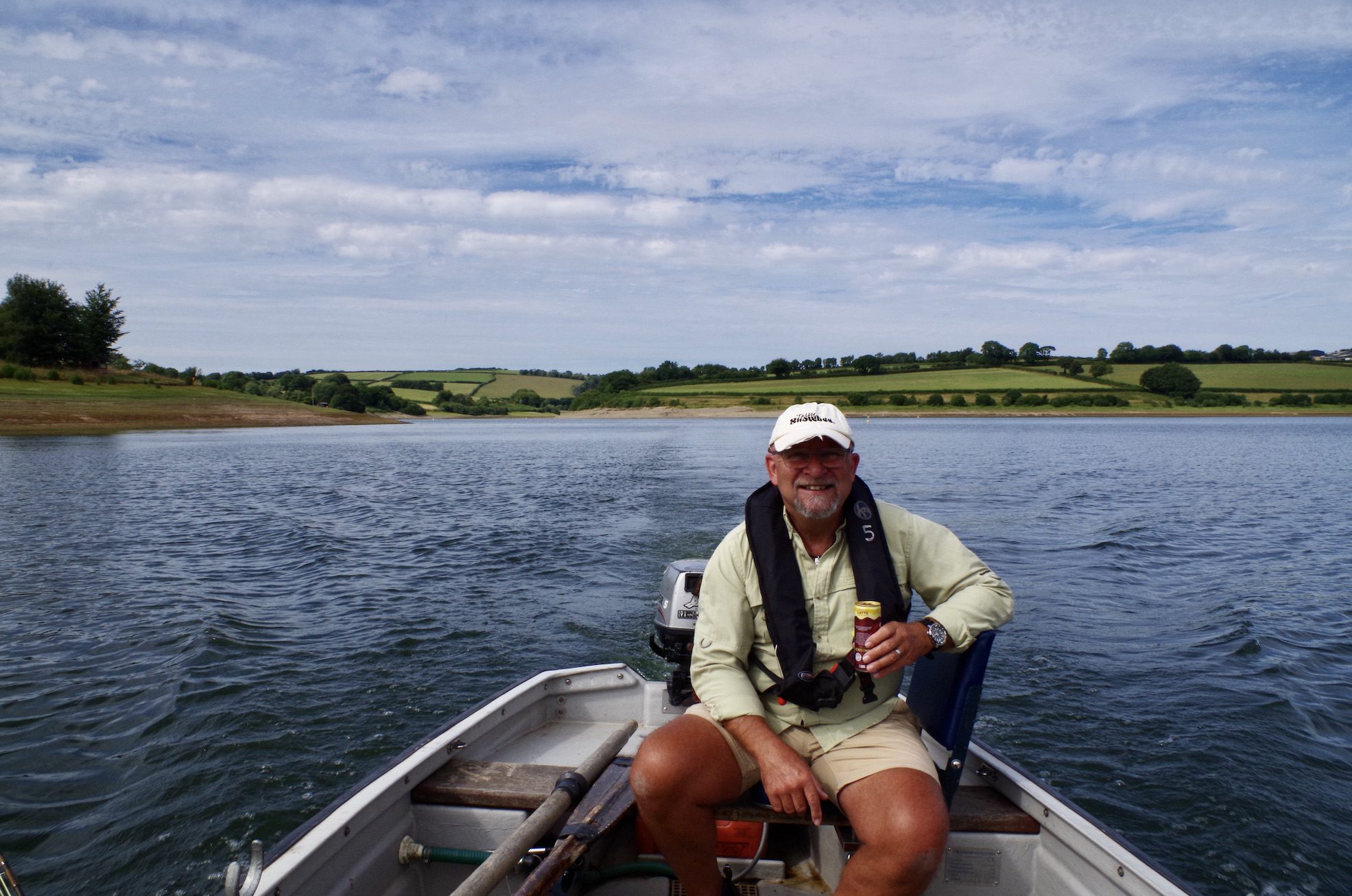
We set off for the wooded Upton Arm to try a few drifts. The water level had dropped significantly since my last visit in Late May. The expanding shoreline revealed scars from the past with tree stumps standing high and bare like skeletons upon the barren shore. Jeff likened them to alien invaders.
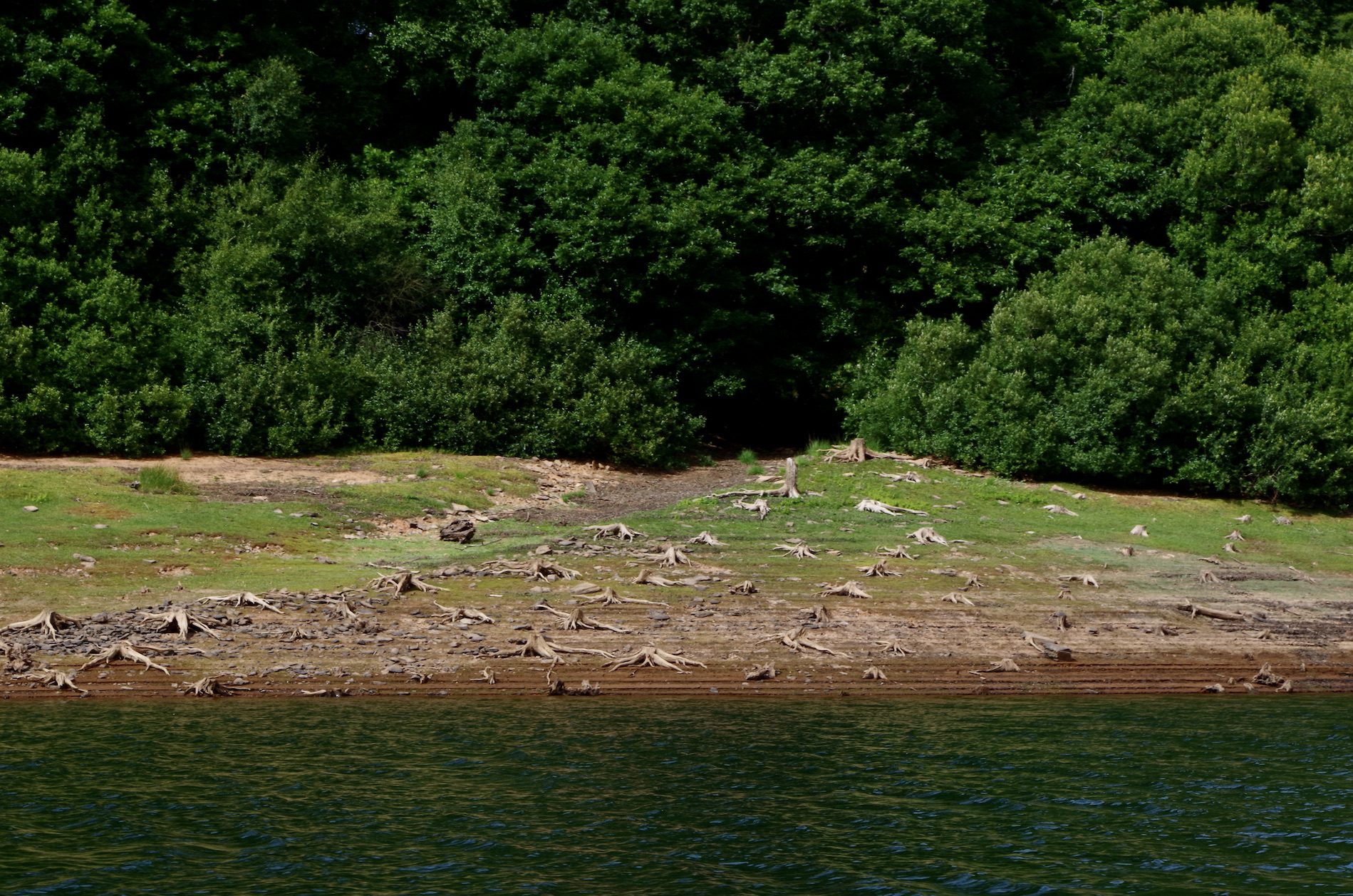

Michelle Werrett has written a nostalgic feature in Fallon’s Angler that touches upon this lost valley that was flooded in the 1970’s to meet the ever increasing demand for water across the South West.
As we drift across the water it is fascinating to try and picture what this valley once looked like with deep woodland descending to the streams that flowed at their base. The wild brown trout that thrive within the lake and the minnows swimming in the margin’s descendants from this flooded landscape.
I started off with a floating line and a long leader a fab on the point and two buzzers on droppers. Jeff fished a fast sink line with booby and a fab with smaller imitative pattern between.
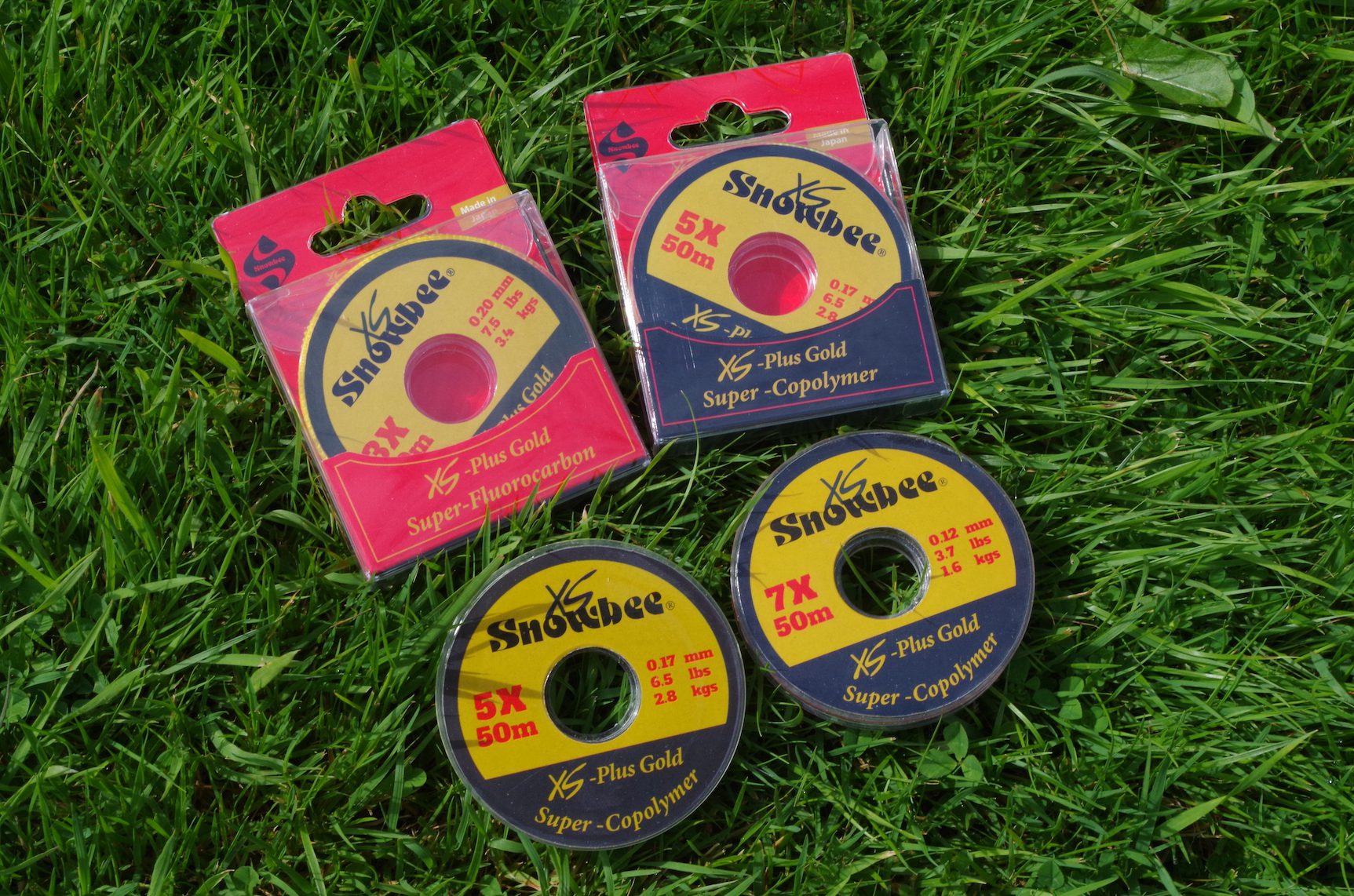
After an hour without success, we headed for the deep water off the dam close to the aeration curtain. This was where Jeff had enjoyed success earlier in the day an area that often fishes well during prolonged spells of hot weather.
I changed over to a fast sink line with a bright booby on the point, a small imitative pattern on the middle dropper and a bright fab on the top dropper. There is a certain fascination with fishing down deep and slow. Expectation that a big hard fighting rainbow will seize the flies far below the boat. This expectation is fuelled as we chat with fellow anglers who have caught a few and lost several powerful fish.
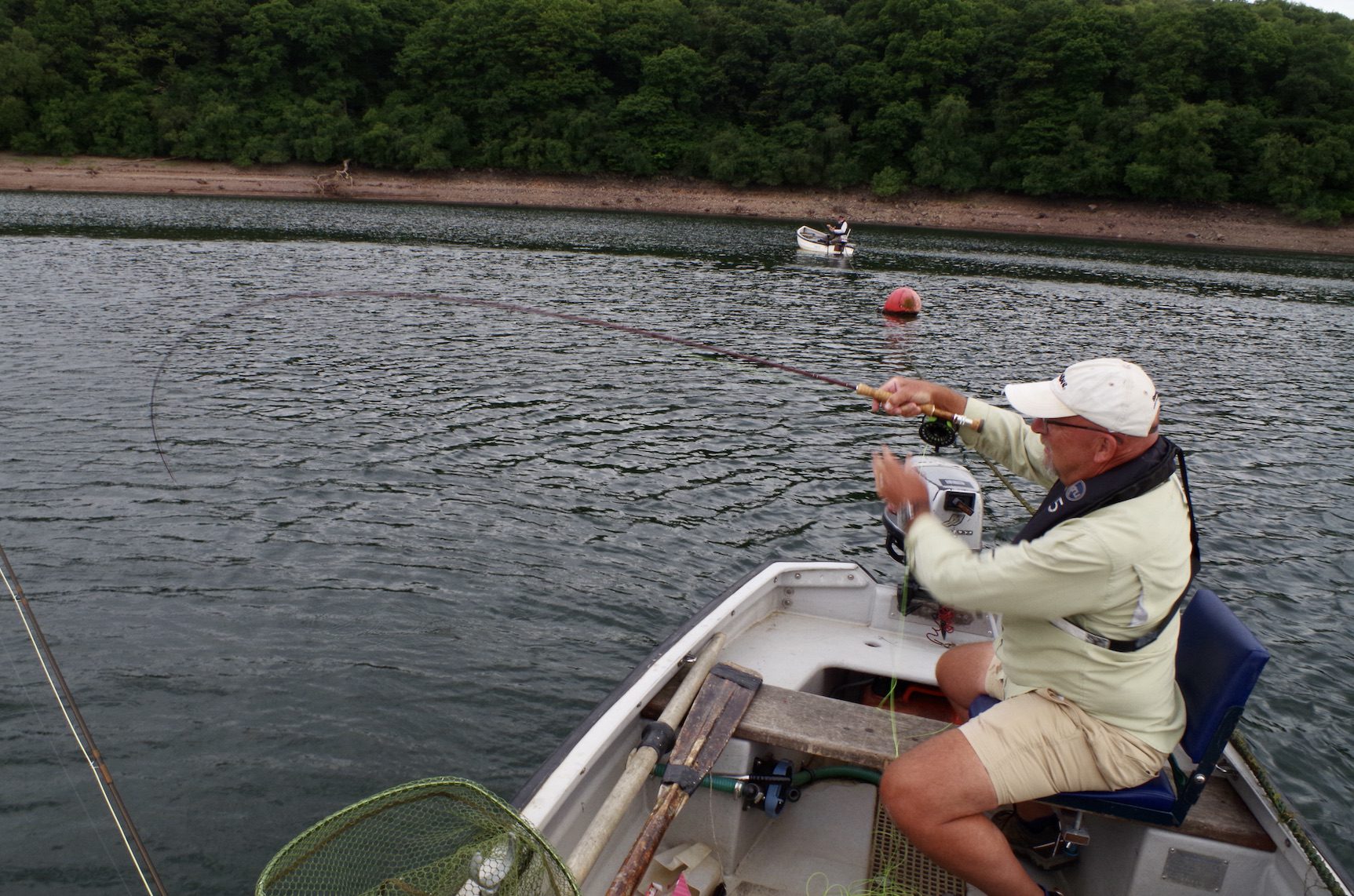
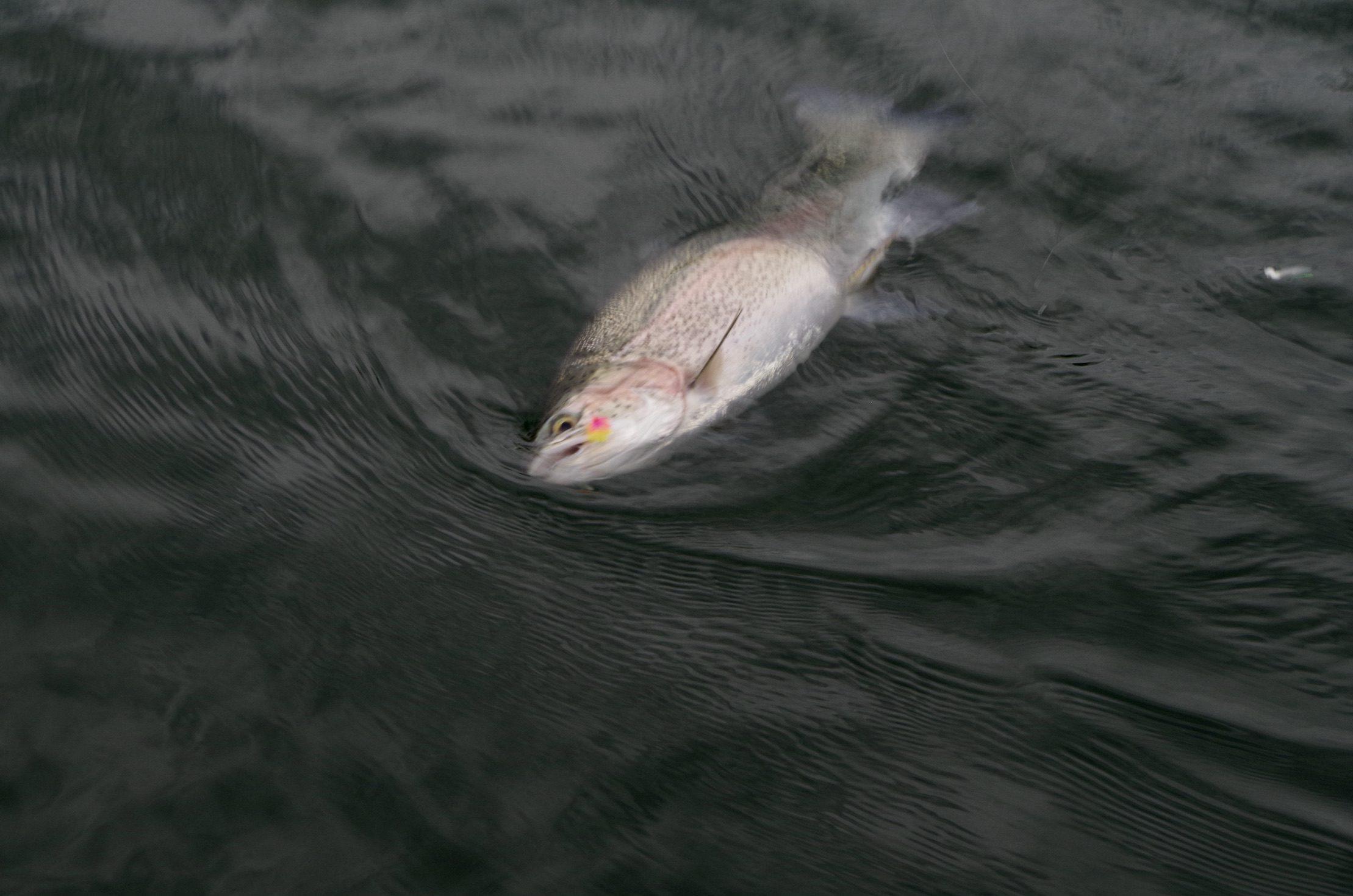
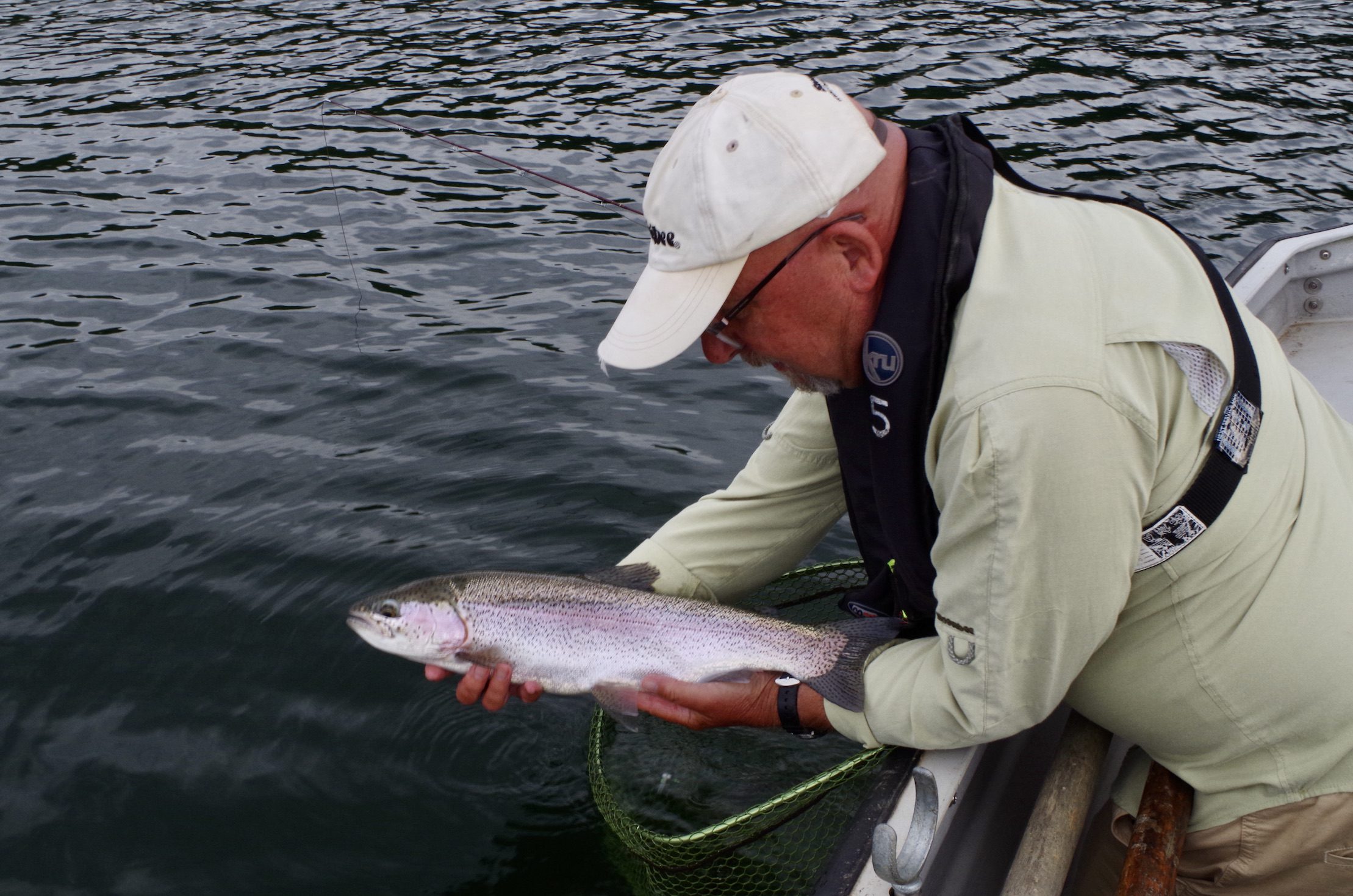
After fifteen minutes Jeff hooks a hard fighting rainbow that battles gamely before being coaxed to the net. I hook a fish close to boat that slips the hook after a short tussle giving my confidence a welcome boost.
As the hot sun beats down I am pleased that I have made good use of a hat and sunglasses to protect from the hot sun. Plenty of water is essential to keep hydrated on these long hot and challenging summer days.

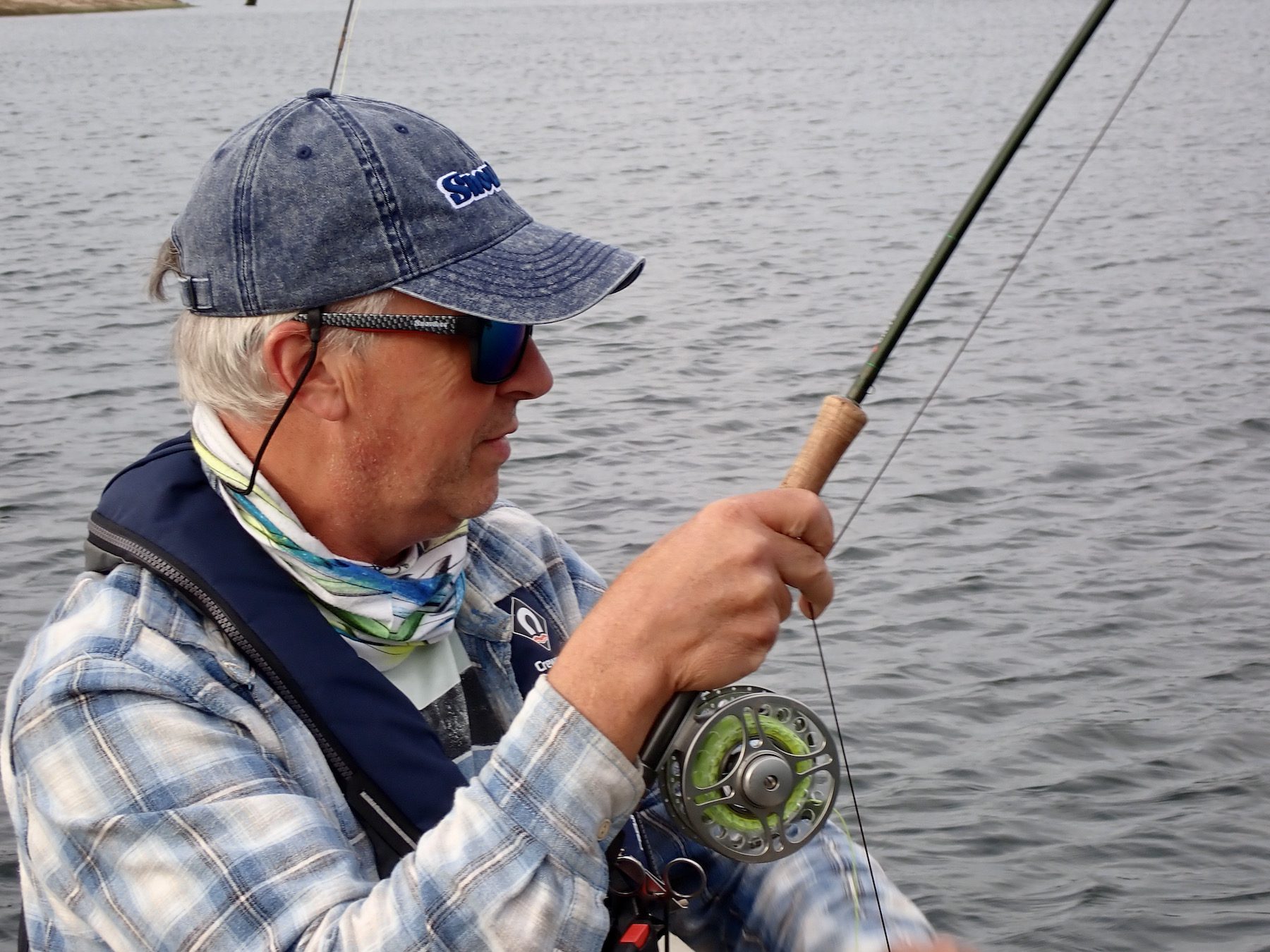
After several changes of tip fly I eventually tempt a hard fighting rainbow of around 2lb. A well earned reward for persisting deep and slow.
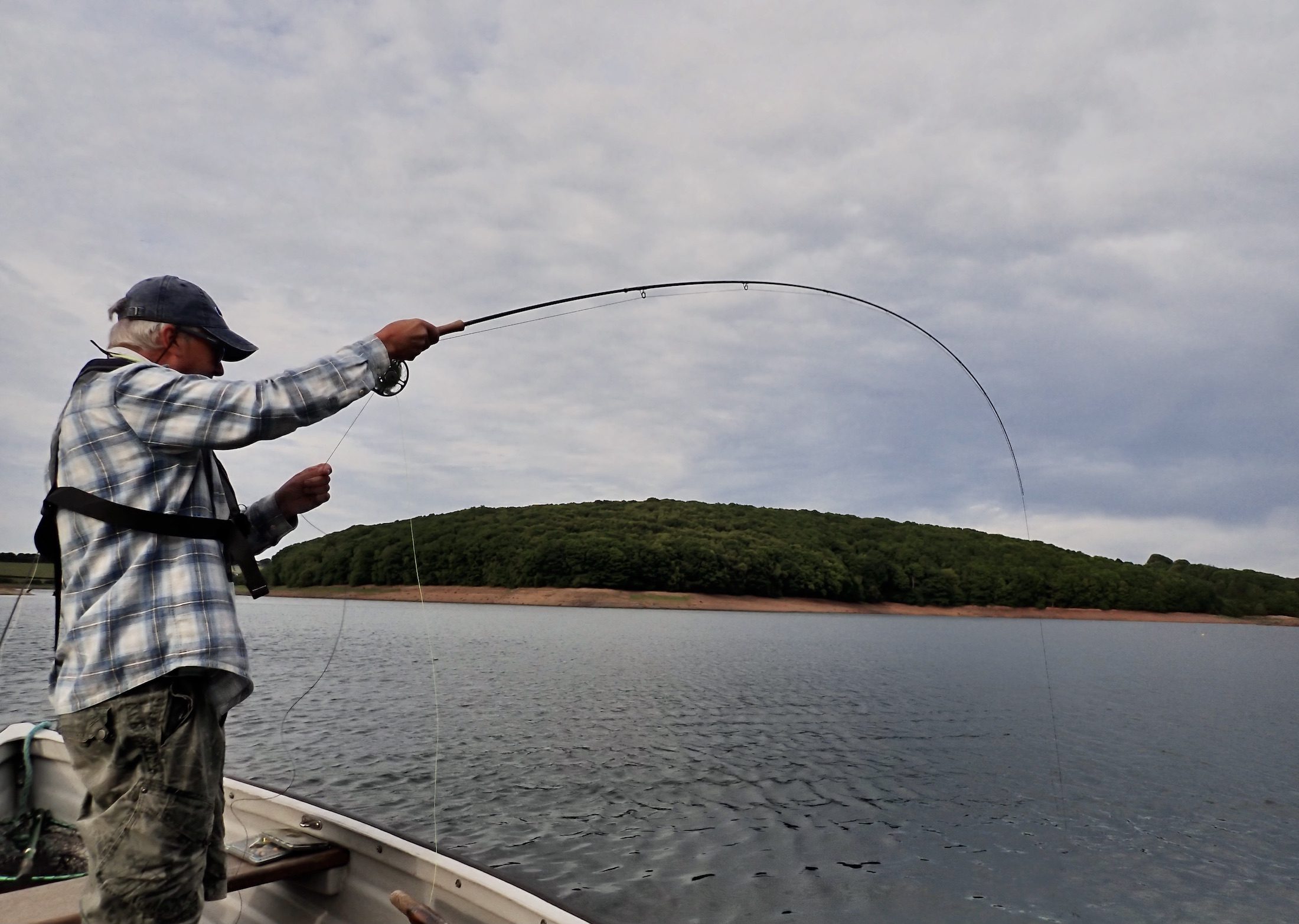
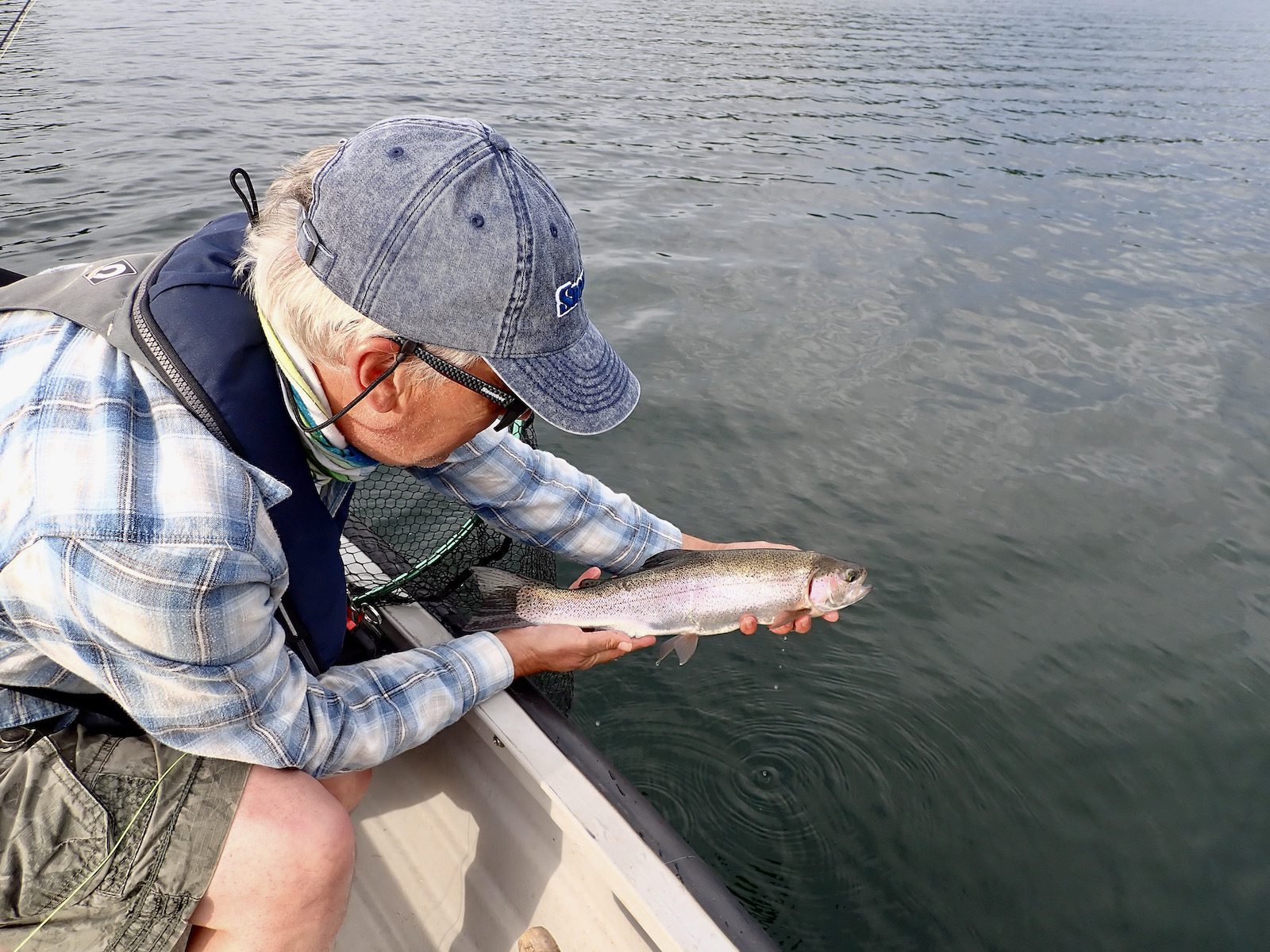
Some excellent fishing can be enjoyed on even the hottest summer days with the deep water undoubtedly the place to target as fish seek cooler waters and increased oxygen levels.
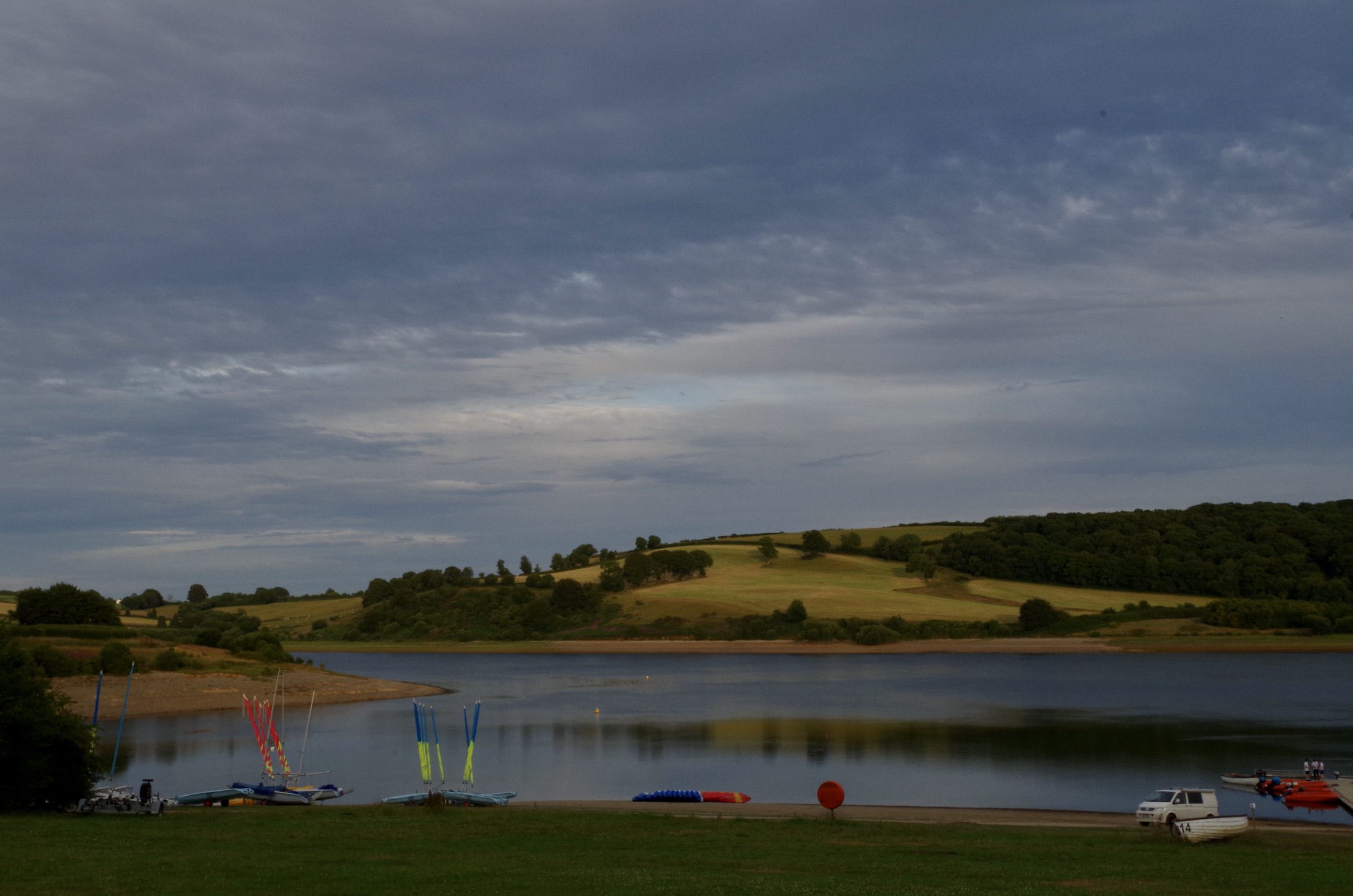

The River Torridge starts its journey close to the Cornish border near Meddon just a short distance from the source of the Tamar and shares many characteristics with this river.
The Torridge meanders through the heart of rural Devon gathering water from various tributaries including the Okement that flows from high on Dartmoor close to the source of its sister river the Taw. The Torridge eventually merges with the Taw in the estuary at Instow.
Rivers have their own unique characters and as an angler it is a delight to tune into this and become immersed into the ever flowing waters. I fish the Torridge throughout the salmon and trout fishing season that commences on March 1st and concludes on September 30th.
Each phase of the season is to be savoured from the cold days of early spring when wild daffodils decorate the banks to those mellow days of early autumn.
Little Warham Fishery is middle river nestled in a tranquil valley close to the village of Beaford. I joined Fly Culture Editor in Chief Pete Tyjas the day after midsummers day to target the wild brown trout that thrive within this beautiful stretch of river
After a long dry spring the river was showing its bones an all too familiar sight in recent seasons that have blighted the salmon anglers hopes. There were undoubtedly a few salmon and sea trout residing in the deeper pools. These fish may well be stirred to take an anglers fly when welcome rain falls to wake them from their slumber.
Anthony and Amanda moved to Little Warham five years ago when my wife and I joined them on a delightful June evening. https://www.northdevonanglingnews.co.uk/2017/06/25/little-warham-fishery/
They have worked hard in those five years nurturing the river banks and restoring the farmhouse to provide stunning self-catering holiday accommodation.
http://littlewarhamfishery.co.uk/accommodation/
Despite visiting the fishery five years ago this was my first trip to the fishery armed with a rod and I was eager to share a day’s fishing with Pete. Pete had visited the river several years ago when it was still owned by Terri Norton Smith. After a quick chat with Anthony, I bundled my gear into Pete’s four wheel drive and we set off for the river. A long and bumpy farm track eventually took us to a shaded anglers car park within the woods above the river.
It was at this point that I realised that I had left my camera, polaroids and hat on the front seat of my car back at the farm house. Fortunately, Pete had a spare hat and my phone would be adequate as back up to the camera.
We gathered our tackles and descended down the steep steps to the fishing hut depositing our lunch boxes and water. We placed our rods upon the rack beneath the hut and climbed the rustic steps. The veranda of the hut has a couple of seats on which to rest and admire the splendid view.

The inner confines are as a fishing hut should be retaining a timeless feel that has been shared by many generations of anglers. Above the fireplace is an etching of a salmon on a plank of wood. Testament to a salmon of 33lb, part of a catch of six salmon totalling 107lb made in April close to 100 years ago.

Pete and I chatted about the Torridge its history and challenges faced by the river and its salmon. Some of this chat may well be broadcast via the popular Fly Culture Pod cast.
The Torridge has inspired several authors over the years most famous of these is undoubtedly Henry Williamson, his books ‘Tarka the Otter’, ‘Salar the Salmon’ and ‘A Clear Water Stream’ weaving a rich tapestry of descriptive prose. Lemon Greys classic fishing book ‘Torridge Fishery’ tells of the fishing above Little Warham and is a worthy book for any salmon angler’s library. Charles Inniss’s book ‘Torridge Reflections” published in 2012 is a delight to read reflecting on Charles years on the river at the Half Moon Inn. The poet Laurette Ted Hughes was also inspired by the Torridge and his work is celebrated in ‘The Catch’ by Mark Wormald, published in 2022.
Pete and I were both keen to head for the river and set off to fish the upper beat above the hut on Anthony’s advice. We both set up with a duo set up a large bushy dry fly beneath which was suspended a small nymph pattern.

The Torridge is a peaceful river running much of its length far from roads or rail unlike the Taw that is flanked throughout most of its length by both. The summer valley was filled with birdsong as we approached carefully navigating through the lush green summer foliage. It had rained the previous night and the river had we were told risen by less than two inches. There was perhaps a slight tinge of colour but it was difficult to tell as the Torridge is never crystal clear like its sister river the Taw. We were hopeful that this slight influx of fresh would stir the trout to feed but the fish do not always read the script.
With the river running so low we both agreed that the best areas to target would be the faster running riffles and runs where oxygen levels would be enhanced. This faster water also gives discerning trout less time to inspect our offerings.
A flash of electric blue flashed past above the twinkling water. The sight of a kingfisher however fleeting always lifts the spirits an image that cannot be adequately painted with words. Damsel flies were also abundant hovering above the river and alighting on the riverside cow parsley its delicate white flowers punctuating the vivid greenery of mid-summer.
The sun was beating down from a cloud free blue sky and we looked for shady lies to cast our flies. Pete wandered further upriver; I extended a line but was irritated to find I had missed out a rod ring when threading the line. A few minutes or two of retackling resolved the issue and at last I managed to put out a line on the water.
The buoyant bushy dry fly bobbed down on the surface a tiny nymph suspended beneath. I focussed intently expecting the fly to disappear at any second as a trout seized the nymph below. I worked slowly upriver searching the water without early success.
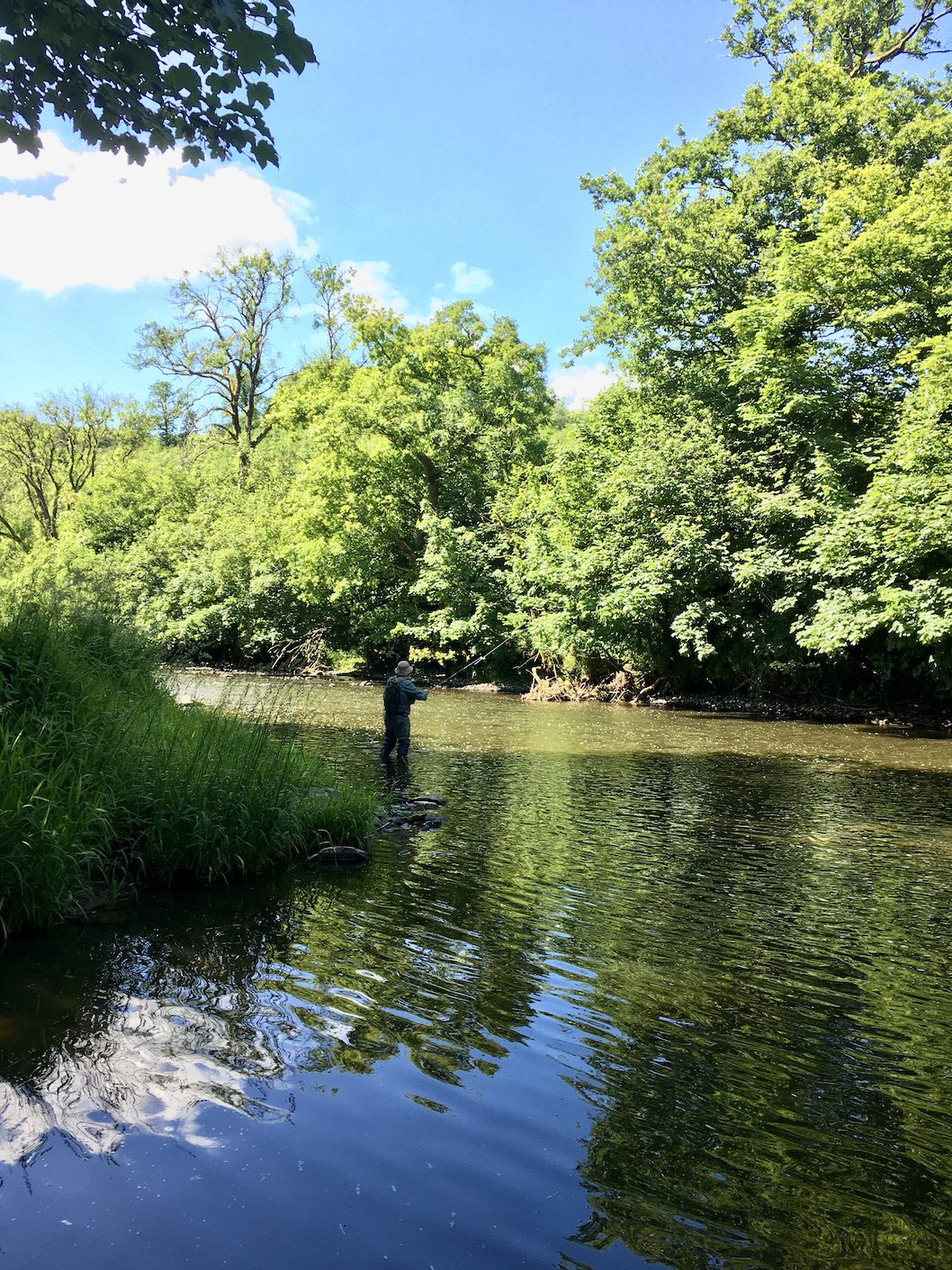
I snagged a high tussock of grass on the back cast just as the fishery owner Anthony appeared to witness my incompetence. Anthony was accompanied by his four year old son, Brook was fascinated by the mysteries of the water’s edge. I helped him to turn stones in the search for life whilst Pete chatted with Anthony about their first five years at Little Warham.
After this short interlude our quest continued. My fishing rhythm eventually arrived after a slow start. Casting a 3-weight and tiny flies was a stark contrast to the large pike flies I had been casting two days before on the vast Chew Valley Lake.
Casting into the head of a shallow run the dry fly disappeared and I lifted the rod to feel the thrilling pulse of life on the line. In a second or two it was gone a small trout that had brought a welcome slice of optimism.
The morning drifted by as we waded the river searching and reading the water as we savoured the summer river.

By midday we had covered the upper beat and decided to return to the fishing hut for a snack and a cool drink. As we walked the river bank we talked of fishing, of cricket and of people we knew.

Back at the hut it was good to take a break savouring the summer views from the open porch. The Torridge flows beneath the fishing hut through a long deep pool where it is easy to imagine salmon and sea trout resting. On the opposite bank a tall coniferous forest towered high whilst at the rivers edge mighty oaks dominate casting welcome shade across the pools. We discussed the trout’s apparent reluctance to feed reminiscing on the many excuse’s anglers concoct when the fish refuse to play the game. A bright hot summers day with a North East wind was always going to be a challenge.
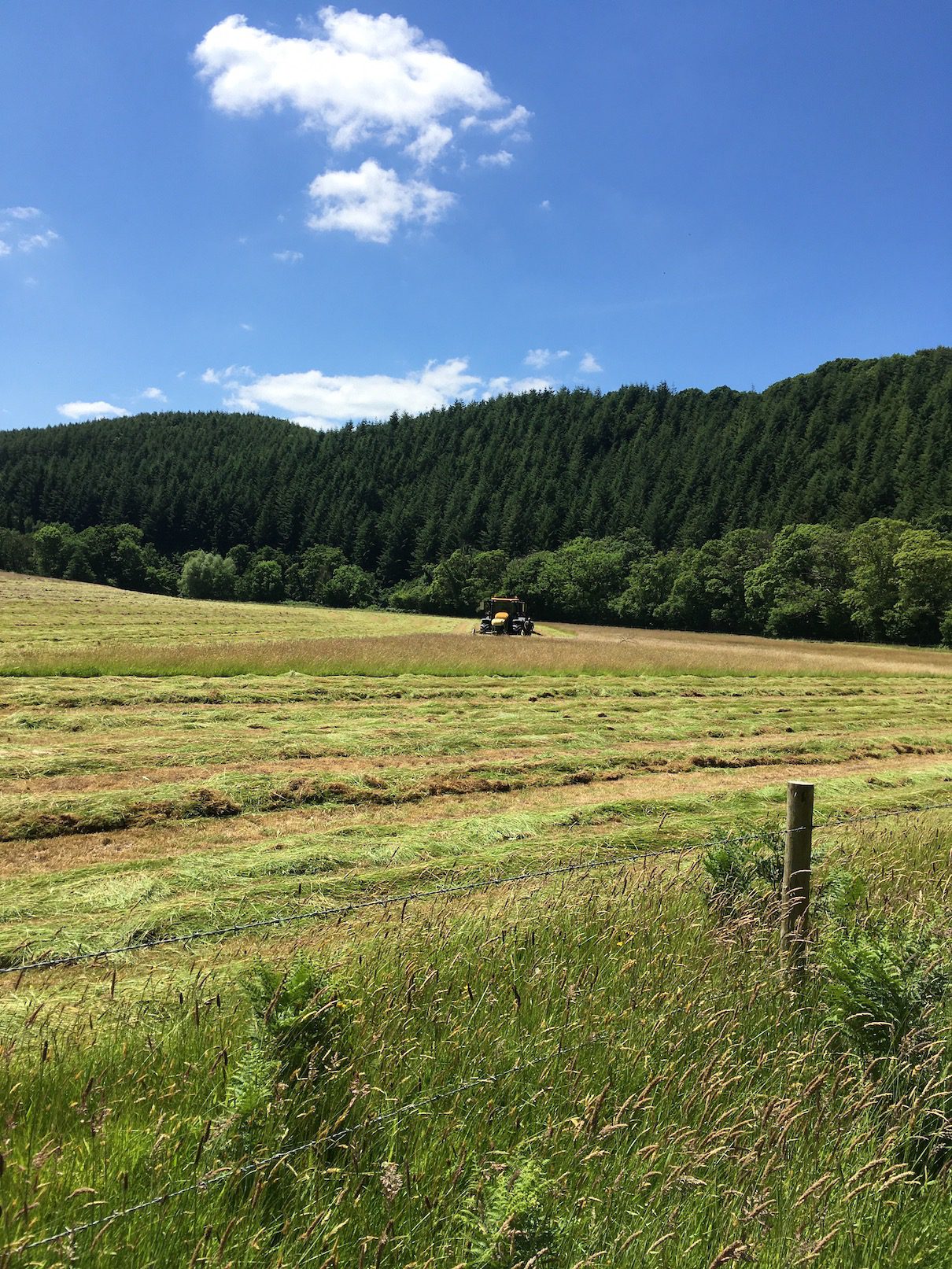
The afternoon would surely bring its rewards. We picked up our rods and strolled down towards the bottom of the beat. A long shady run beneath a wooded bank took our fancy and whilst Pete headed towards the tail I started midway flicking out the trusty duo.

The fly disappeared, I lifted the rod and the light rod flexed in my hands. The small wild brown leapt from the river and battled gamely for a few moments. The barbless hook slipped from its jaws and I admired its beauty for a moment before allowing it to swim back from whence it had come.

The river tumbled from pool to pool cascading over rocky ridges into deeper pits. Long shallow riffles and slowly swirling eddies. The steep wooded banks and dense vegetation creating a rich habitat. Throughout the day we continued to catch welcome glimpses of kingfishers as they streaked past.
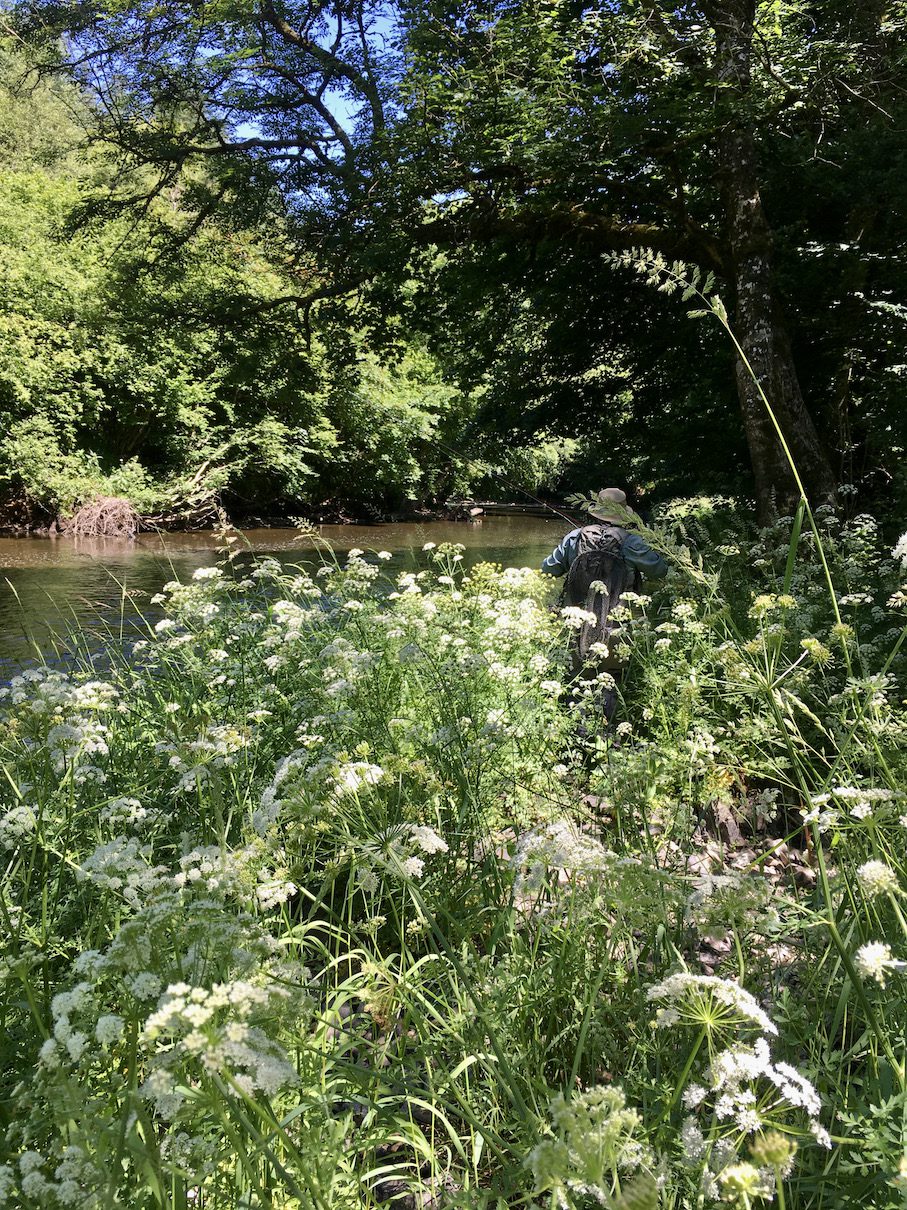
The hot sun beat relentlessly into the valley. Climbing up and down the banks and pushing through high vegetation perspiration dripping from my forehead reminded me of a jungle movie scene. With a throbbing head I recognised the early symptoms of heat stroke and set off for the fishing hut and a cool drink of water.
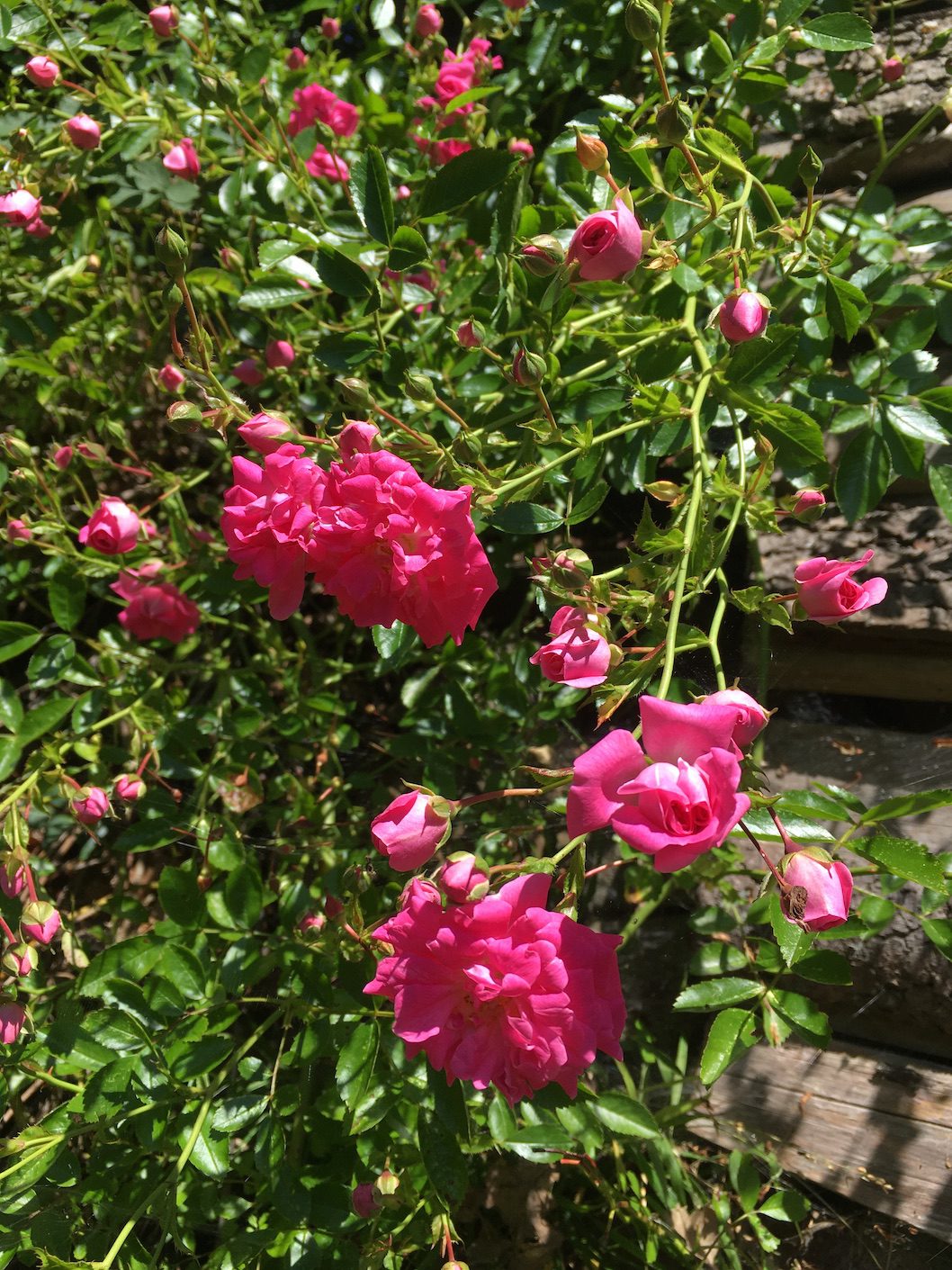
I found Pete fishing beneath the overhanging tree canopy where he had spied rising fish. I wished him well and went on my way to the hut.
After a cool drink I wandered back to find Pete stood mid river. Izaak Walton ended his classic book the ‘Compleat Angler’ with the phrase “Study to be Quiet” a phrase that is said to embody the philosophy of tranquillity and solace in angling. It was a pleasure to watch Pete’s skill at casting a delicate line across the water emersed within a kaleidoscope of reflections.

Anthony who had been cutting the grass appeared at my side and we both watched as Pete gave a commentary on the fish he had spied rising quietly under the shady bank. He had stood quietly observing and merging into the river scene. Numerous dry flies had been tried without success. After each offer to the trout, he had rested the water totally focussed upon deception. A dimple upon the surface and a tell tale ring. Pete’s line glided out the fly alighting on calm waters to drift over the fading rings. A swirl, a curse. Twice more the fish was tempted and escaped the hook! Pete reluctantly wound the line onto his reel and slowly waded towards us. Once again the water was broken by the rising fish. Pete caught the movement in the corner of his eye and stopped. Carefully he worked out the line and took careful aim dropping the dry fly precisely. The delightful moment of deception was followed by a flurry of spray. The rod pulsed and bended as the fish dashed for freedom.


It was soon safely in the net a beautiful wild brown trout with red and black speckled flanks of olive and bronze. At around a pound it was a wonderful prize earned by slowing down, observing and applying a large degree of patience and stealth.
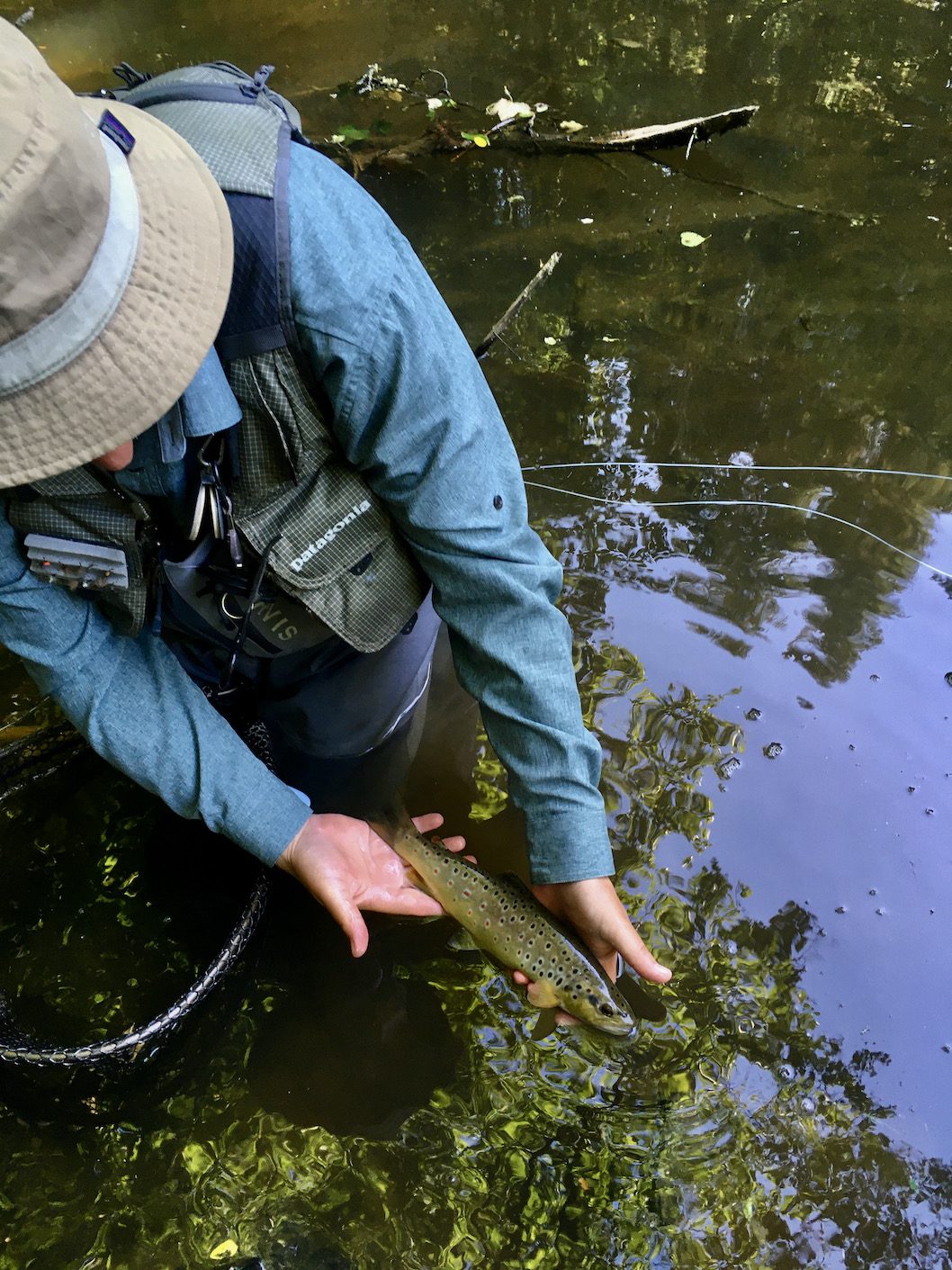
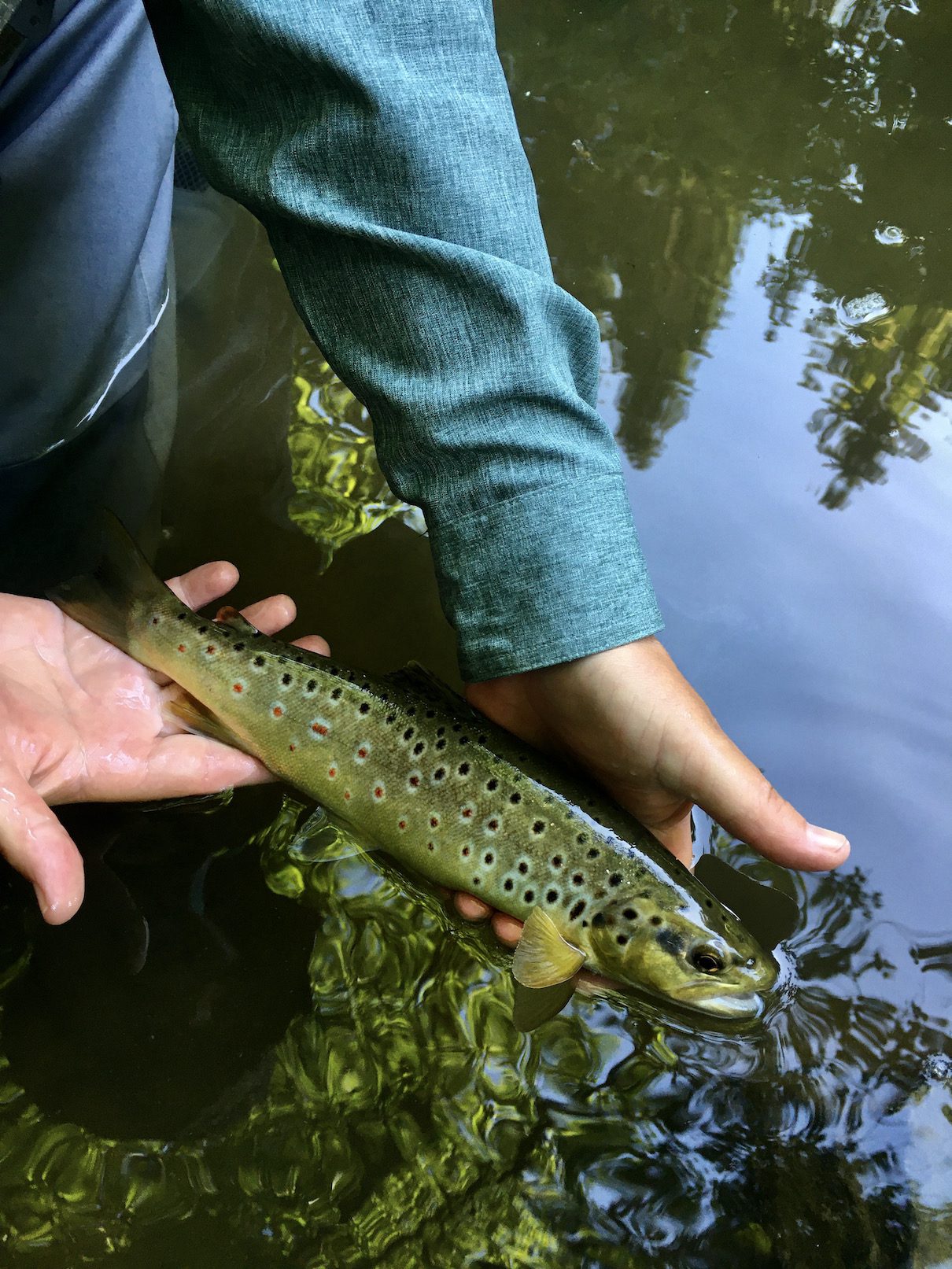
As we walked back to the car I spied a rising fish but with throbbing head and creeping nausea I knew that the fish would have to wait for another day.
I have been visiting Chew Valley Lake on a fairly regular basis since it opened to pike angling on a limited basis in October 2001. Since those early days the lake has built on its reputation for producing huge pike and I have long dreamt of catching one of these huge fish.
Whilst I have tempted several twenty pound plus pike on lures and dead-baits during the annual pike trials my most successful days have come whilst fishing with the fly. My best pike being a fish of 27lb 12oz caught on a fly in April 2008.
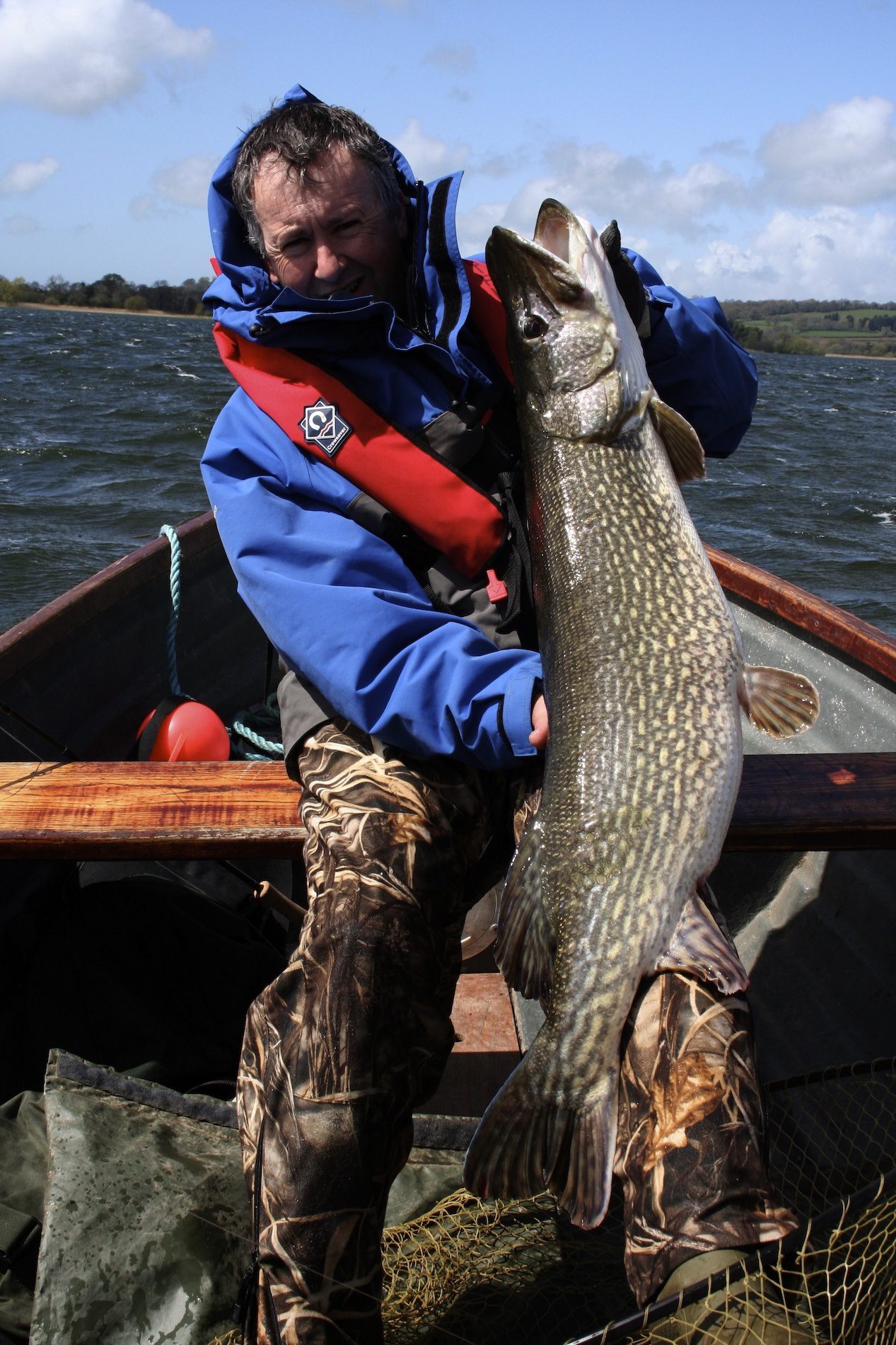
Spring time from late March through until late June and September are the months I try to visit with the fly rod. During the warmer months of summer pike are potentially susceptible to stress with water temperatures high and weed growth extensive.
On each visit to this vast 1200 acre lake there is the knowledge that the pike of a life time could be just a cast away. The desire to catch the elusive thirty pound pike has resulted in many years of heartbreak for dedicated specimen hunters who visit the lake year after year enduring many blank trips and days when just jacks seize the bait, lure or fly.
I have always enjoyed fishing the lake and whilst I always hoped to catch the monster I generally just enjoyed the fishing. The lake has an abundance of wildlife and the vast sheet of water always provides a spectacular back drop throughout the seasons.
On June 18th, 2022 my luck was to change when I fished the lake with my good friend Steve Dawe. As is often the case when catching a big fish there was a big slice of luck involved with circumstances combining to bring about success. Several big pike had already been landed earlier in the season. Bruce Elston a long time fishing companion boating a huge pike of 33lb 13oz in May. Steve and I booked a boat for June 14th and were looking forward to a day on the lake despite the forecast of hot sunny weather. The afternoon before I received a call from Bristol Water to say that due to staff shortages they would have to cancel all of the boats. They offered us alternative dates of the following Friday or Saturday. The only day that both Steve and I could make was the Saturday so on Saturday morning I met Steve at the fishing Lodge for 8:00am.
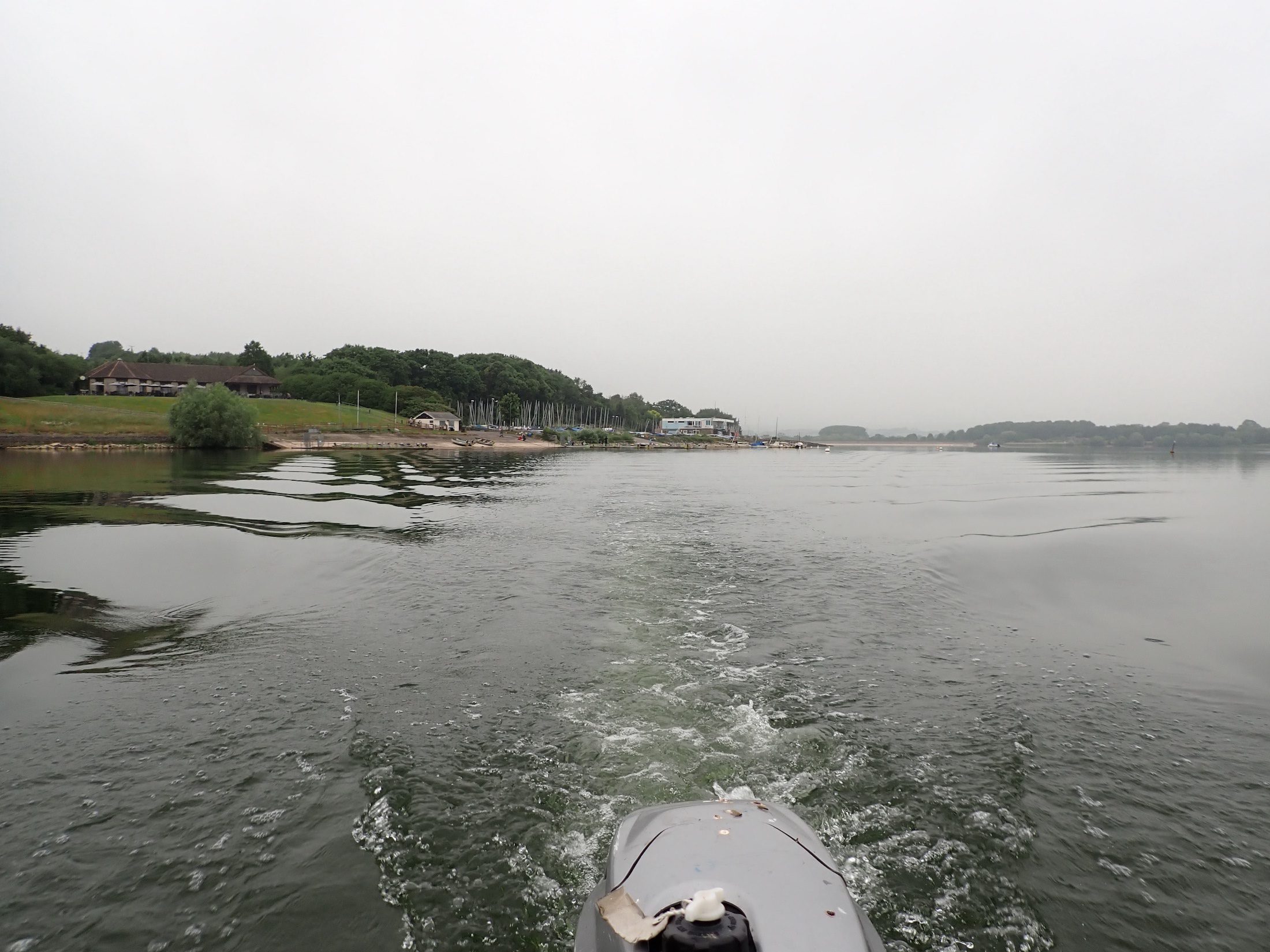
We steamed out onto a flat calm lake beneath a dark and cloudy sky. This was perhaps our first stroke of luck. The previous day had been the hottest day of the year so far with temperatures into the high twenties. The cancelled day on Tuesday had also been hot and sunny. These conditions seemed far more conducive to the search for pike.
As we steamed out we talked of the Chew Valley giants and of the lake’s history and the expectation that always lingers. There is much talk of the pressure of fishing for these pike yet when you steam out you realise that this is a vast body of water and locating pike is not always guaranteed. Add to this that the pike needs to be feeding and you soon appreciate that finding a big pike is like finding the proverbial needle in a haystack.
Basing location on previous experience and instinct we headed for a favoured area and commenced a drift. At first there wasn’t a breath of wind to move the boat. We knew that this was to be short lived as the forecast gave a strengthening northwest wind.
As predicted within half an hour the wind picked up and the drogue was employed to slow the drift. An hour into the trip and we had not had a pull or seen a follow. After five minutes of starting a drift I observed a boat that I thought we would drift closer to than we would like. This was perhaps the key stroke of luck. I pulled in the drogue and motored fifty yards closer to the shore. As we set off on a new drift I noted that the boat we had moved to avoid had motored elsewhere!
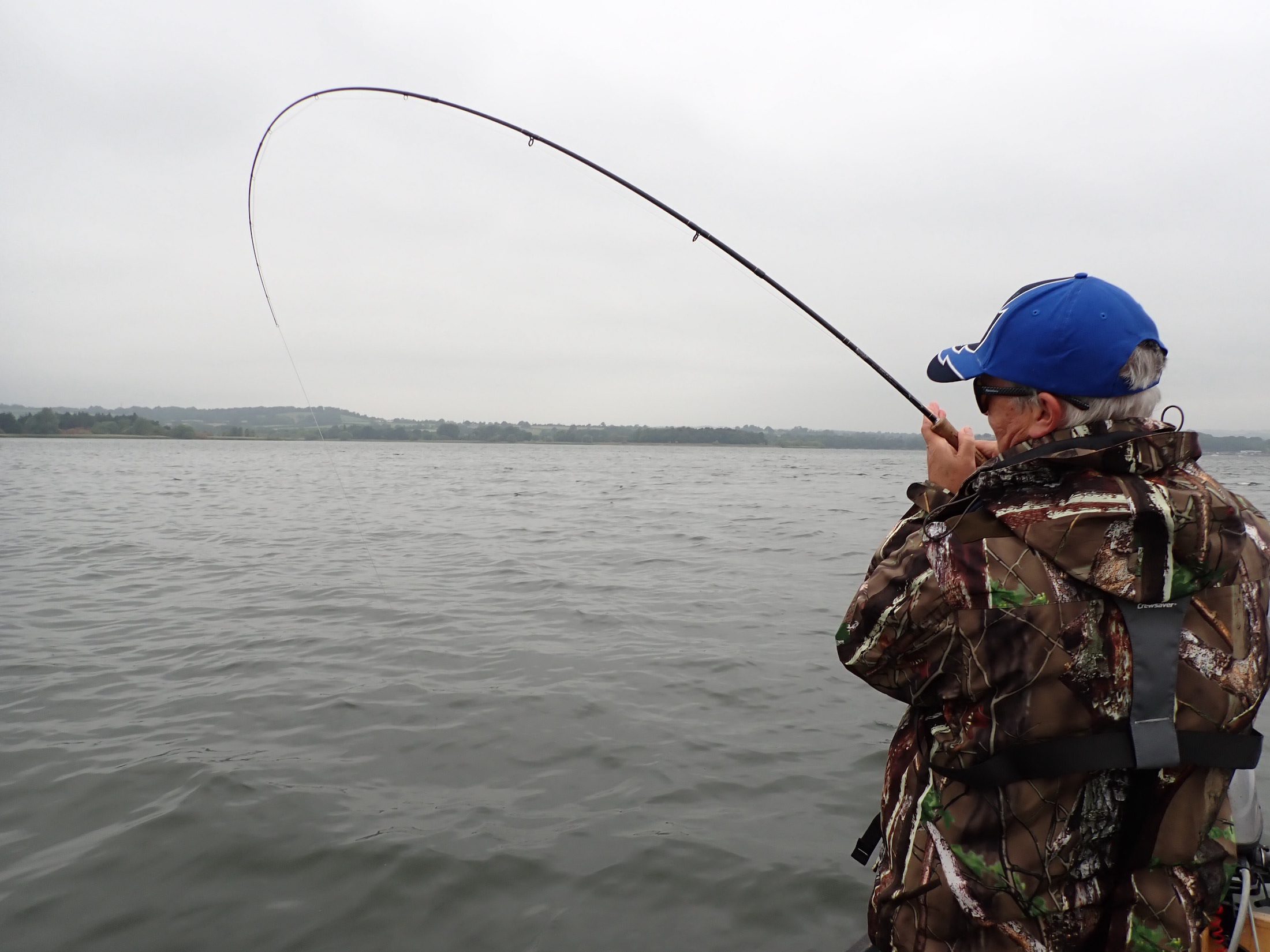
We need not have moved but this new drift line proved to be fruitful beyond our wildest dreams. A few minutes into the drift the line was jerked tight as something big hit my fly. There was nothing I could do initially as what was undoubtedly a big fish surged away stripping line from the reel. I tend to play fish hard and piled on pressure as soon as I could. The fish circled the boat fortunately on a long enough line to miss the drogue that hung behind the drifting boat. The fish made repeated powerful runs against maximum rod pressure. We both knew that this was a big fish but were still shocked when we eventually glimpsed the magnificent creature in the water.
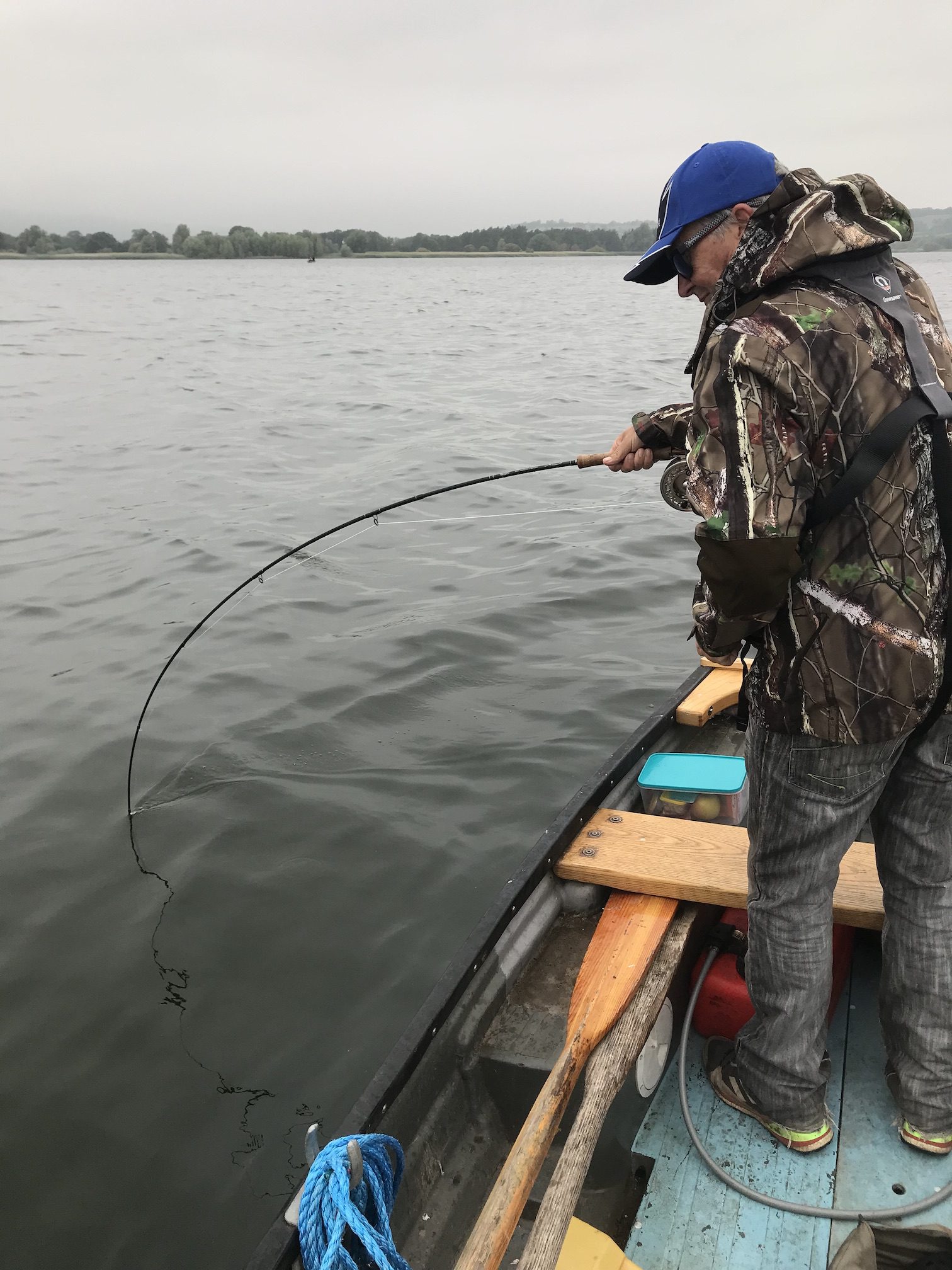
At this moment the wire trace seems worryingly thin. This is the fish of dreams; how good is the hook hold? Fear and anxiety play on the mind for these vital final moments of drama. Steve sank the net beside the boat and I coaxed the pike closer until it was over the net. Steve lifted and I gave a shout of triumph; YES !!!!
A warm shake of hands in celebration of shared success.
I held the net as Steve prepared the unhooking mat dousing it in cold water. The scales were readied and weigh sling set up. Both cameras were switched on in readiness. I lifted the pike from the water shocked at its weight. I slipped the barbless 6/0 from its jaws and lifted the fish from the net. I rested the huge fish onto the weigh sling and allowed Steve to witness the weight. The reading fluctuated between 42lb and 43lb so subtracting 4lb for the weigh sling the weight of the pike was a minimum of 38lb.
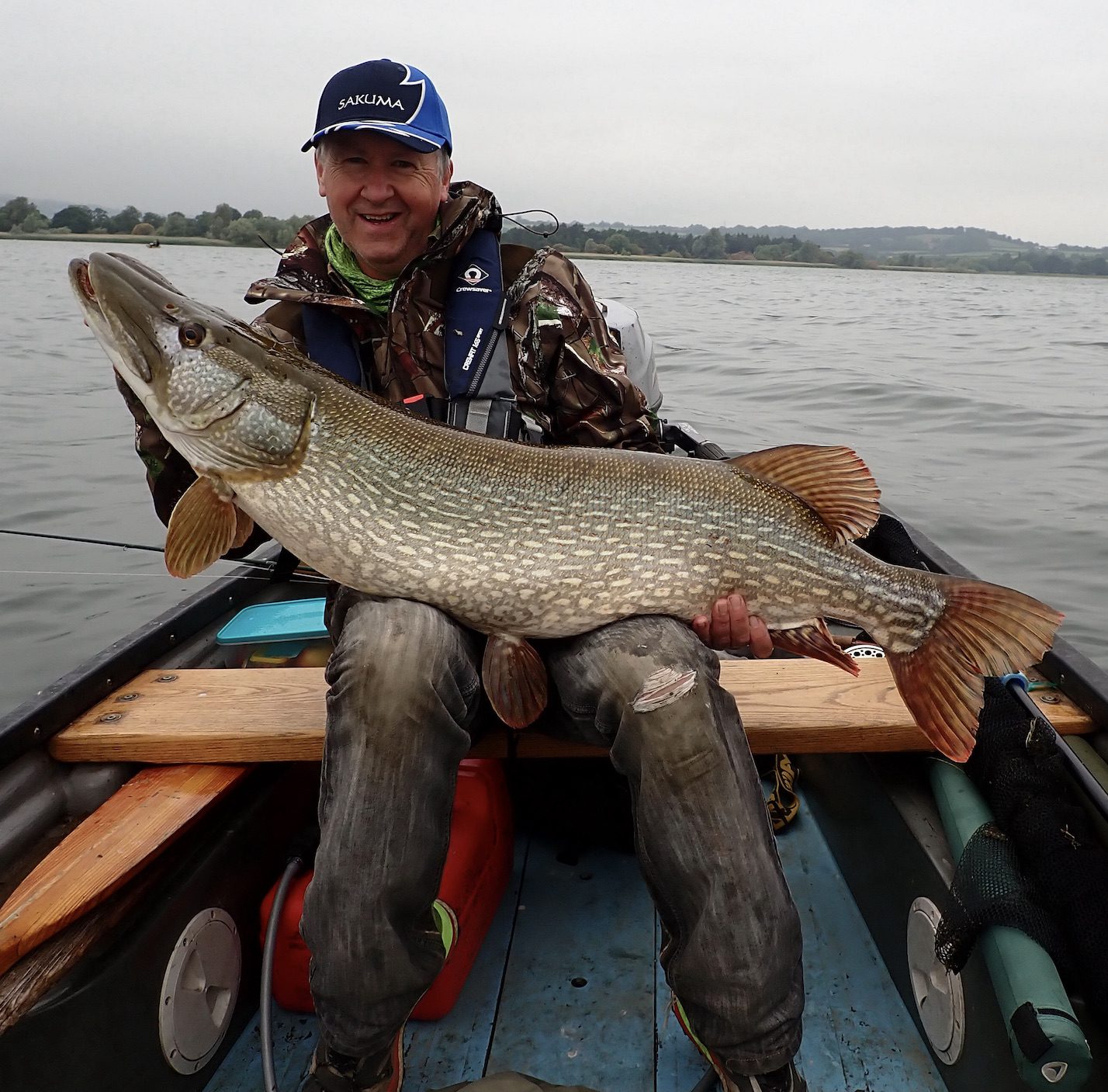
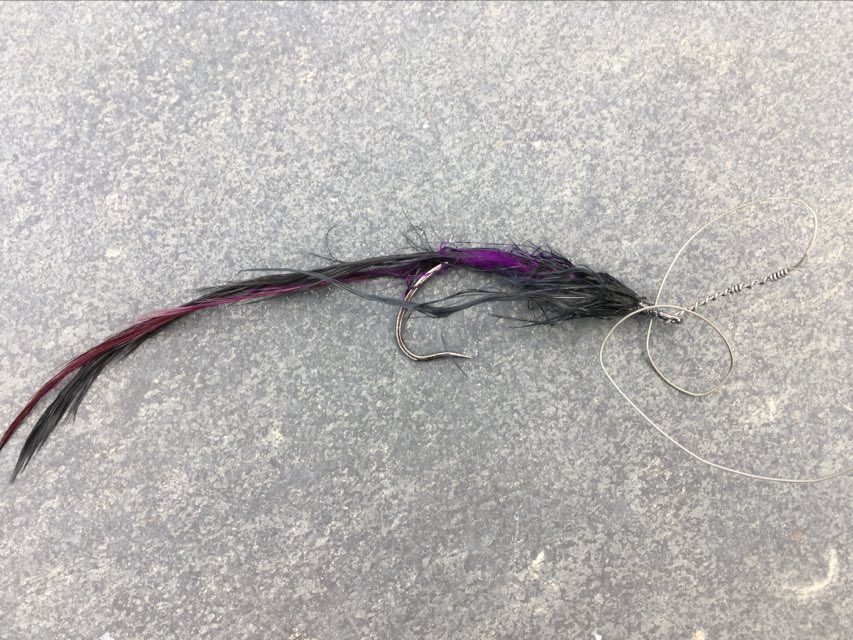
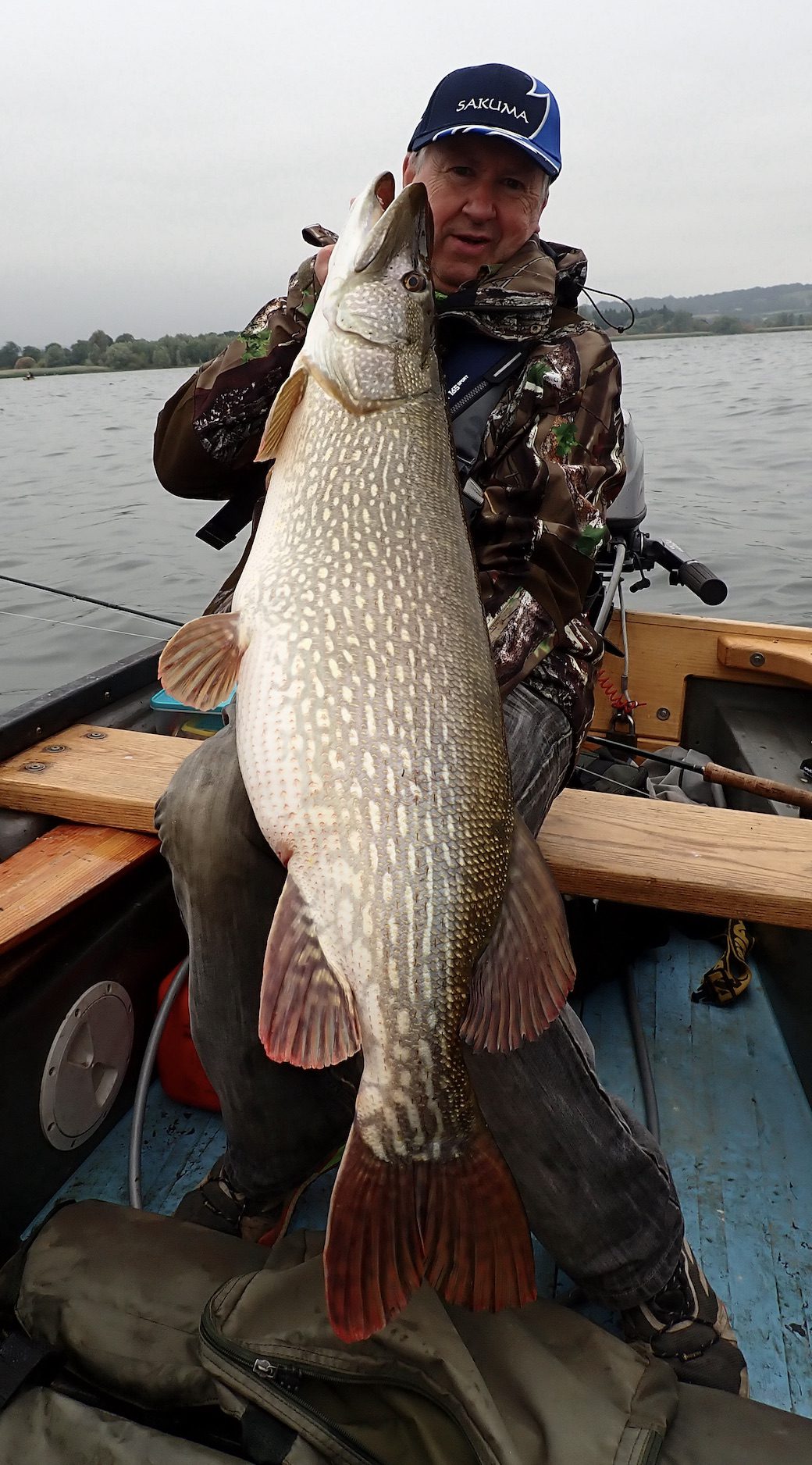
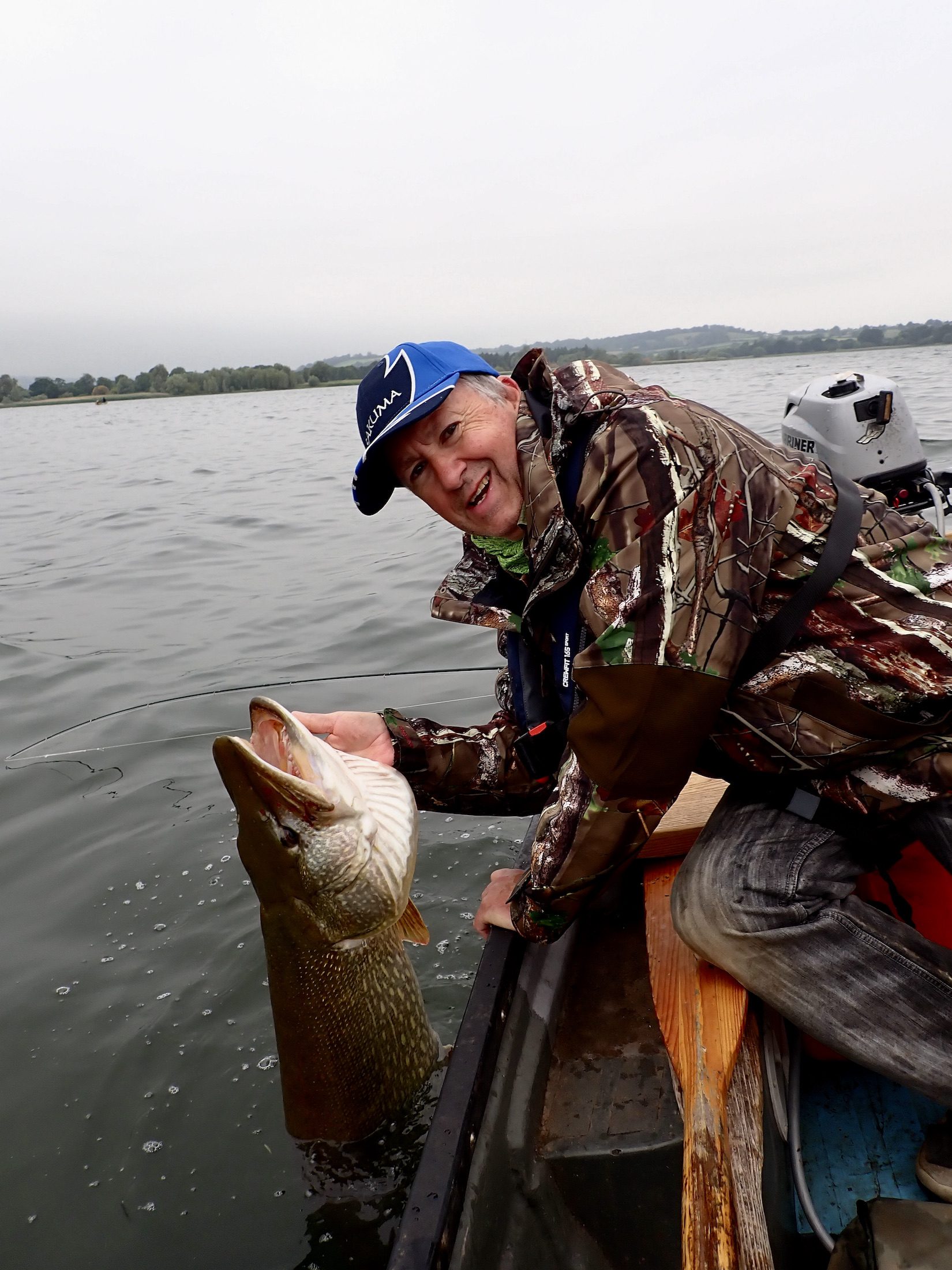
I cradled the fish briefly for a couple of photos then held the fish in the water for a few moments. I released the fish when I felt it was ready and watched as it sank slowly before swimming strongly away coming to the surface just in front of the boat to disappear with a defiant swish of its tail.
Such moments in a fishing life always seem slightly surreal. To catch early in the day is perfect as for the remainder of the day you can just bask in the reflection of success. There is of course the knowledge that the conditions are good and that just maybe another big pike will succumb.
We had several more drifts in the same area catching numerous jacks of between 3lb and 4lbs. Even these small pike give a surprisingly good account on fly tackle.
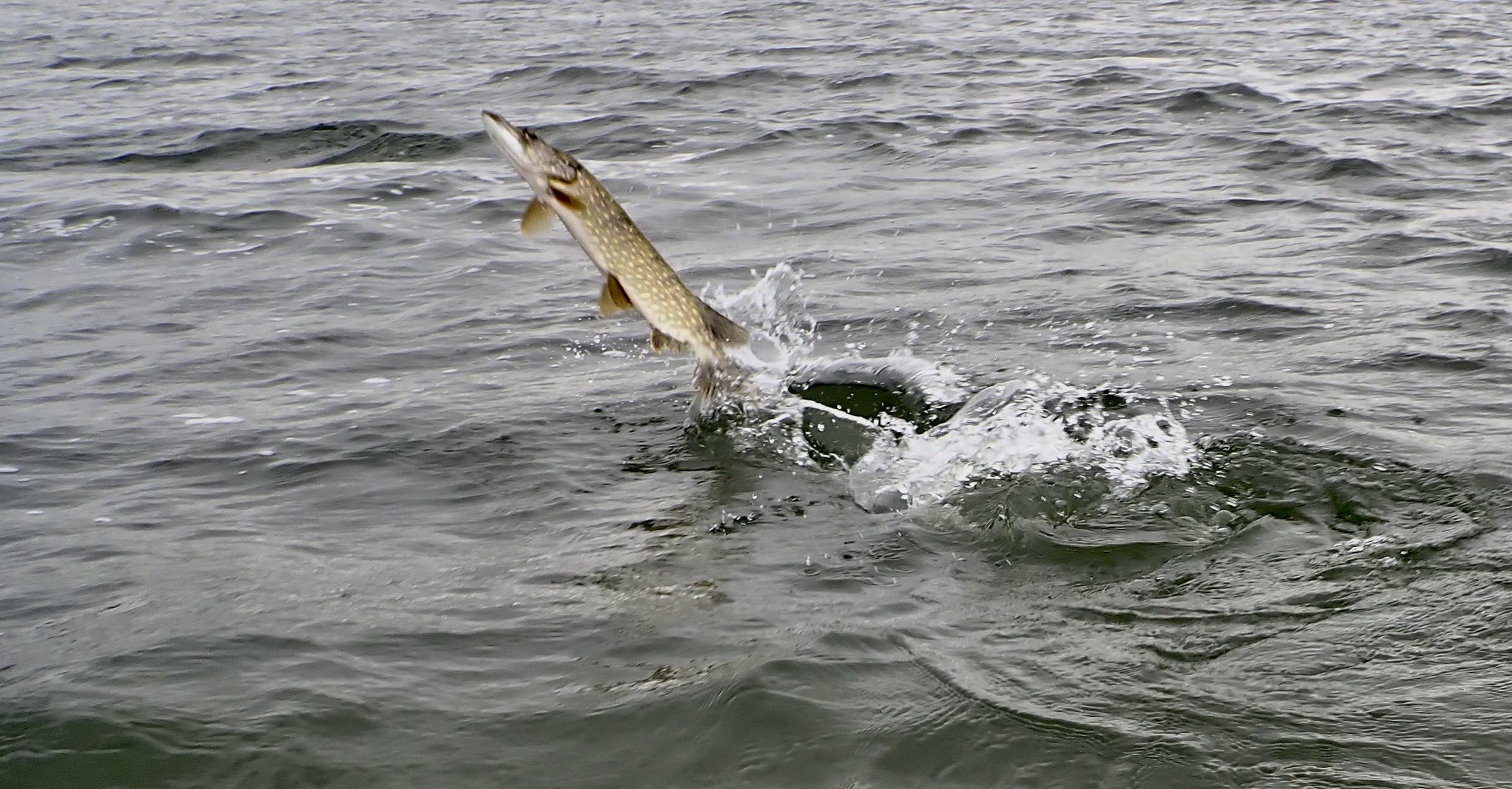
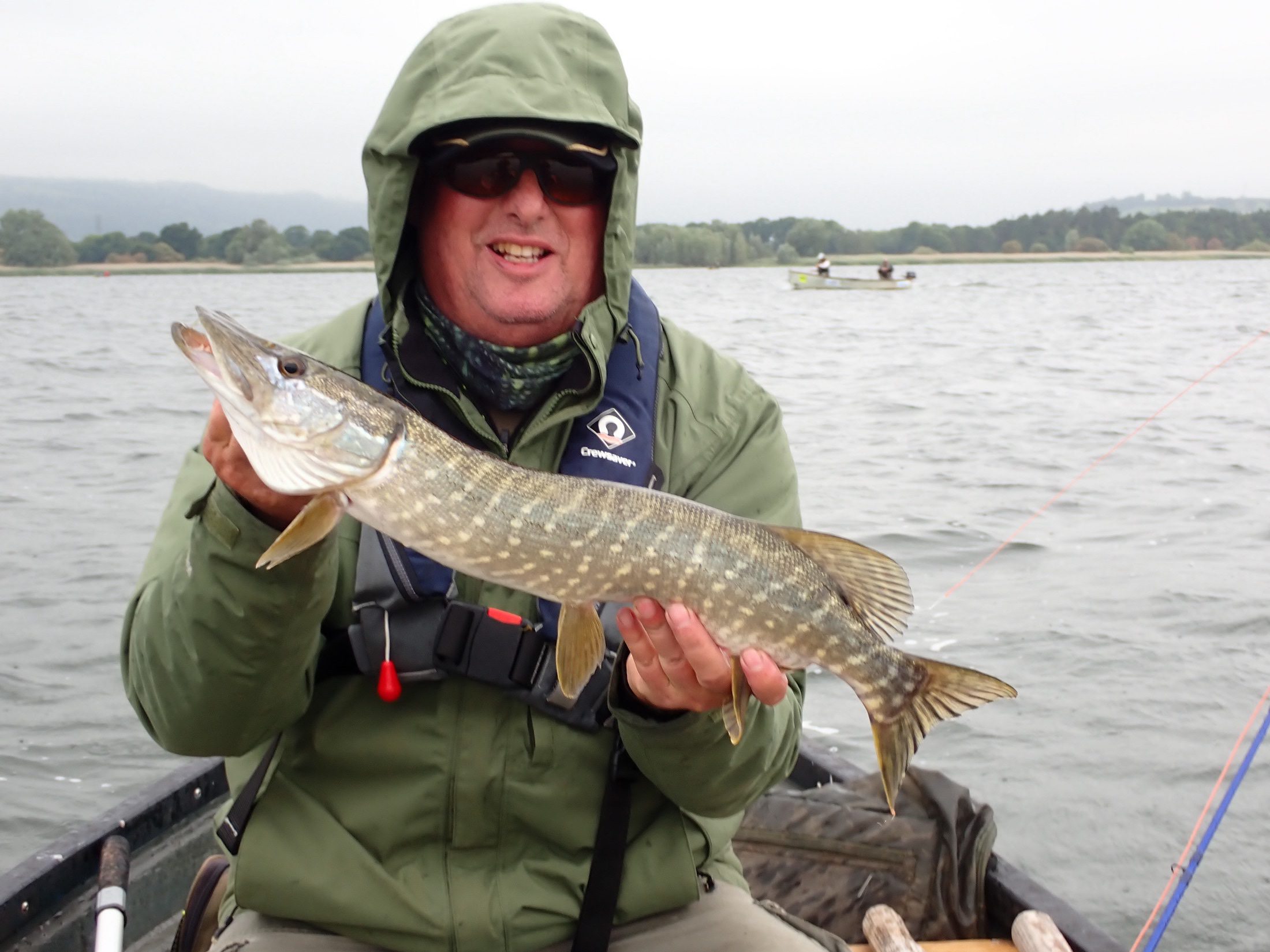
We tried drifts around various areas of the lake finding a few jacks at each location often at the edge of deeper water where weed growth provided some cover.
It was good to note large numbers of swifts swooping over the water feasting upon the prolific fly life that helps make this a superb trout water.
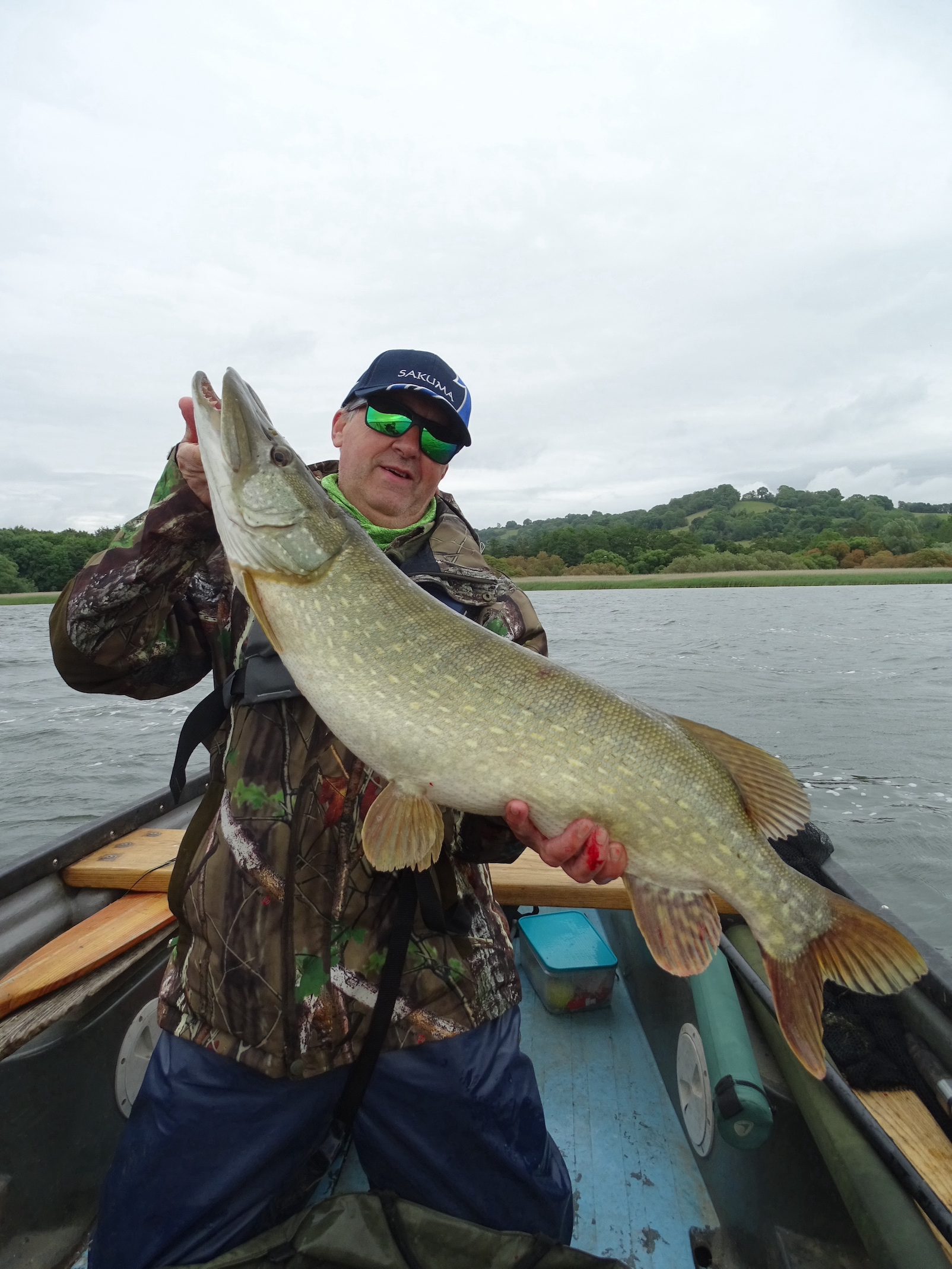
We returned to the area that had produced the big pike and after a couple of drifts I was pleased to add a 16lb 5oz pike to the days tally. This was followed by Steve hooking into a fish that powered away stripping line form the reel at such an alarming rate that Steve feared he would run out of line. I pulled in the drogue just in case we had to follow and was relieved to see Steve’s backing knot approaching the rod tip. After several more powerful runs a large pike eventually appeared beside the boat was soon safely within the waiting net. At 20lb 5oz it was a best on the fly for Steve and cemented a highly successful day.
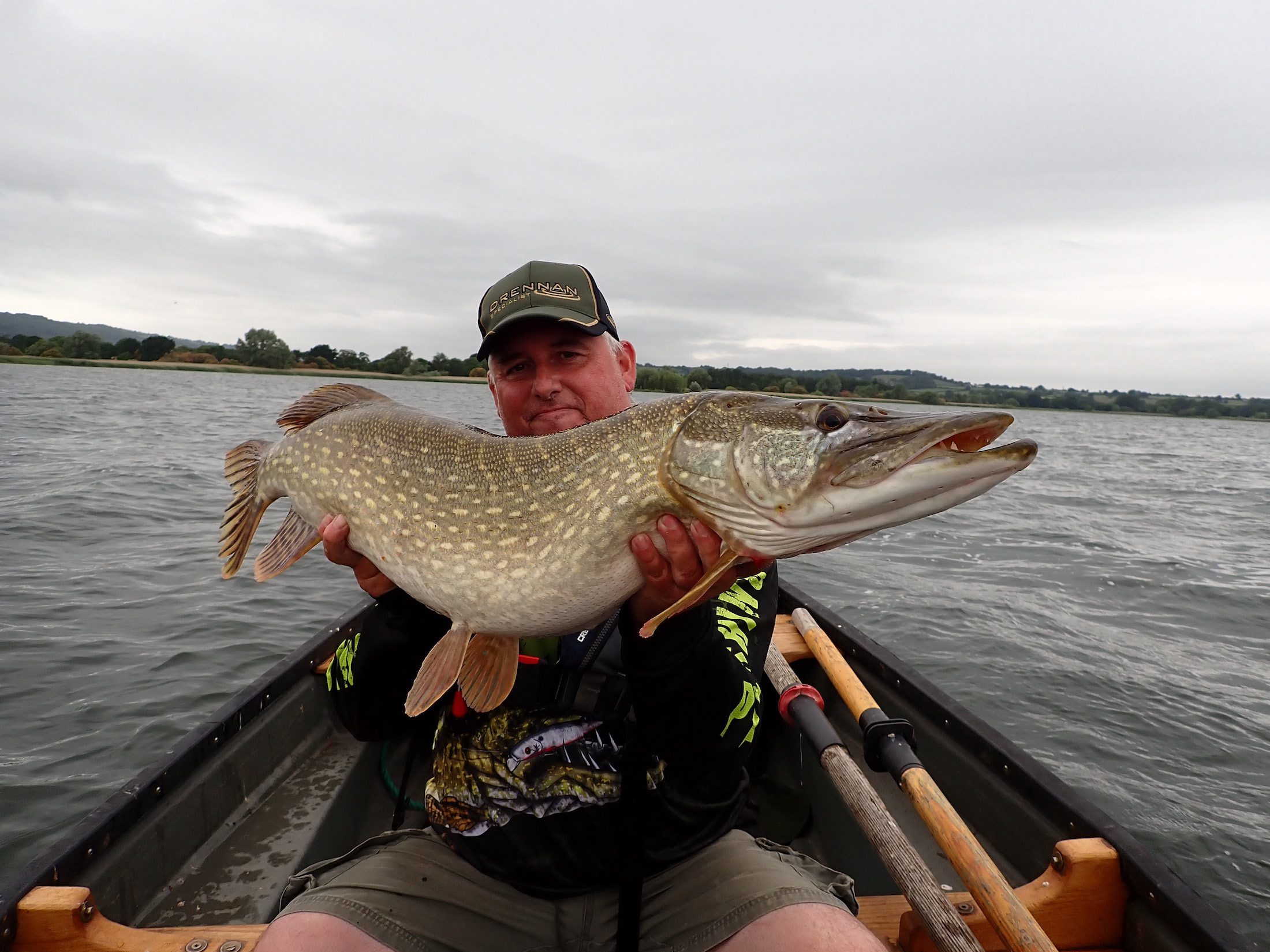
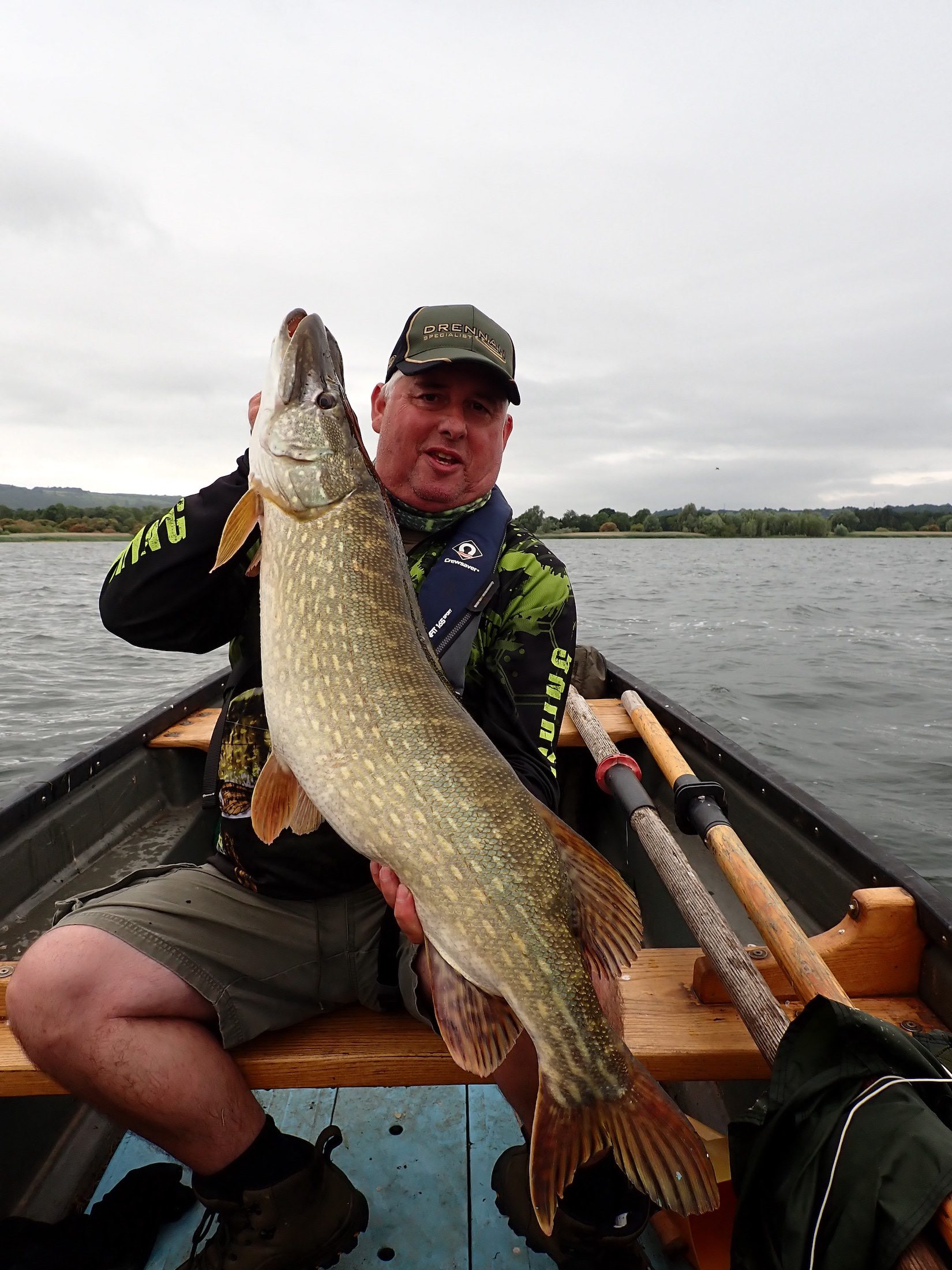
We fished on as dark clouds gathered adding a few more jacks and a low double to the total. The tally when we packed up shortly after 6:00pm was 23 pike. A fine day’s fishing by any standard. We will be back in the autumn once again to continue chasing dreams and perhaps catching them.
